

Check rates for our recommended hotels
- Book Hotels
Subscribe to our weekly newsletter
Subscribe and get our free guide to "101 Ways to Save in Europe"
* indicates a required field
Your subscription request has been received
Sorry, an error occurred and your subscription request could not be processed. Please try again later.
- See All Cities
- Advertising Info
- Customer Support
10 tips for planning a trip to the Beaches of Normandy
Aug 7, 2019
Bryan Pirolli

After commemorating the 75 th anniversary of the D-Day landings earlier this year, the Beaches of Normandy continue to welcome tourists to remember the battles that turned the tide in World War II.
Beautiful landscapes, intense history, and a sobering dose of the realities of war all blend to make a worthwhile trip away from the Parisian crowds.
The good news is it won’t break the bank if you plan appropriately.
Tips for visiting the Beaches of Normandy
Here are a few ways to save time and money on a trip to these iconic sites.
1. Give yourself plenty of time
Treat yourself and don’t try to do it in a day. Of course, if you’re pressed for time, you can visit a memorial and a beach during the day and return to Paris in the evening. It’s tough but doable.
Instead, give yourself at least one night in one of the nearby towns so that you can enjoy more of what the Normandy beaches have to offer. Two nights is even better, and hotel rates will usually be cheaper than in Paris.
Related: 8 Paris day trips less than an hour away by train
2. Getting there on the cheap
Public transportation to the beaches is reliable, but it takes time. A train to Caen or Bayeux takes about two hours. From Bayeux, true Cheapos can plan a bus route to the beaches. The line 70 of the Bus Verts , for example, takes about thirty minutes to get to Omaha Beach for just a few for euros. Plan your trip carefully because buses don’t run too often, so missing one could mean a long wait!
The best option, though it will be pricier, is to rent a car from a town outside Paris. It may cost more upfront, but you’ll be able to experience more without a potentially costly taxi ride when you miss the last bus to town.
To see more details about transportation options in Normandy, check out this local website .

Stay in Bayeux for a fairytale experience. Photo: Gaetan
3. Stay in Bayeux
There are numerous options in Bayeux for affordable stays, allowing you to use the charming town as a base for your Normandy escapades. It’s located midway between most of the major sights, making in a convenient option. The town itself has a stunning cathedral and a world-famous tapestry if you decide to stay longer. Search for hotels in Bayeux
Caen is a slightly larger town, and it sometimes has some good deals, though Bayeux is arguably a more worthwhile experience for visitors. If you’re looking for more options, you can search for hotels in Lower Normandy .
4. See the famous beaches
From east to west, the main beaches are Sword, Juno, Gold, Omaha, and Utah. Omaha Beach tends to attract more Americans since it is also home to the cemetery dedicated to fallen U.S. troops and features the cliffs where Germans defended against the Allied invasion. Each beach has its story, with memorials and museums open to the public.
It’s best to do some research on them beforehand to choose which one or two are most important to you to visit and then plan accordingly, to economize on driving time (and fuel!).
5. Don’t miss the museums and memorials
To understand the importance of each beach, there are exhibitions dotting the coastline and towns around Normandy. Some of the most famous include the Musée du Embarquement in Arromanches where the artificial port was built, Musée Mémorial de la Bataille de Normandie in Bayeux, the Le Mémorial in Caen , and the Utah Beach Landing Museum .
It will be impossible to visit every beach and museum, so, again, choose the one or two that seem the most interesting to you. If traveling with children, one might be enough.

The American Cemetery sits on top of the cliff near Omaha Beach. Photo: Neil Willsey
6. The American Cemetery is a must-see
The most famous is the American cemetery at Omaha Beach, where white marble tombs face the United States. Its visitor center was renovated in time for the 75 th anniversary of the landings in 2019. A visit here is humbling and free, but it’s not the only cemetery worth visiting. British, Canadian, and German cemeteries also line the coast, like the Bayeux War Cemetery , home to over 4,000 Commonwealth troops.
There are dozens to visit, some containing only a few tombs while the American cemetery has nearly 10,000 graves.
7. Take a tour
While ParisCityVision does offer day trips from Paris, consider booking a local guide once in Normandy. Some companies like Normandy Sightseeing Tours offer half and full-day options but get creative with your Googling for other options that might be more intimate or budget-friendly.
The value of a guide is that you’ll be able to learn about the beaches, bunkers, and other sights that you may otherwise just look at without truly understanding what happened.
8. Study your history
If you’re going the true cheapo route and bypassing a guide, then do yourself a solid and study up on the importance of the beaches before going. Those who are unfamiliar with what happened along the Normandy coast may have difficulty understanding the significance of these beaches.
It would frankly be a waste of time to rush out for the photo op without taking a moment to appreciate the fallen soldiers and all that happened on these pristine sandy shorelines.
Related: 10 ways to prepare for your trip to Paris
9. Bag that lunch
A classic tip for any trip around France, be sure to bring your lunch. Fantastic baguette sandwiches and pastries at the local bakery in Bayeux, for example, are affordable and fantastic alternatives to spending time in a mediocre café somewhere on the road.
We’d rather nibble a €3 jambon beurre (ham and butter sandwich) while overlooking the crashing waves than sitting in a roadside cafeteria, wouldn’t you?
10. Make an easy detour to Mont Saint Michel
While going to the Normandy Beaches is an experience unto itself, consider stretching the trip even longer and driving to nearby Mont Saint Michel , an hour and a half drive from Bayeux. It’s not related to the WWII landings, but if you’re halfway there, it would be a shame to miss one of France’s most iconic tourist sights.
Have you been to the Beaches of Normandy?
We would love to hear your experiences on what you saw and how you got there. Share your favorite tips in the comments below!
About the author

About the author: A journalist and tour guide, Bryan makes it his mission to cover Paris from top to bottom. He has also successfully defended a PhD in travel communication at Sorbonne Nouvelle, giving him some more street cred. Bryan regularly travels on a budget, experiencing the best of European culture while still trying to make rent. So far, so good. You can follow his adventures on his blog: www.bryanpirolli.com .
Related Posts
- Paris: 7 favorite day trips and overnight getaways
- A World Apart: Rome’s English Cemetery
- Our 6 favorite budget beaches in Europe
- Three stunning London cemeteries
Leave a Reply Cancel reply
Your email address will not be published. Required fields are marked *
Notify me of follow-up comments by email.
Notify me of new posts by email.
5 thoughts on “10 tips for planning a trip to the Beaches of Normandy”
I am planning a 2024 trip. My son does WWII re-enacting and his unit has to be on Omaha Beach on June 29th. He will be staying where our soldiers stayed and eating K rations, my question is where do I need to fly into from Utah, USA?Paris? Also, we want to include Bastogne and the Ardennes Forest. Any suggestions? Thanks
Thank you so much for this article. We are planning our trip for this summer and didn’t know where to start. Now I do!!!!!
Thank you for this terrific information. I have been thinking of staying over in Bayeux and thought about getting a local guide to the Normandy beaches from there. It is a very long trip from Paris, especially when weather or traffic accidents cause “les bouchons” so I think the train is much more relaxing choice from Paris, I think Gare St. Lazare…
Thanks for the great tips, Bryan.
I have taken 25+ trips to the Normandy Invasion Beaches through my company, The Traveling Professor’s Small Group Tours. If going to the Normandy Invasion Beaches, I strongly urge travelers to NOT take one of those big bus tours. Big vehicles simply cannot get down to beaches like “Easy Red” and “Dog Green” where the toughest battles, like the one depicted in “Saving Private Ryan” took place. Small group tours also can visit special places, like the privately owned and perfectly intact Hillman Bunker. Big bus tours can’t get there. Lastly, with a smaller tour, travelers have more input on how much time to spend at a particular place. Big bus tours are on a schedule -their schedule, not yours.
Yeah I would agree on the big bus tours. Our guide was very knowlegeable but way too fast paced. We were rushed from place to place. Not much time to meditate on what happened there when the guide is rushing you off to the next site. If you have to do the big bus due to cost, try to do a two days tour. But if I had to do it over again, I would have chosen a smaller tour group. Unless you are a real history buff, I don’t recommend doing the beaches on your own. It’s too spread out. And everything shuts down at 5.
Book Your Trip
Search our blog:, destinations.
- Aix-en-Provence
- – Free Paris
- – Paris Eating and Drinking
- – Paris Hotels
- – Paris Nightlife
- – Paris Outdoors
- – Paris Performance and Events
- – Paris Planning
- – Paris Shopping
- – Paris Sights
- – Paris Transportation
- Northern Ireland
- – Florence Eating and Drinking
- – Florence Practical Info
- – Florence Sightseeing
- – Rome Eating and Drinking
- – Rome Hotels
- – Rome Practical Info
- – Rome Sights
- – Venice Eating and Drinking
- – Venice Hotels
- – Venice Practical Info
- – Amsterdam Sights
- – Barcelona eating
- – Barcelona hotel advice
- – Barcelona planning
- – Barcelona sightseeing
- – London eating
- – London hotel advice
- – London neighborhoods
- – London sightseeing
- – London transportation
- – Brooklyn
- – New York hotel advice
- – New York neighborhoods
- – New York planning
- – New York sightseeing
Read more about: France

Find us on Facebook
About eurocheapo.
Since 2001, our mission has been to make your time in Europe affordable and memorable. The world is out there, and it’s less expensive than you think.
© 2024 by Over There Interactive, Inc. All Rights Reserved. Privacy Policy
EuroCheapo Cities
Finding the Universe
Travel tales, photography and a dash of humor
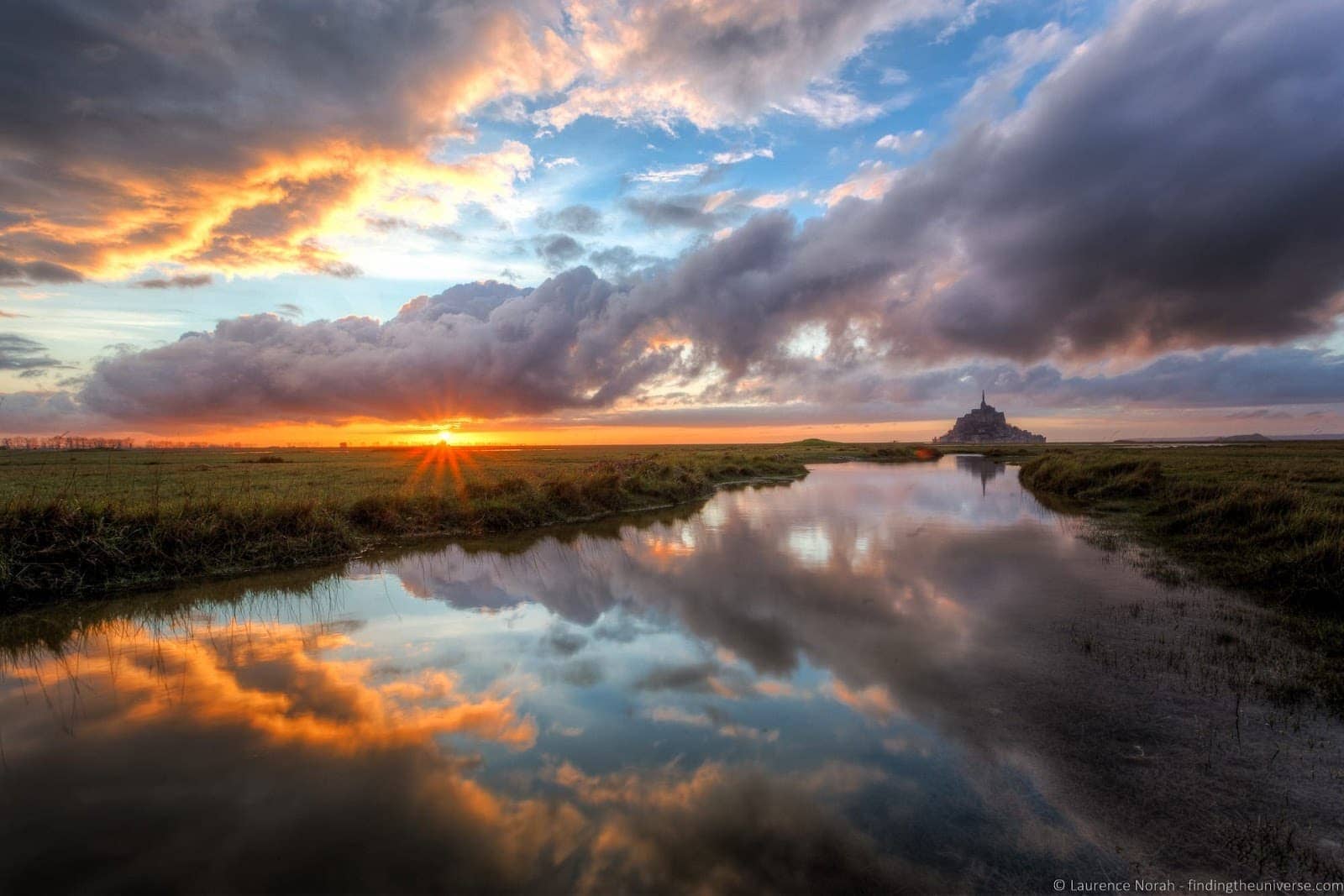
2 Days in Normandy: The D-Day Landing Beaches & Mont St. Michel
Last updated: April 19, 2024 . Written by Laurence Norah - 35 Comments
Despite living in France for three years, I didn’t do much sight seeing. So when the opportunity arose to spend 2 days in Normandy, visiting Mont St. Michel and the D-Day Landing beaches in the north-west of the country, we leapt at it.
We didn’t have a great deal of time to play with as we were visiting my parents further south in France, but we gave ourselves a couple of days in Normandy, basing ourselves near Mont St. Michel, with the aim of exploring both that and the Normandy D-Day Landing Beaches.
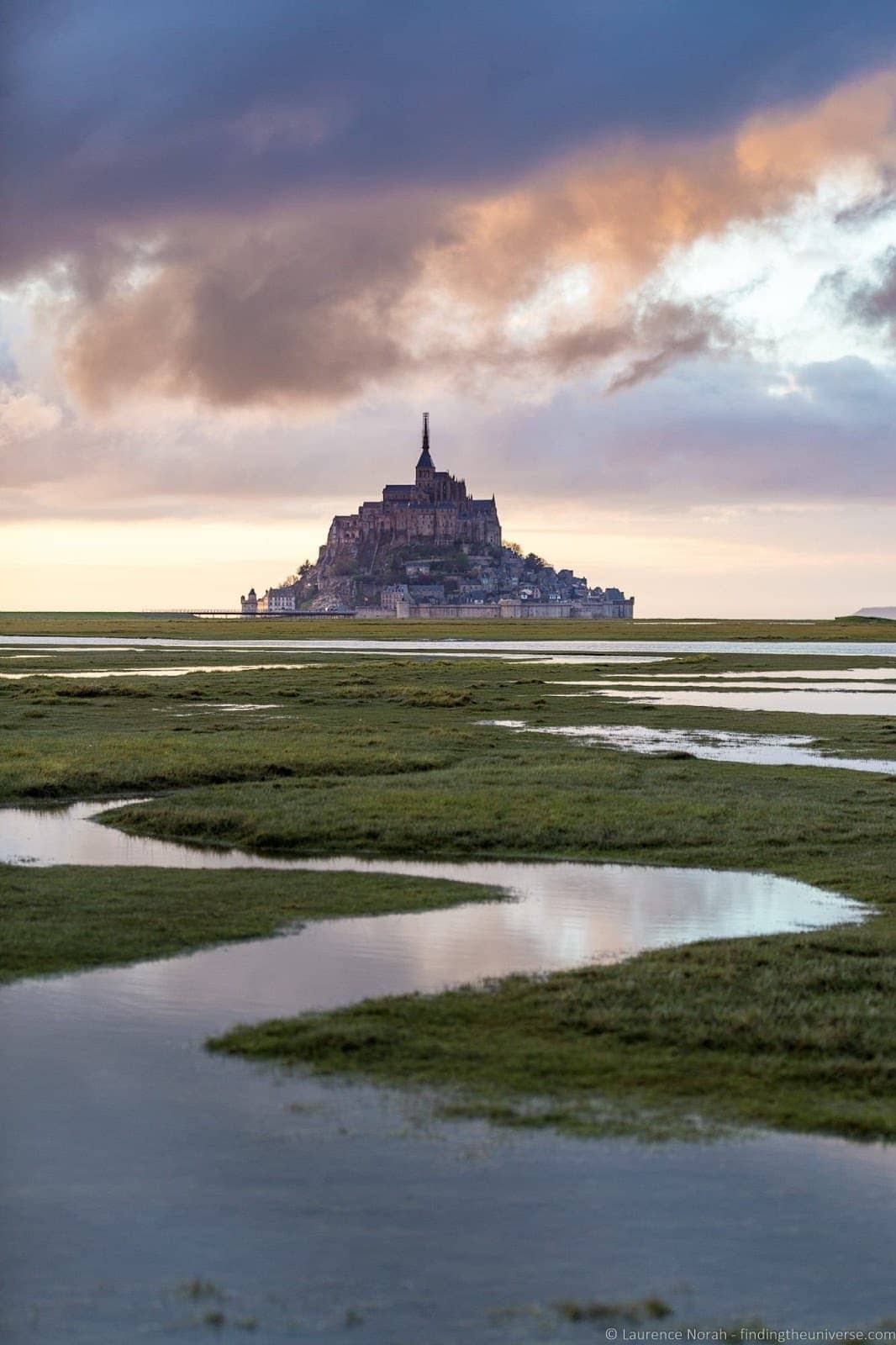
Which was what we did. In this post, we’re going to share everything you need to know to spend two days in Normandy, including some tips on where to stay.
We’ve also put some tour options together in case you don’t want to do this all yourself. The closest tour to the itinerary we have described is this one , which departs from Paris, but we have a number of options including tours departing from Bayeux.
Now though, let’s get started with our guide to exploring the Normandy Landing beaches and Mont St. Michel over two days.
2 Days in Normandy
Day 1: visit mont st. michel.
When we visited Mont St. Michel and the D-Day beaches we were travelling from the UK. We took the overnight ferry with Brittany Ferries from Portsmouth to St. Malo. This meant that we had a good night’s sleep, arriving into France at around 9am local time.
Our guest house was an hour’s drive from St. Malo, and they were fine with us arriving early, so we did just that. After dropping our belongings off and parking the car, our first day was largely spent exploring Mont St. Michel.
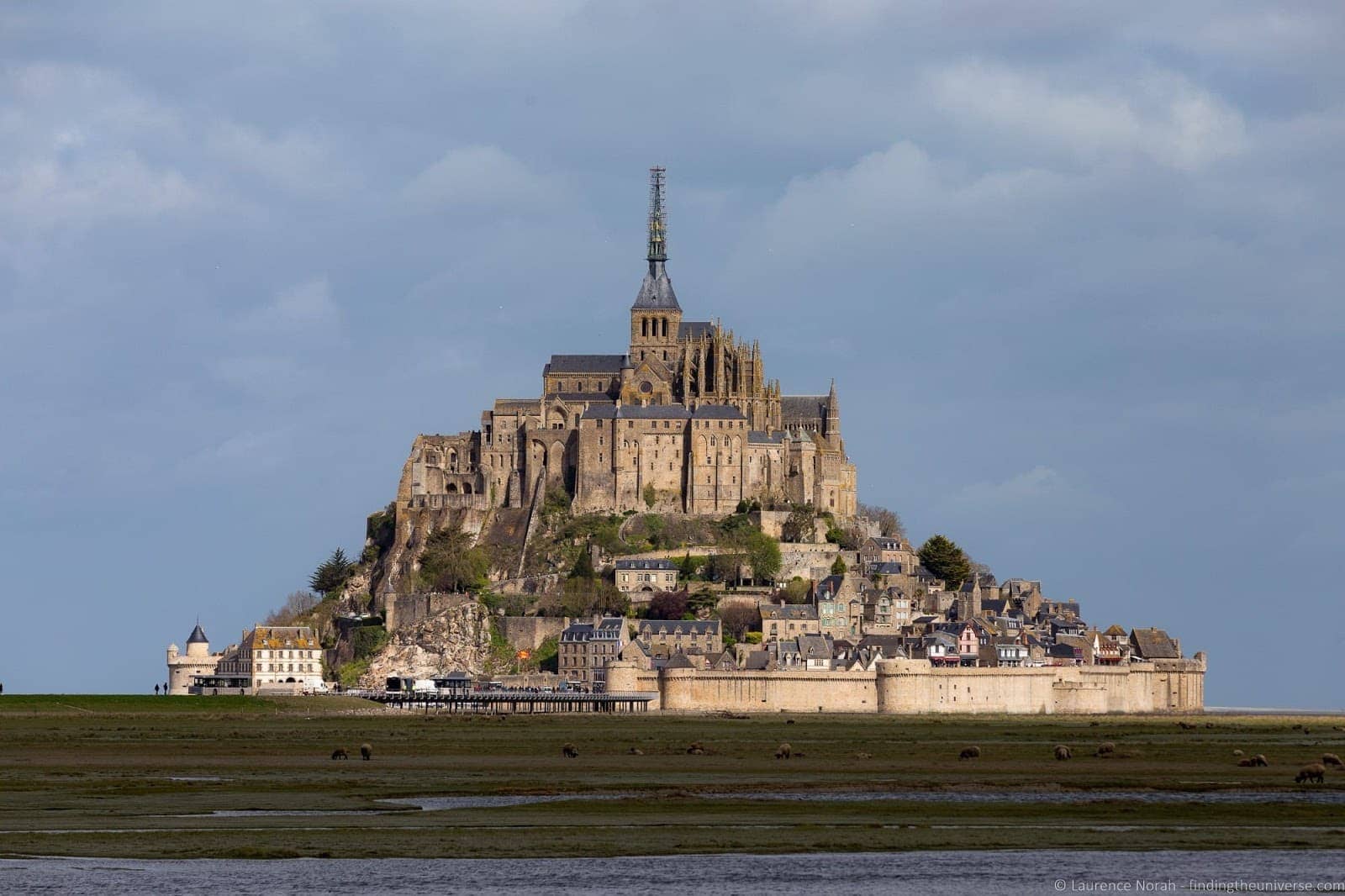
This was, very conveniently, within walking distance of our guest house . This is a handy tip – if you’re going to stay near Mont St. Michel, stay within walking distance.
There’s no way to drive to the island on your own, and if you park there’s a daily fee for doing so (unless you park in the evening when it becomes free). And I’m sure you’d prefer to spend that money on a nice bottle of local cider, or a few glasses of wine, like we did.
There is a causeway to the island, and a free shuttle bus runs from the car park to the island. However, I’d suggest that for your first visit, you walk all the way to the island. The views are gorgeous all the way, and you can really appreciate the magnificence of the island as you get closer to it. Then, you can get the shuttle bus on the way home!
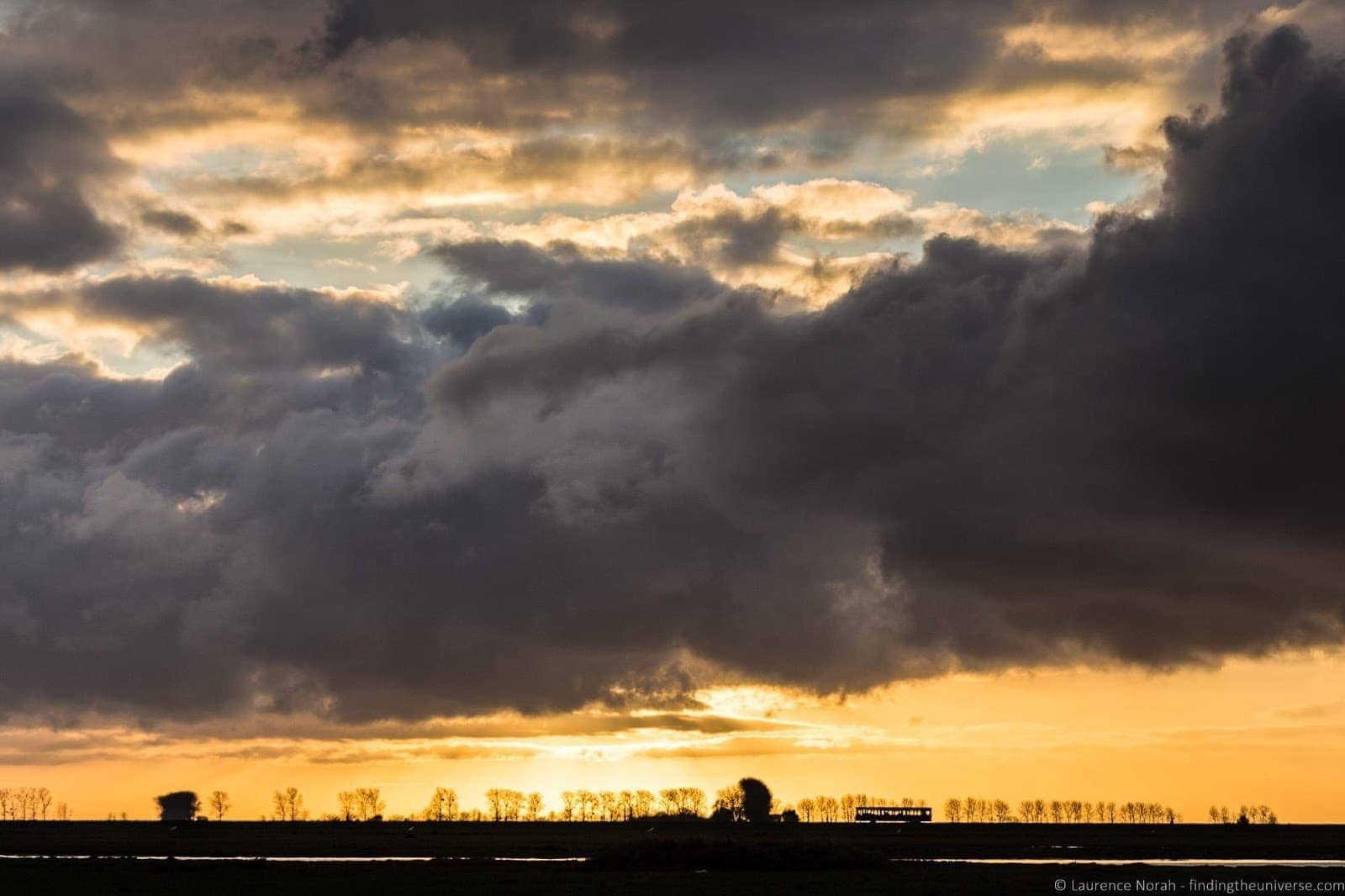
The island itself had more on it than I was expecting. There’s a whole village, with shops, two ATM’s, a number of restaurants and of course, plenty of places to buy souvenirs from your visit. There are even hotels on the island, so you can stay over and enjoy Mont St. Michel when the crowds dissipate for the night.
Speaking of crowds, the streets are narrow, so it can get crowded. We visited on a less busy than average day, and it still got tight in places, so I imagine that in summer it must be very busy!
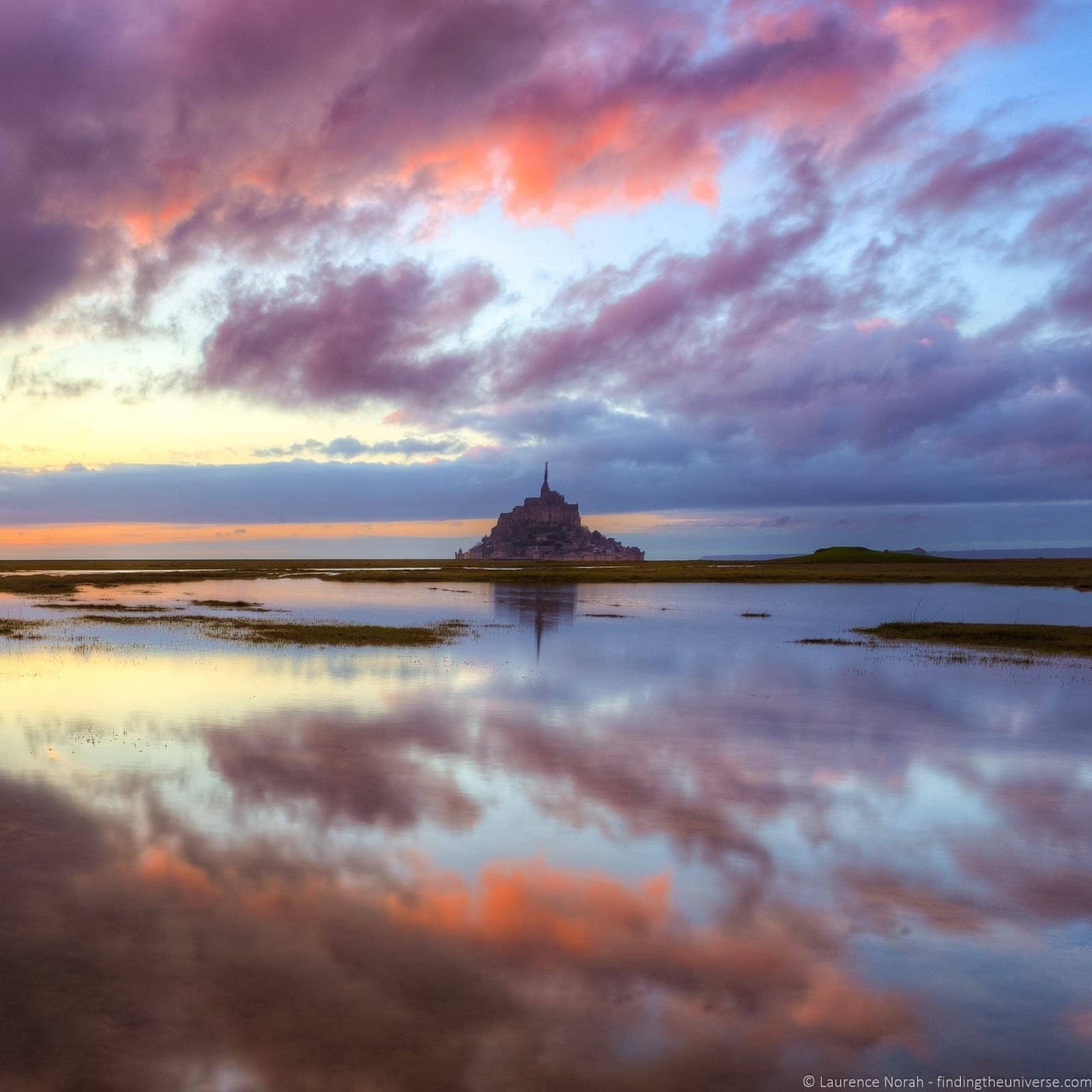
After stopping for lunch (many places do a menu of the day option for €17 – €20), we followed the street up to the Abbey which crowns the hill. This is the key point of pilgrimage for visitors, and the focal point of the island.
It’s not free to visit the Abbey, with opening hours varying depending on the season. Check the latest opening hours and prices here .
We suggest buying your ticket in advance online here to skip the queues. The online price is the same as buying it in person.
The good news is that entry includes an hour-long guided tour. Tours depart somewhat regularly and are offered in both French and English.
Obviously, we went for the English language option, and had a wonderful tour that taught us about the history of the abbey, the key events that led to its construction and look today, as well as the function of many of the rooms.
If you visit, I’d very much recommend taking the tour to learn a bit about the place. But if there is not a tour going during your visit, you can also purchase an audioguide or just do a self-guided tour with the free leaflet included.
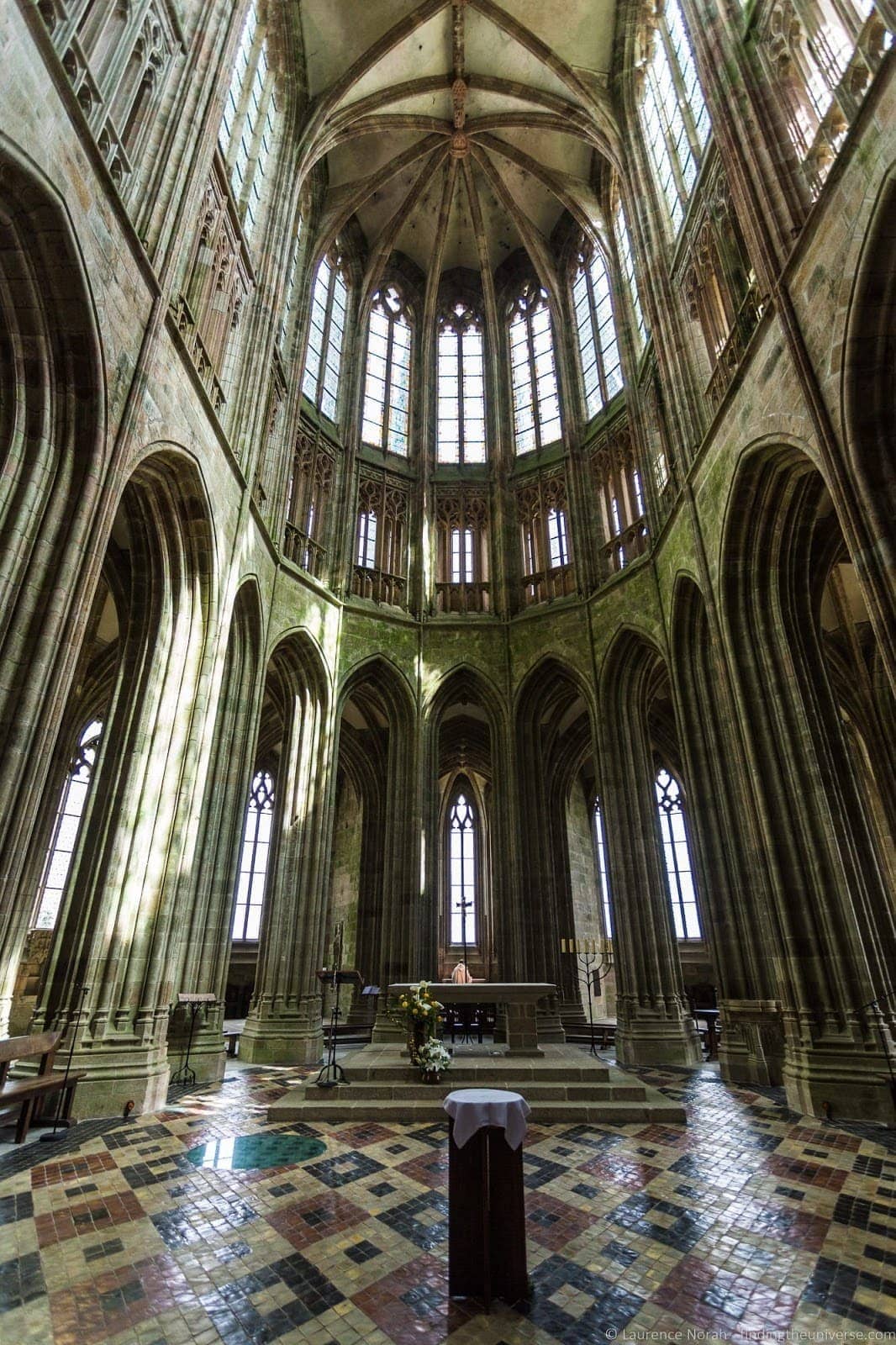
Finally, once the tour was over, we headed out of the abbey and took the bus back to the mainland, where we had a spot of dinner accompanied by some excellent Normandy cider.
I then spent the evening capturing the sunset over the Mont, which was just gorgeous. So good in fact that I went the next night as well!
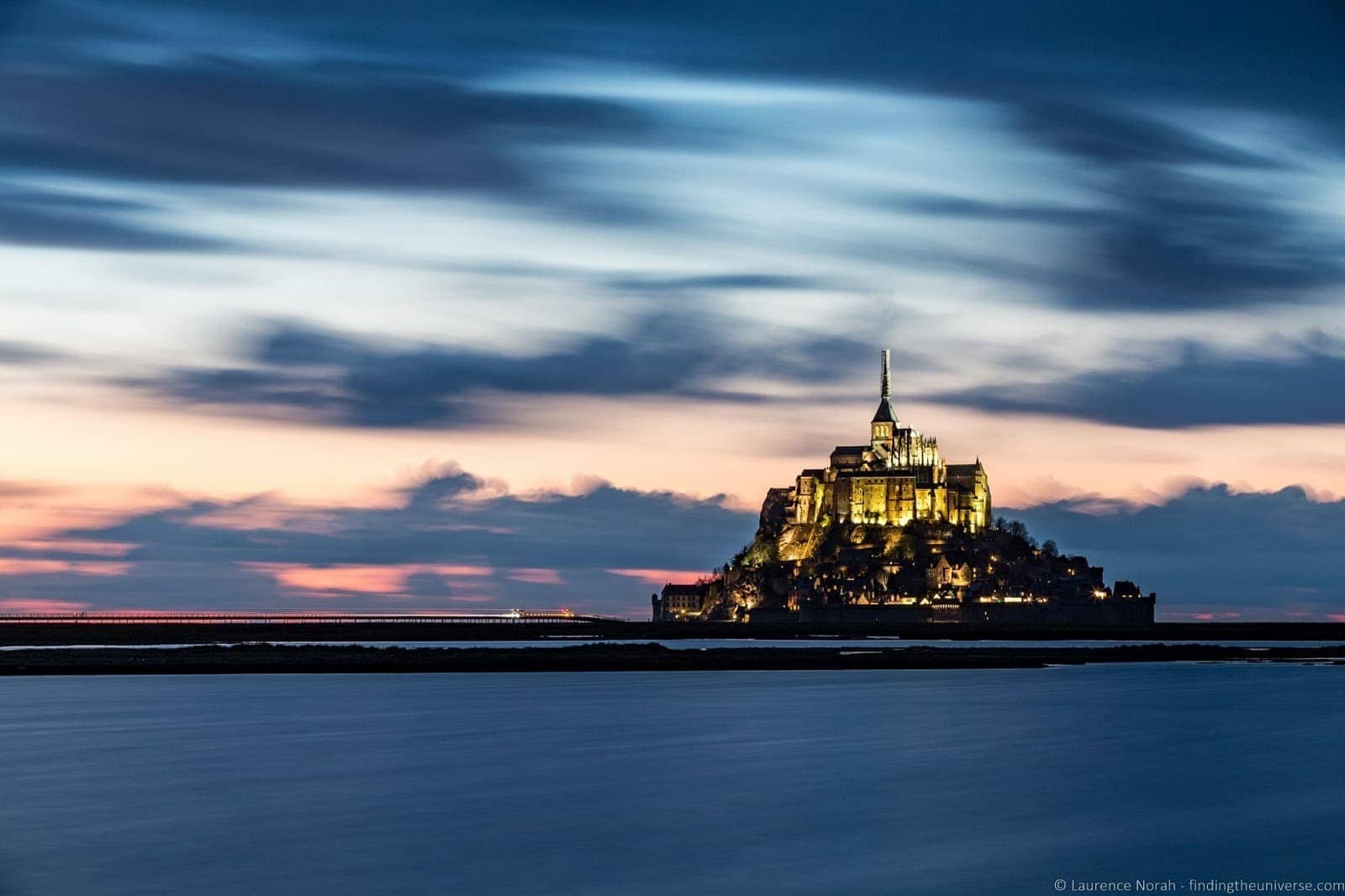
Day 2: Visit the D-Day Normandy Landing Beaches
Our second day in Normandy was a busy one. Having had a full day to explore Mont St. Michel at our leisure, we set ourselves the challenge of visiting some of the D-Day landing beaches in France.
There are quite a variety of sights, museums, memorials and attractions to visit, but we only had a day, so put together an itinerary that we felt was going to give us a good overview of the area and history. Here’s what we did, which we think makes for a good day of exploring the D-Day landing beaches and museums.
1. Utah Beach & Utah Beach D-Day Museum
We started by visiting Utah beach, where there is an excellent D-Day museum dedicated to the landings at Utah Beach.
From our research, this was indicated to be one of the best D-Day landing museums, and even though time meant we didn’t visit any of the others, it was certainly an excellent way to start our journey.
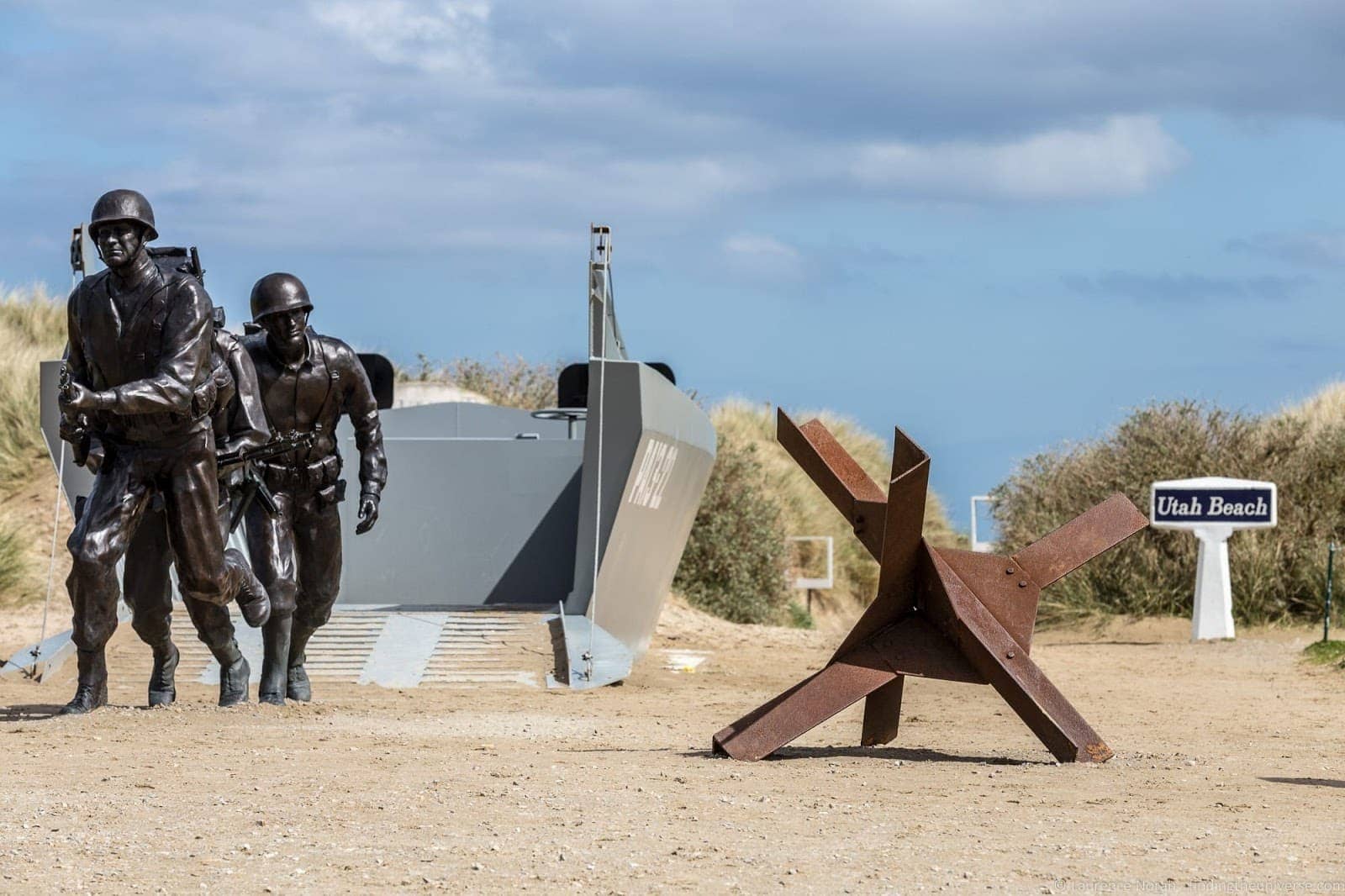
With a focus on the events at Utah Beach specifically, one of the US landing beaches, the museum went over the key highlights of 6th June 1944, including the planning leading up to it, and the story of the day itself.
There was an excellent video about the day, oral histories as well as objects and vehicles that were used.
Most impressive of these is an original B-26 bomber, one of six surviving in the world, and of the same type as those used during the bombing runs that happened in the moments before the men landed on the beach.

We then spent some time on the actual beach, and viewing the various memorials. It’s hard to really visualise what it must have been like here all those years ago, and I have to say that visiting the museum was a really worthwhile way to get a really good overview of how it was.
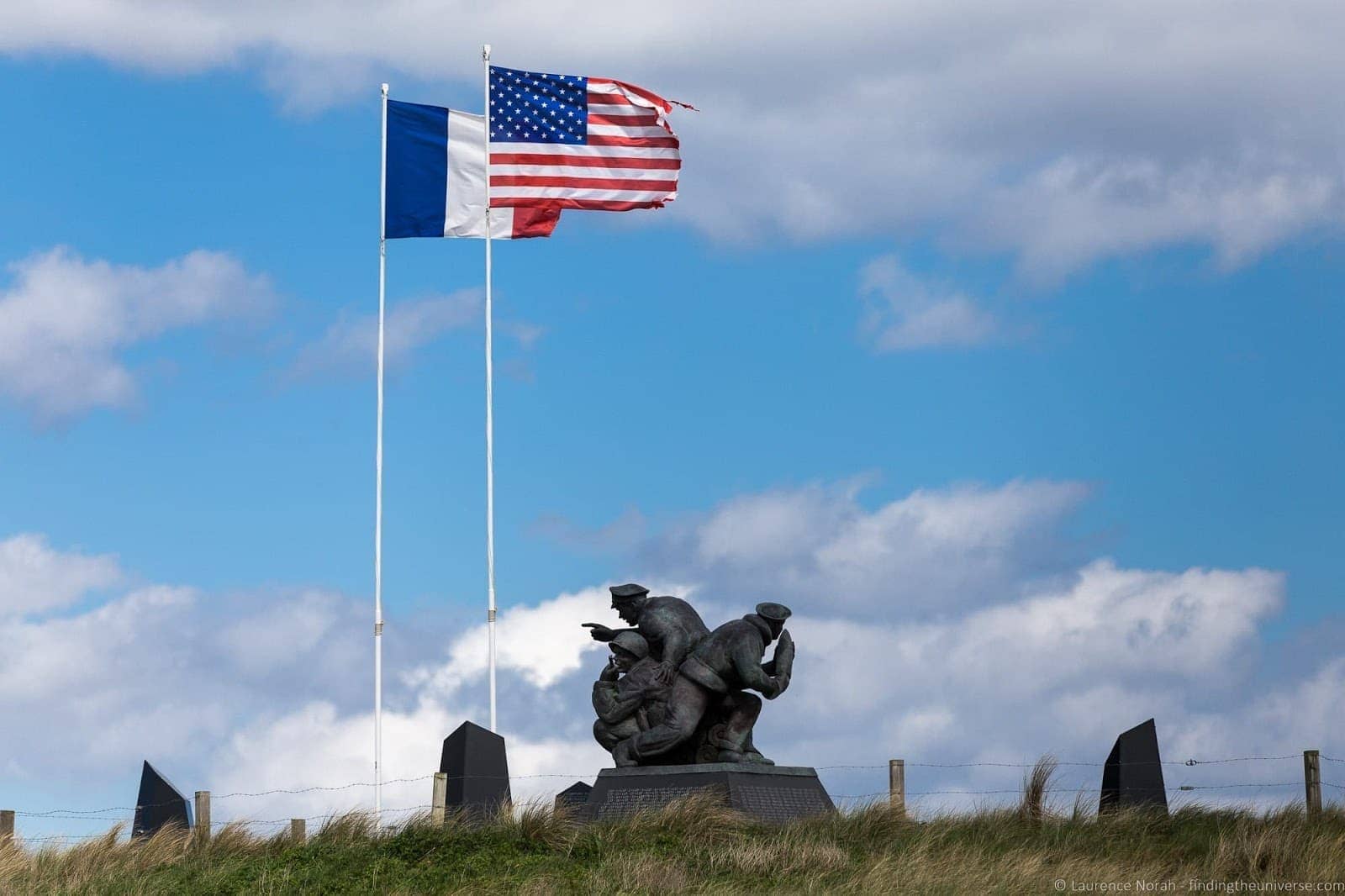
We then had a break for lunch in the wonderful Le Roosevelt Cafe, built around a bunker which housed a German communications center. Then, we headed on to:
2. Normandy American Cemetery and Memorial
Found in Coleville-Sur-Mer, and managed by the American Battle Monuments Commission, the Normandy American Cemetry and Memorial is the final resting place of over 9,000 US military personnel, the majority of whom lost their lives either during the D-Day landings, or in the days and weeks following the landings.
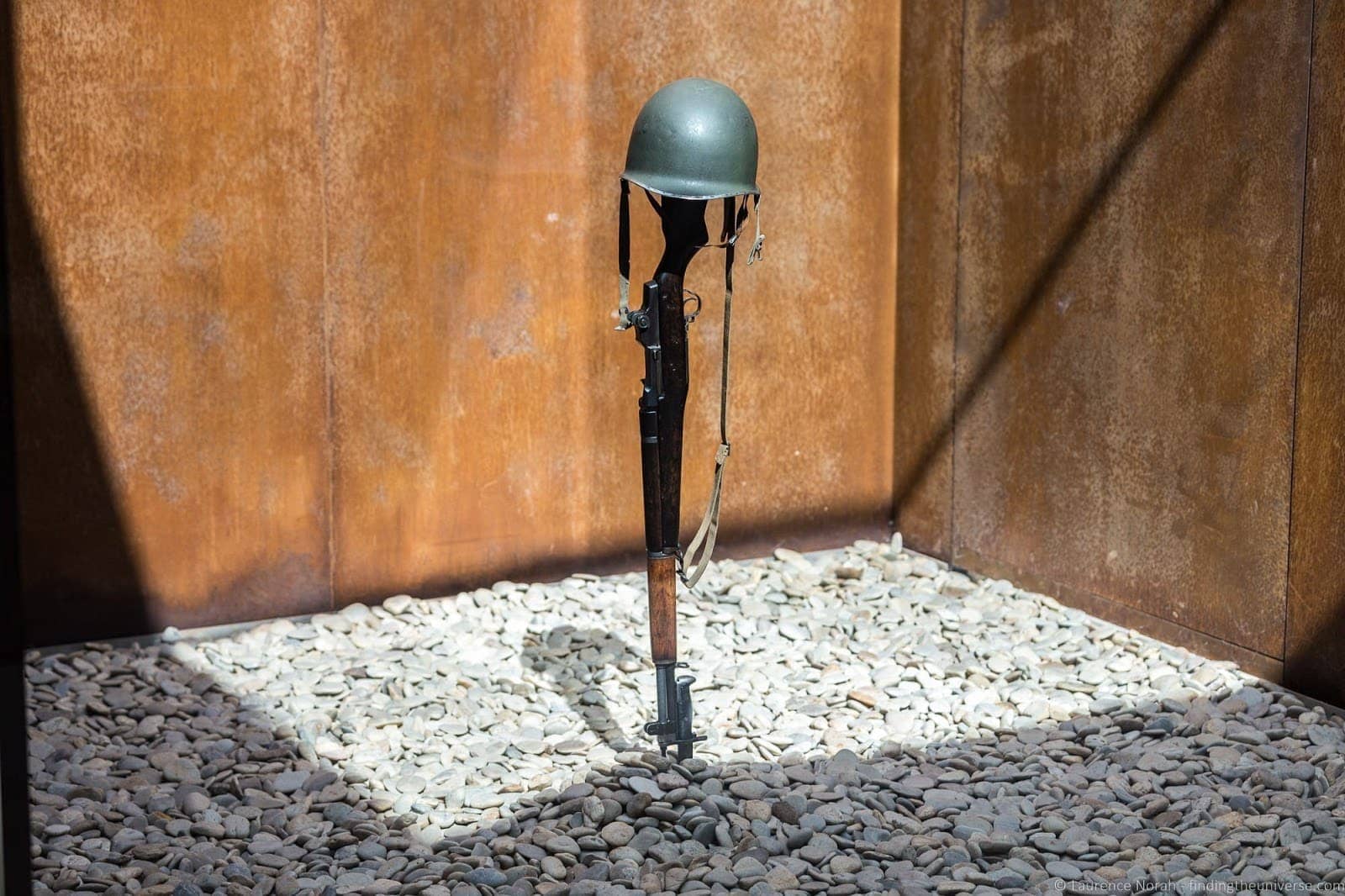
It was the first US WW2 cemetery on European soil, and was established as a temporary location on the 8th of June – two days after the landings started – a necessity given the high casualty rates, particularly at nearby Omaha Beach, which was the most heavily defended of all the landing locations.
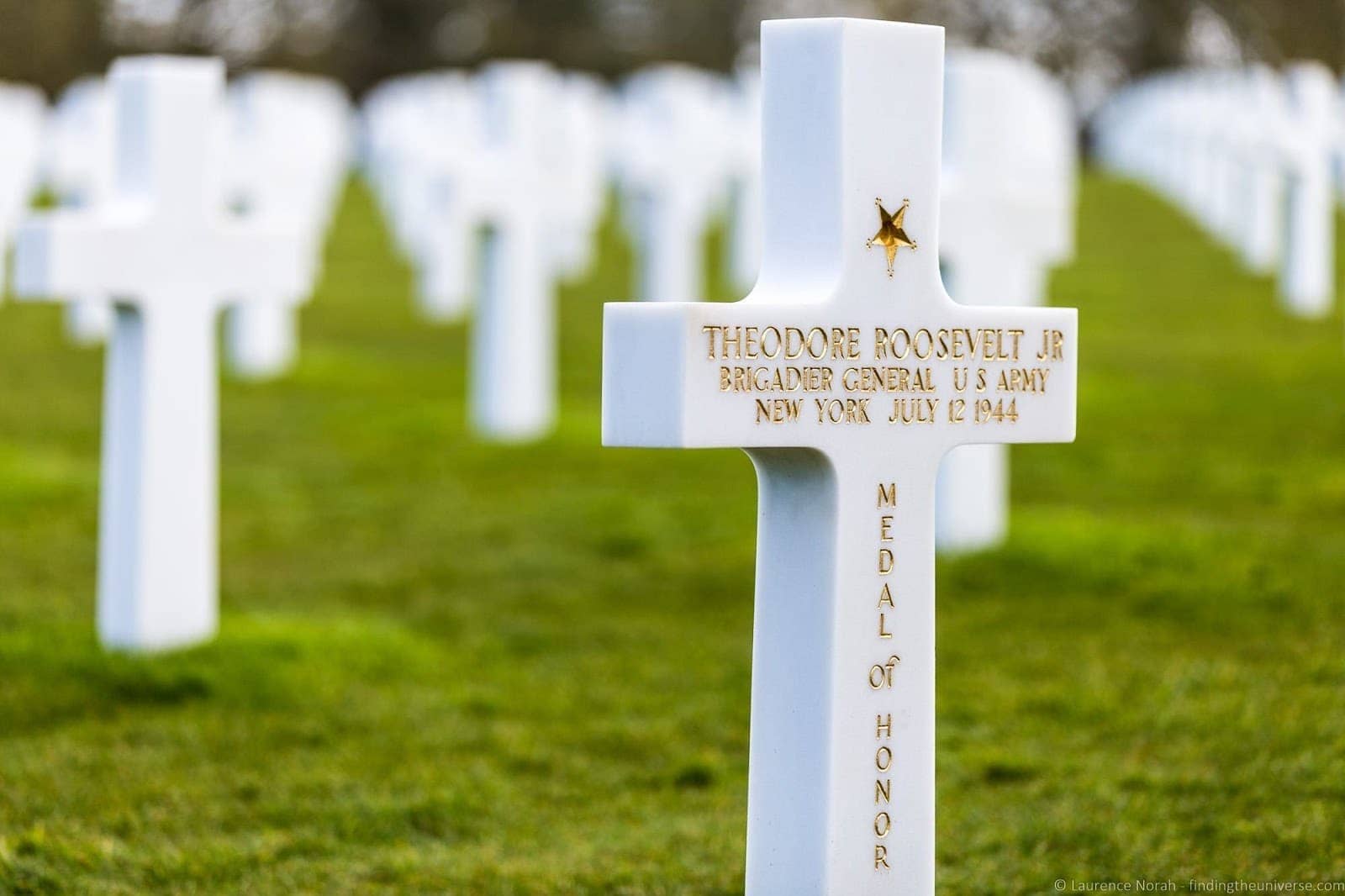
Today, there is a visitor center, a memorial, chapel, and of course, the cemetery itself, all of which are free to visitors.
The visitor center is excellent, telling the story of the landings with a focus on the personal stories and losses of the people involved, particularly at Omaha beach.
It’s very worth taking some time to fully explore this. Then, of course, the cemetery is a sombre reminder of quite how many people died in this conflict.
3. Omaha Beach Monument
From the War Cemetery we headed back down to Omaha Beach itself, and the monument to the D-Day landings.
There are actually two installations here – the huge monument itself, and a huge stainless steel art installation known as “The Braves”, which commemorates the 60th anniversary of the landings.
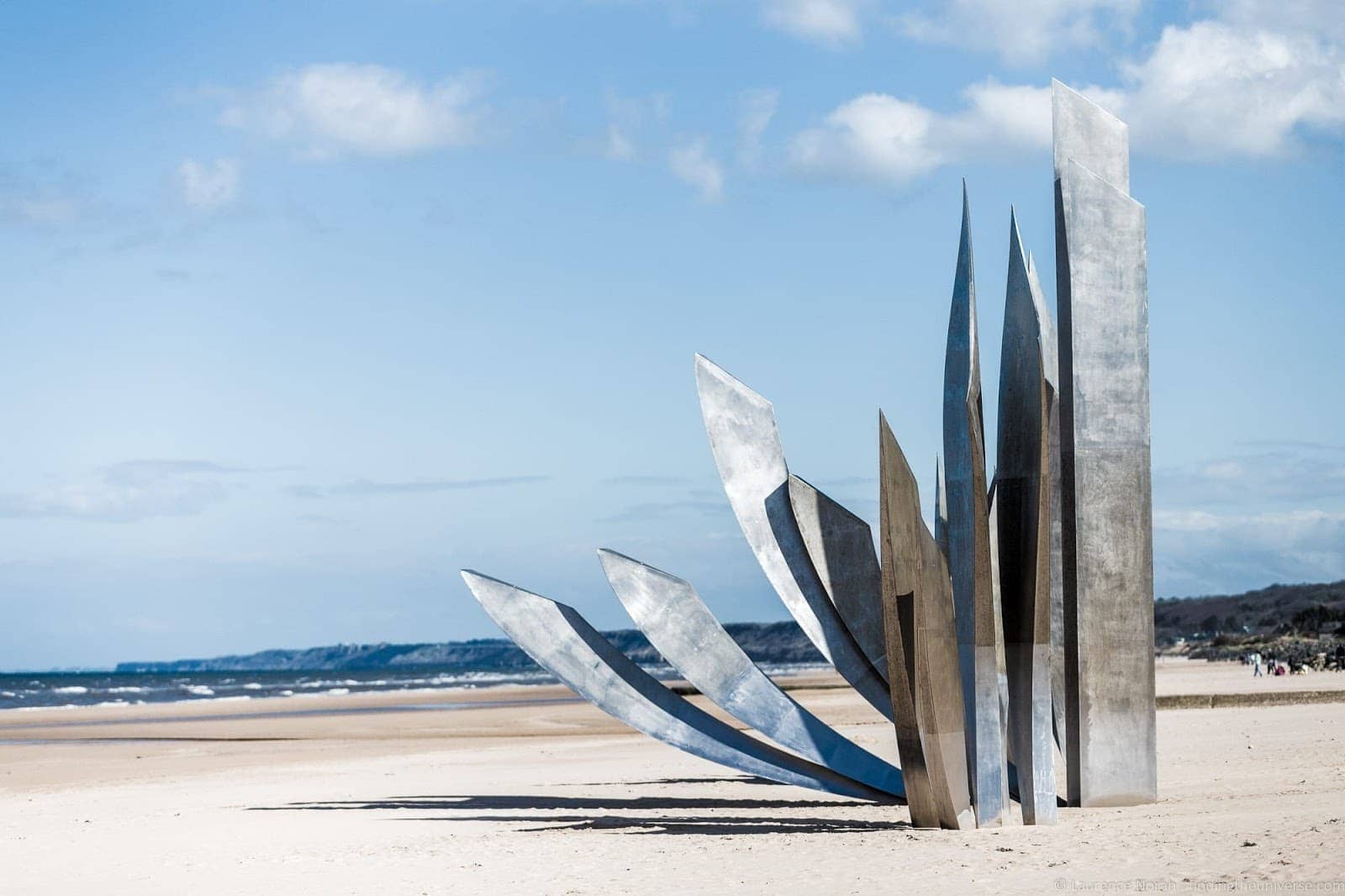
Both are worth looking at, and of course, you’ll want to spend some time here on the beach as we did, casting your mind back across the decades, and just trying to get a tiny idea of the horrors that were witnessed here.
4. Pointe Du Hoc
Our last stop on our D-Day Landings Day was Pointe Du Hoc. This is a rocky cliff top area, the highest point of land between Utah and Omaha beaches, and during WW2, was a heavily defended German installation and lookout point.
It was thought that the destruction of this stronghold was going to be critical to the success of the D-Day landings, as the six 155mm guns that were believed to be installed here could have wreaked devastation on forces landing at both Omaha and Utah beaches.
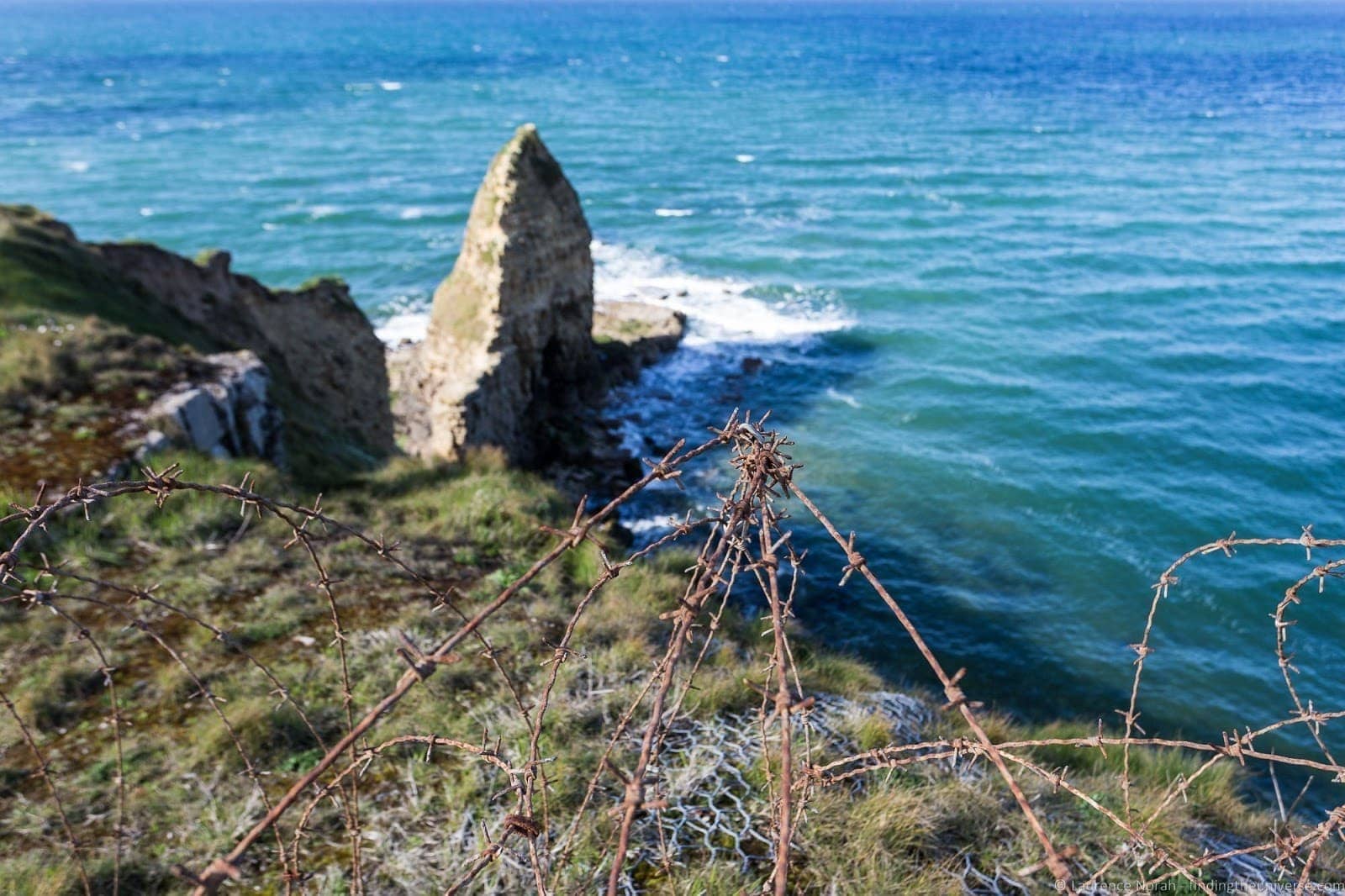
To accomplish this mission, a 225 strong force of US Rangers was dispatched in the early hours of June 6th, with the mission of scaling the 100ft cliffs and destroying the 155mm guns.
As it turned out, the guns had all been moved to a nearby orchard to protect them from Allied bombardments, so whilst the rangers did find them and destroy them, the risk was not as great as first thought. The battle for Pointe Du Hoc was also costly, with 70 percent casualties, so even though deemed a success, it was with a brutal loss of life.
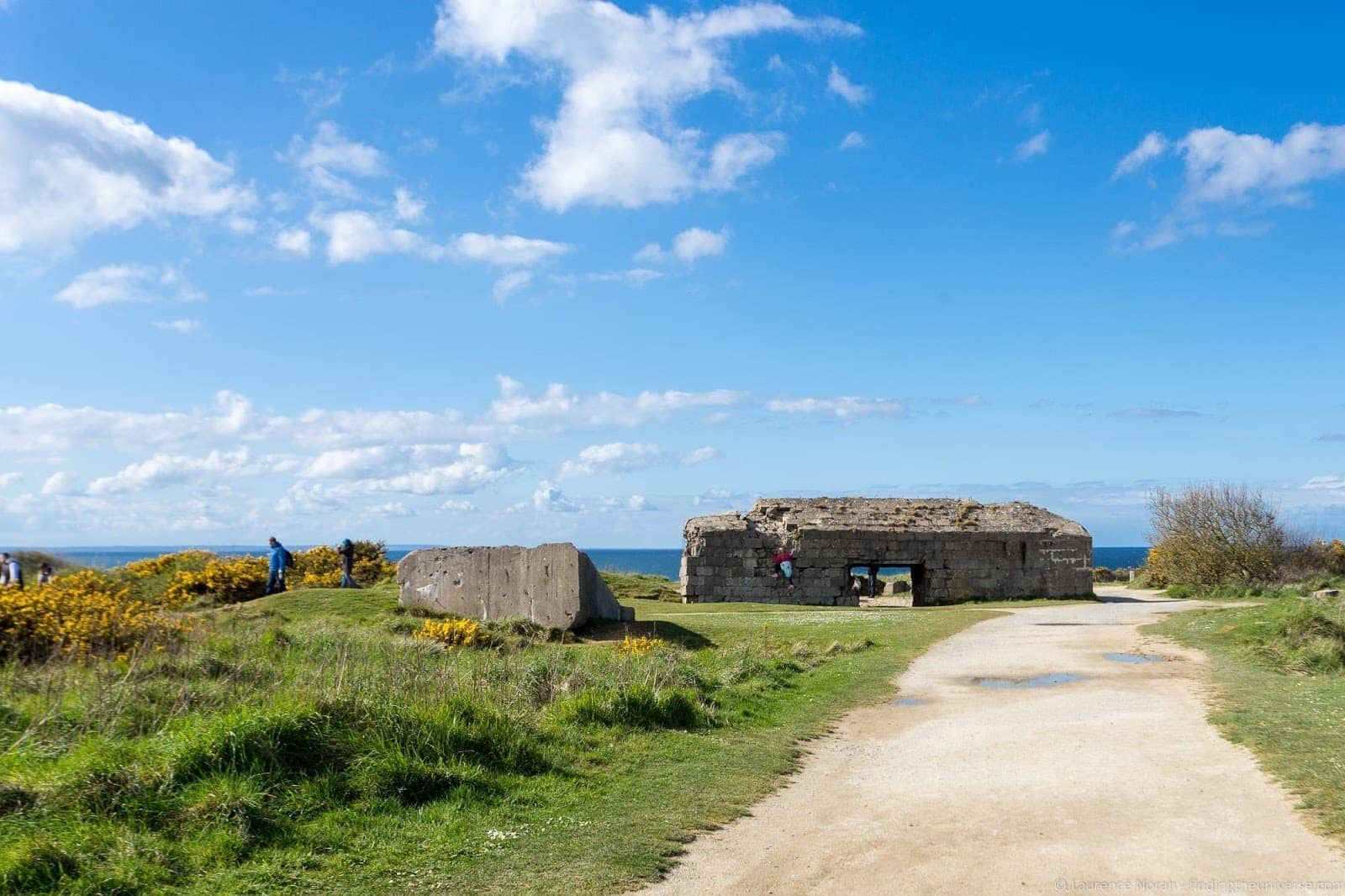
Today, Pointe Du Hoc serves as a monument to the Rangers who fought here. Other than the encroachment of nature, the site is not much different today to how it was when the Rangers landed.
Many of the original concrete bunkers, bomb craters and installations are still in place, and you can freely wander the area, and marvel at the challenges that must have faced the men landing here, from the rough seas to the 100ft cliffs to the barbed wire.
There is also a visitor centre, although it had just closed when we arrived. If it is something that interests you though, you can check the opening hours here to be sure that you schedule your day appropriately.
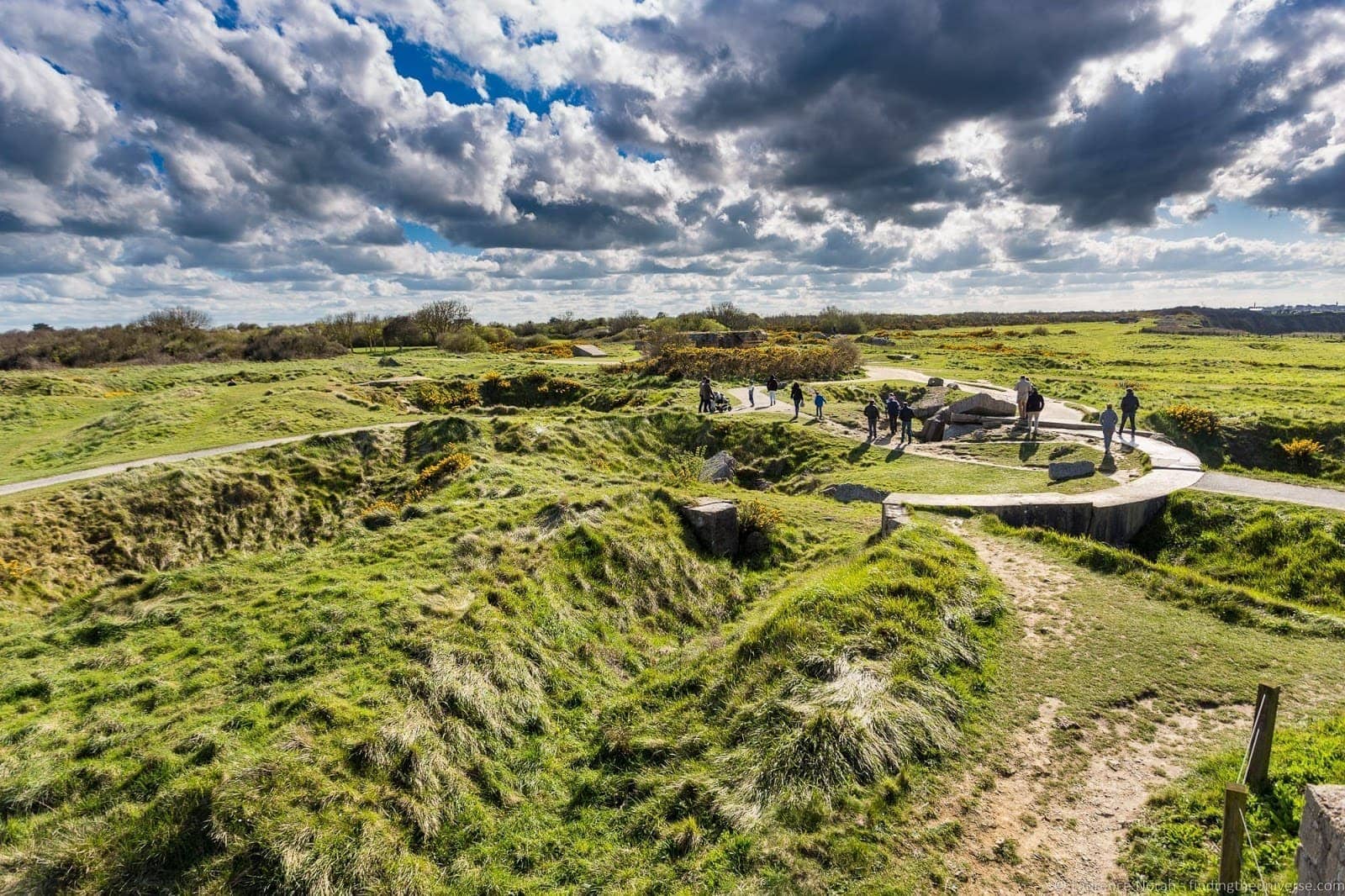
Pointe Du Hoc was the last stop on our tour of the Normandy D-Day beaches. It wasn’t the sort of day that fills you with joy, but I certainly learnt a great deal, and left with a heightened sense of admiration and respect for the many people who gave their lives so Europe and the world could be free.
Now, on to answering some questions you might have, as well as some practicalities.
Where we stayed in Normandy
There are lots of options for accommodation at Mont St. Michel. We found ourselves a little chambre d’hote , which is the French equivalent of a B&B.
This was excellent value, and within walking a half hour’s walk of Mont St. Michel – and more importantly, a ten-minute walk to where I was able to get photos like this:
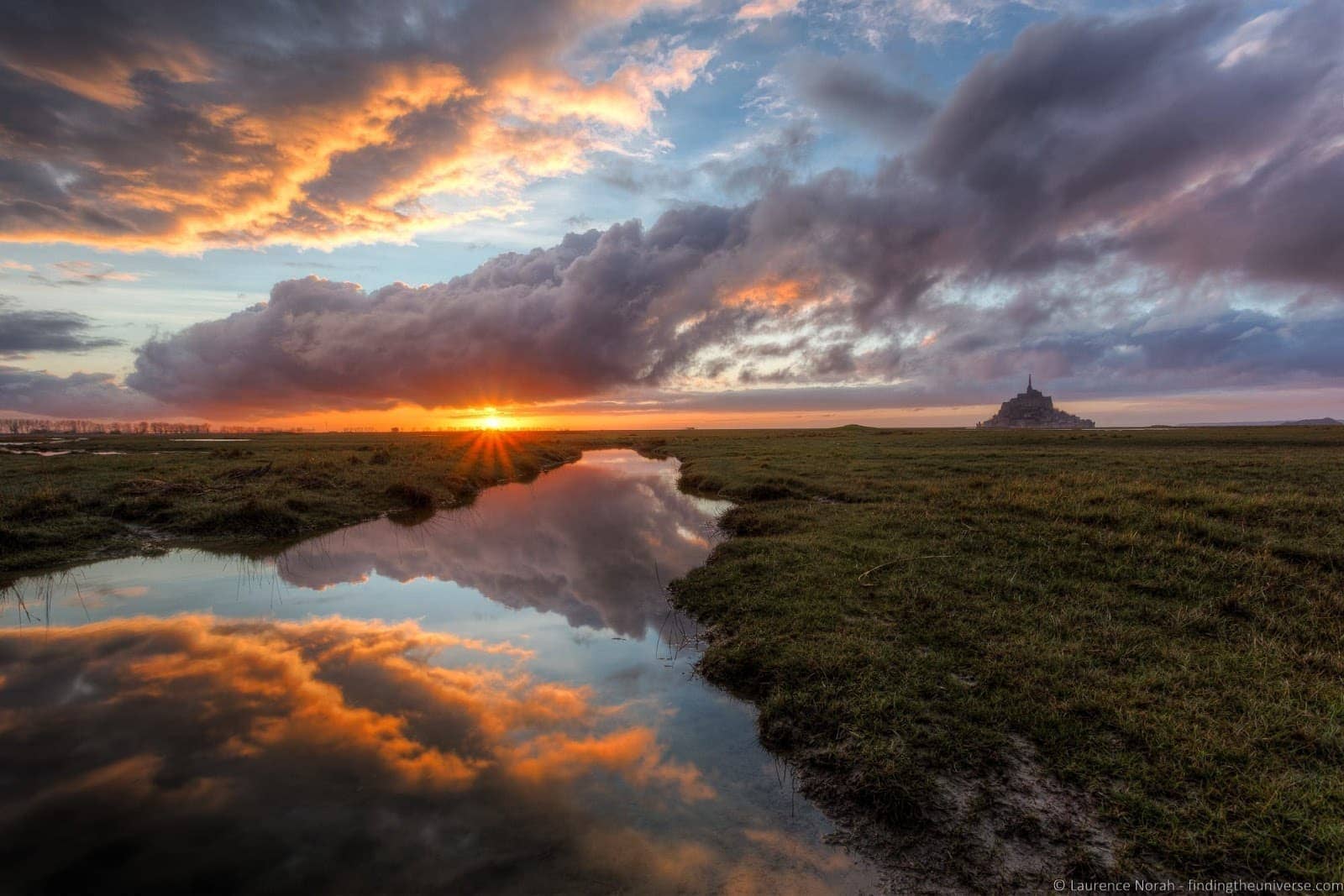
We actually found that there are lots of these in the Mont St. Michel area, you can see Mont St Michel listings here on booking.com
There were three Chambres D’Hotes near each other, including the one we stayed at , with a price for two people, including breakfast, usually in the region of €70 – €120. Definitely an option worth investigating.
How To Get Around Normandy
Since we took the ferry, we were able to take our own car to France. This was very handy, and definitely meant we got to see everything we wanted to see at our pace.
I’d definitely recommend a car as the best option to get as much in as you can for your trip. If you’re coming from the UK, Brittany Ferries operates to a number of destinations in France, with Cherbourg, St. Malo and Caen likely to be your best options for a trip like the one we did.
If you’re looking to hire a car in France, we recommend searching for your car rental on Discover Cars here . They compare a range of providers so you can find the best deal for your trip.
Tours of Normandy and the D-Day Beaches
If you would rather not have the hassle of planning your car hire or hotels, it’s also possible to visit the D-Day beaches and Mont St. Michel on a guided tour. This will also carry the benefit that you will have someone on hand to explain the significance of what you are seeing.
It is possible to do this as a day trip from Paris, however the day trips will focus on either Mont St. Michel or the D-Day Beaches, as doing both would be challenging in a day from Paris. There are however two day (and longer) tours like this which cover both sights. Here are some options:
- A 1 day tour from Paris of Mont. St Michel , which includes transport and your entry ticket
- A 1 day tour from Paris of the Normandy D-Day landing beaches , which includes transport, museum entry and guide
- A 2-day tour of Normandy, Saint Malo and Mont St Michel from Paris , which includes transport, overnight 4* accommodation, some meals, a guide, and entrance fees. This would be our recommended option from Paris if you have the time as it covers many of the locations in our guide.
There are many more tours to choose from, you can see a selection on Viator here , and GetYourGuide here
These tours all run from Paris as this is the most popular departure point. However, there are also tours from Bayeux in Normandy, which you can reach by a 2.5 hour train from Paris. In this case, we’d suggest booking a 1 day tour of the D-Day beaches, and a 1 day tour of Mont. St Michel. Here are some options:
- A 1 day tour of Mont St. Michel , including transport and guide
- A private 1 day tour of Mont St. Michel , also including transport and guide. This is a similar tour with departure from either Caen or Bayeux.
- A 1 day small group tour of the D-Day beaches , with a particular focus on the beaches used by the American forces.
Getting To Normandy from the UK
As mentioned above, we took the ferry from Portsmouth to St. Malo (and back again!) with Brittany Ferries .
We had a four berth cabin on both crossings, which was particularly handy for the night crossing to France as it meant we could have a good night’s sleep. Each cabin also includes a sink, toilet, and shower so you can arrive feeling refreshed.
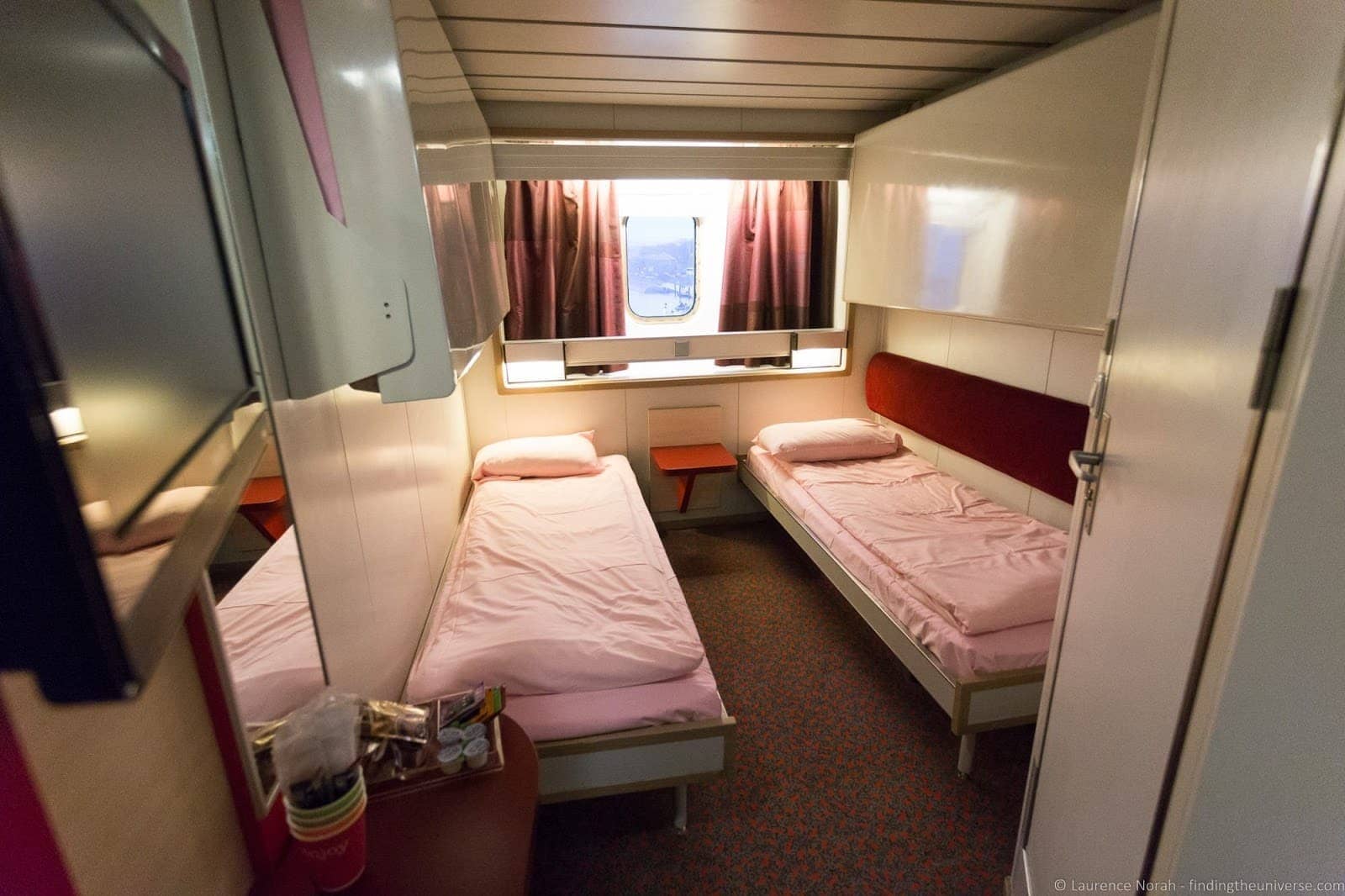
The boat was also well equipped, and we enjoyed an excellent dinner on board on our way to France, and a lovely lunch on the day crossing back. In the evening, after our dinner, we went and watched the cabaret show (and partook of the excellent bar!), with Jess having a huge cocktail and me going for a slightly simpler beer option.

Jess also got involved in the magic show (this seems to happen to her a lot!), as a man rather worryingly stuck a sword through her throat. This was a lot of fun, and overall, we’re happy to recommend the Brittany Ferries experience to anyone looking to travel to and from the UK by ferry with a car.
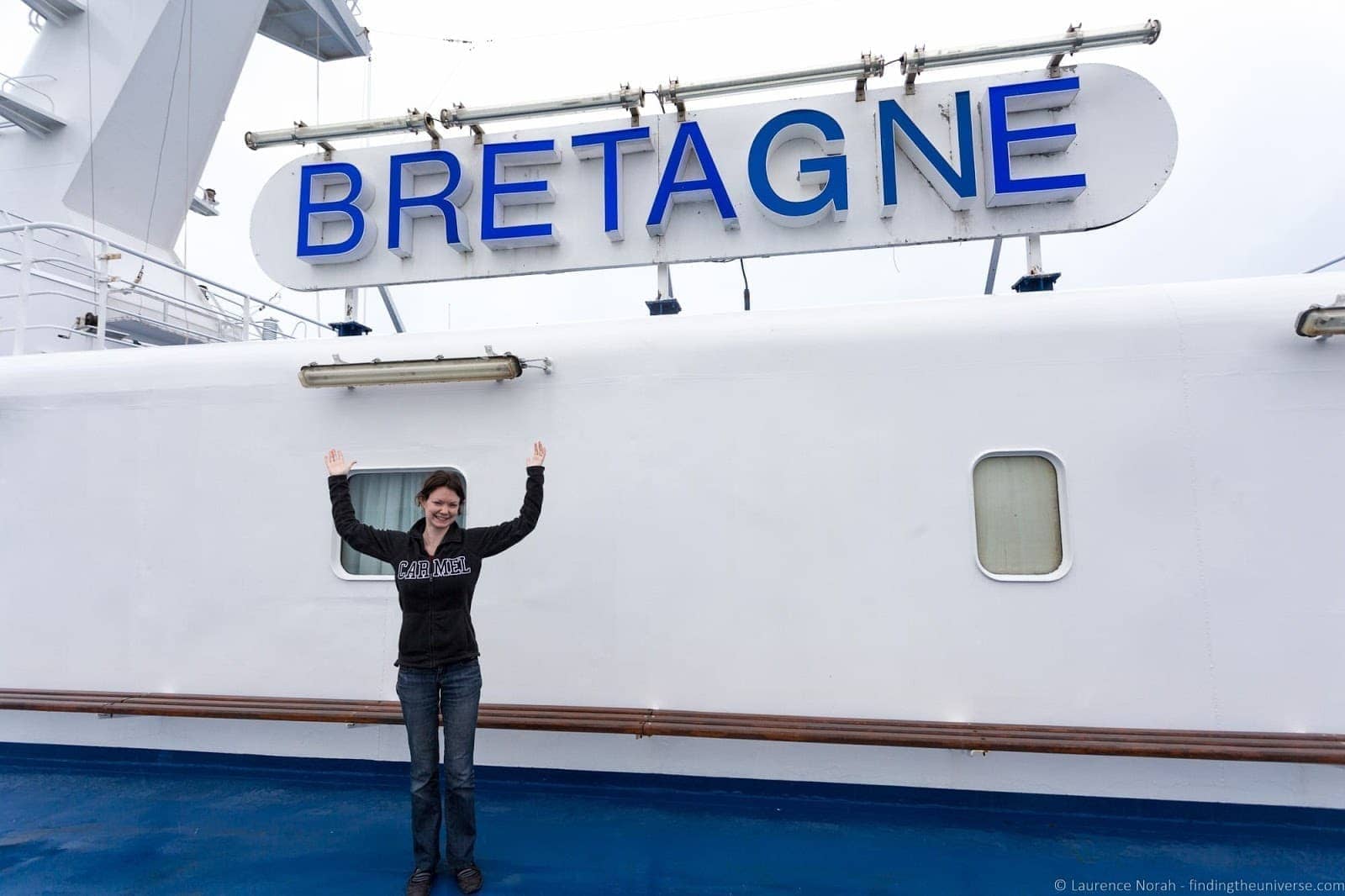
Further Reading for your Visit
We’ve written more about France to help you plan your visit to this lovely country. Here are some resources we think you’ll find useful:
- We have a 2 Day Paris Itinerary as well as a 3 Day Paris Itinerary
- We also have a guide to spending a day in Paris , if you’re on a really tight schedule and just want to focus on the highlights
- Our guide to the Best Photography Locations in Paris
- A full review of the Paris Pass , to help you save money on your visit, as well as a review of the Paris Museum Pass
- A guide to the best afternoon tea in Paris
- A guide to choosing the best Seine Boat River tour
- A guide to recognising and avoiding common Paris scams
And that pretty much wraps up our two days experience in Normandy! Have you ever visited the sights in the article? Have any tips or experiences to share? Let us know about them in the comments below!
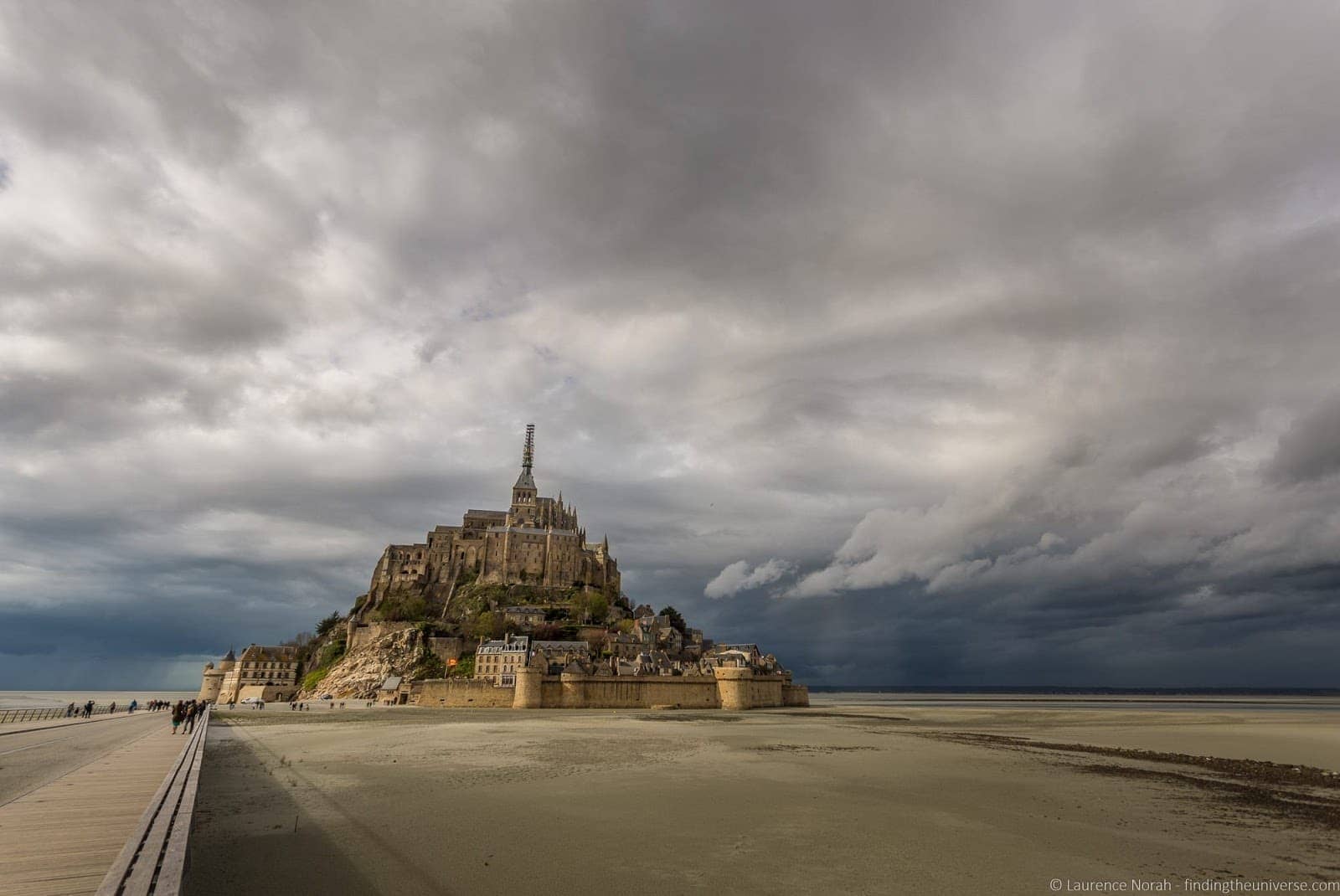
So you know, we received complimentary tickets from Brittany Ferries to and from the UK for two people and a car. All other expenses, including meals and drinks on the boat, as well as our accommodation and activities in France, we covered ourselves. As always, you can read our code of ethics to find out how we choose to work with!
Enjoyed this post? Why not share it!
There are 35 comments on this post
Please scroll to the end to leave a comment
Michael Giblin says
11th January 2024 at 5:18 am
Hi Jessica Thanks for the interesting article, especially the links to other information. We plan to go to France in Septembers, spend 6 nights in Paris then take the train to Bayeux rent a car and spend 3 days visiting the Normandy sites then spend 3 nights in Tours visiting the Loire Valley. Then take the train To Paris and head home. Your travel log is really helpful because after reading yours and many travel logs, we realize we can rent a car and do self-guided tours and go at our own pace. My wife speaks French so that will be a big help. Thank you.
Laurence Norah says
13th January 2024 at 2:00 pm
It’s our pleasure Michael, have a wonderful trip to France and do let us know if you have any questions!
Eileen Cowley says
9th September 2023 at 2:08 am
I love all this wonderful and insiteful information about a 2 day Normandy visit. We will visit Mont St. Michel on the 1st day, and the beaches you recommended on the second. Should we stay 2 nights in the hotel close to St. Michel. or check out, visit the beaches and choose another location close to Point de Hoc? Thank you!
10th September 2023 at 3:05 pm
Thanks very much! So I would probably recommend checking out and moving on so you don’t have to drive backwards and forward so much. Of course, it will depend a bit on your overall itinerary, but personally I’d find somewhere closer to where you’ll be visiting on your second day.
Have a lovely time in France, let me know if you have any more questions!
Linda Karol says
16th July 2022 at 8:07 pm
Hello! My so is in the Air Force and was recently involved in the DDay Reinactment. I will go onto your Facebook site and post some of his pictures for you.
21st July 2022 at 7:54 pm
Thank you very much Linda 🙂
26th June 2022 at 8:49 pm
we are staying in Dol De Bretagne for a week ( arriving in st Malo) then driving up to normandy on the Friday so we can see the D Day beaches etc before getting the ferry on the Sunday from Caen back to the UK. we will have 2 days and your itinerary has been big help , where do you think the best place to stay is please ? Caen ? Bayeux , or somewhere else. we need to be at Caen for 7.30 on the Sunday morning for the ferry so don’t want to have to travel too far to get there. we are leaving Dol early fri morning so will have 2 full days . thanks for your help
27th June 2022 at 9:50 am
I think either Caen or Bayeux would work. Caen would obviously be easier for your early morning ferry, so I might opt for that, and it’s not too far to the majority of beaches. There are also lots of accommodation options in Caen as you can see here .
Have a great trip and let me know if you have any more questions!
Nicolas Mata says
14th June 2022 at 2:31 pm
Very educational. By the way, how did you create your own blog?
14th June 2022 at 4:19 pm
Thanks Nicolas! I created it initially back in 2010 using Google’s free Blogger service. Then I migrated to a paid service using WordPress. We actually have a complete guide to starting a blog , which you might find interesting 🙂
Patricia says
6th June 2022 at 5:15 pm
Fantastic comments and beautiful photos. Thank you
6th June 2022 at 5:50 pm
Thanks very much Patricia!
Stuart Robertson says
20th April 2022 at 6:55 pm
As the majority of troops to land on D-Day were British, it’s a shame you visited exclusively American sites. For information, Omaha was not the most heavily defended beach, Sword was.
20th April 2022 at 7:55 pm
Thanks for your comment! As my wife is American and had family members who took part in the landings, those were the beaches we chose to visit as they had the most personal connection to us. My grandfather was British, but I believe his war was primarily in Italy. Of course we are grateful for all their service, but don’t feel they would think any the less of us for which beach we visited. Hopefully we will be able to return soon and see more of the landing locations.
In terms of Omaha vs Sword, do you have a citation for that? The Imperial War Museum website here state that Omaha was the most heavily defended of the beaches, but I would add I am happy to change the information if there’s a more authoritative source.
Thanks again for your comment!
Linda Hyers says
4th March 2020 at 9:43 pm
We are going to Paris mid July and want to go to Normandy & St Michel. Looks like most of the tours leave on Thurs. we need to tour on Tues-Friday. Any ideas?
5th March 2020 at 2:05 pm
Hmm, that is a bit of a conundrum. I have a few options for you, depending on your budget.
First, there are a number of private tours you can take, where the day is less relevant. However, these are definitely more pricey. There are quite a few options listed on Viator, such as this one .
You might also try reaching out to Context Travel who do custom private tours of Normandy here . You get a 10% discount with our link too.
If the above options are out of budget, I have another idea.
You could take a 1 day tour of the Normandy Beach locations, like this one .
The advantage of the above tour is that is actually starts in Caen train station, not Paris, so you are not paying for a return trip to Paris as part of the tour. Instead, you would need to book your own train ticket to Caen. The fastest train takes around 2h – 2h30, so if you get an early train you can be in Caen by 9am.
You would then take the full day tour of the D-Day beaches and sights, which are harder to see without a tour or if you don’t have your own transport. You can then overnight in Caen, or head on to Mont St. Michel.
There’s a direct bus from Caen to Mont St. Michel, which takes around 3 hours. You can book this online. You can then spend the day exploring Mont St. Michel before heading back to Paris.
I appreciate this would be a bit more work on your end, but it would be much more cost effective than a private tour, and you would only need to book your train / coach tickets. You can book both of those in advance here .
Let me know if you need any further advice, I’m happy to help!
22nd February 2020 at 2:47 pm
Hi !!! Love the way you write and off course your photografy! My soon to be 15 year old son wants a trip to the D day beaches. We will be in London for 6 days then Paris for two days then we plan to be in Normandy for two days and we want to make sure we see Mt St Michel and the D day beaches! (Great suggestions from you on the aviator tours for 1 day only on those- we most probably book that) Is any way we can go from there back to London (to depart to the US) with out going back to Paris? Somebody suggested the ferry but then is there a train to London ? We obviously won’t have a car.
22nd February 2020 at 2:54 pm
Thanks very much Maria!
So yes, you can definitely take a ferry from Normandy or Brittany to the UK. Ferries depart from Caen, Cherbourg, Le Havre or Saint Malo and go to Portsmouth, and then it’s easy to take a train from Portsmouth directly to London, it takes around 2 hours. There’s also plenty to see in Portsmouth!
A couple of guides you might find useful:
This guide to getting from Paris to London, which actually has ferry information for all the major ports you should find helpful: https://independenttravelcats.com/how-to-get-from-london-to-paris/
This guide to things to do in Portsmouth: https://www.findingtheuniverse.com/things-to-do-in-portsmouth-uk/
Let me know if I can help any more, and have a great trip!
Kristi says
12th February 2020 at 1:07 am
This info is fantastic. We’re planning a trip in June from London into Paris, then Normandy. Frankly, Normandy is to be our highlight, as its my husband’s 50th and its a bucket list item. We are taking our three kids (8,12, 14) and all love history. I’m doing my homework and came across your site. Thank you for this info. I’m still trying to figure out the best way to see both MSM and the American beaches/cemetery/museum. should we have a hub in Caen? We do want to take our time in the Normandy region and not be too rushed. Thank you!!
12th February 2020 at 1:35 pm
Thanks very much! I would definitely recommend having a base somewhere so you can have at least two days to explore. You’ll need at least a full day for the D-Day sites, and at least half a day for MSM. We based ourselves near MSM, but that was purely because I love photography, so I wanted to be within walking distance of the Mount at sunset and sunrise! Caen would make a great base for both, easy for the beaches and other D-Day sites, and within easy driving distance of MSM. It’s also accessible by direct train from Paris in 2 hours, which is going to be the fastest way to get there, and then you can hire a car in Caen.
Let me know if you have any more questions, I hope you have a wonderful trip and happy birthday to your husband 😀
Michelle says
21st October 2019 at 9:49 pm
We are traveling from Paris to Rennes by train. Renting a car and driving to Mont St Michel. I would love to see Dinan but it may possibly be to far “out of the way” and I don’t want to rush MSM but a few hours should be plenty there…? I would like to stay somewhere near MSM for one night. Then the next morning drive to Bayeux and DDay beaches staying in Caen to return car and hop on the train back to Paris. Any suggestions of towns to visit or see along the route from MSM to Bayeux? Also any suggestions of towns to stay in near MSM.
25th October 2019 at 4:51 pm
Hi Michelle!
Sorry for the slow response! We’ve been moving house, which has been a bit time consuming, and left us without internet for a while.
Anyway, you are correct, a few hours at Mont St Michel would be more than enough. It’s around an hour from Mont St. Michel to Dinan, so that would be theoretically doable in the same day.
From MSM to Bayeux is only 1h 38 minutes. So I would suggest just heading up that way and straight to the coast and the beaches, which run for a fair distance along the coast north of Bayeux.
For accommodation near MSM, well, you can either stay on the Mont itself, or one of the nearby villages. If you look at the map on this page , you should get an idea of nearby accommodation options 🙂
Have a great trip!
Susan Haydon says
29th May 2019 at 7:42 am
Hi Laurence,
We are off to Normandy this coming weekend. Do you have an approximate cost of entry fees to museums etc. or can you point me in the right direction to find these? Also, I would love to print this article to take with us. Is there a way to print it without all the ads?
Thank you to you and Jess for the excellent coverage of this wonderful location.
29th May 2019 at 10:59 am
So we don’t have a print feature like that – the best option would be to temporarily install an ad blocking extension I think. Alternatively you could copy the text into a word document and delete the ads / images.
For the museums, the prices are quite well hidden, if you can even find the website 😉 They vary, but i would estimate between €8 and €12 euros on average. For example, here are the Utah Museum prices: https://www.utah-beach.com/information/?lang=en
Have a wonderful trip, do let us know how you get on 🙂
29th May 2019 at 12:48 pm
Many thank, will do ????
17th October 2019 at 6:42 pm
I hope you had a great trip. This is too late for your Normandy trip, but in case you use our site in the future, I just wanted to let you know that we finally figured out how to implement a print feature, so you can now print ad and image free versions of all our pages from the print button on the site.
stephane yao says
29th April 2019 at 3:49 am
Hi Laurence, we plan to take on 1 day trip from the mont st michelle to the destination deauville. During this day, is it possible to follow your 3 landing location in 1 day by a rented car?
sincerly Stéphane
30th April 2019 at 5:41 pm
Hi Stéphane,
This is definitely possible as Jess and I did exactly this 🙂 So you shouldn’t have any problems,
8th April 2019 at 11:34 am
Hi there im heading to st.malo at the end of this month with hubbie is there a tour bus r train that culd take us to utah beach and the ww11 memorial that u mentioned thankyou
8th April 2019 at 11:43 am
It’s around a 2.5 hour drive to the D-Day beaches from St. Malo, so most tour companies instead operate from nearer locations like Cherbourg. From St. Malo, most tours are focused instead on Mont St. Michel. So the best option is likely to rent a car and drive yourself as I have not been able to find a tour from St. Malo. It is of course possible that they exist, but you might have to contact the local tourism office in St. Malo for information.
8th April 2019 at 12:03 pm
Thankyou Laurence
betseysheprow says
2nd February 2019 at 7:54 pm
is it possible to get a group guided tour of normandy and is it worth it?
3rd February 2019 at 11:49 am
It is certainly possible, here are two options, this one from Caen, and this one from Paris .
We have never done a tour like this so I can’t comment if it is worth it, but the reviews are positive, and we think that having a guide to help walk you through some of the history can only be a good thing 🙂
Have a great trip
20th April 2022 at 7:13 pm
Do bear in mind its a 9 hour round trip drive from central Paris to Utah Beach. A day trip from Paris is doable but it’s much better to get an early train from St Laxare to Carentan (depart 7am & 2.5 hrs) and then get a tour commencing there (look up Allan Bryson – a great guide).
20th April 2022 at 7:57 pm
This is absolutely true. We definitely feel the train is a better option and ideally folks should spend at least one night as well in the area if possible, if not more!
Leave a Reply Cancel reply
Your email address will not be published. Required fields are marked *
Let me know when there's a reply to my comment (just replies to your comment, no other e-mails, we promise!)
Subscribe to our monthly Newsletter where we share our latest travel news and tips. This also makes you eligible to enter our monthly giveaways!
We only ask for your e-mail so we can verify you are human and if requested notify you of a reply. To do this, we store your data as outlined in our privacy policy . Your e-mail will not be published or used for any other reason other than those outlined above.

- Detailed 3 Day Itinerary for Visiting the Normandy Beaches (From Travelers Who’ve Been 8 Times!)
by Ellen | Aug 21, 2022 | Destinations , Europe , Trip Planning | 3 comments
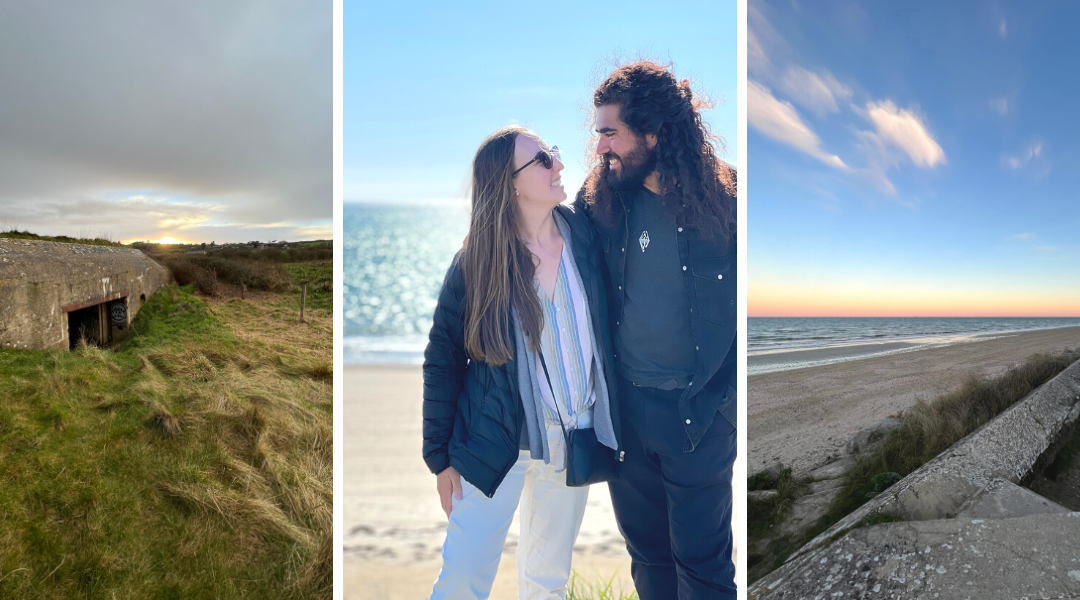
I couldn’t believe my eyes. We had just gotten accepted to housesit in Normandy for a month(!). The only catch – We had to leave in just 2 weeks! But why not?
That was the whirlwind way we became full-time digital nomads and left for our second trip to Normandy, France in 2018. We’ve been 8 times now and go back every year, normally staying for a month at a time.
From our first trip to Europe in 2016, this beautiful region of France has captured our hearts and we could talk about it for hours.
In an effort to keep the word count down a bit though, this post is focused on visiting the D-Day beaches in Normandy for the first time.
But because we can’t help ourselves, we’ll also pop in fun recommendations outside of the normal museums and tourist sites like where to find an absolutely charming creperie and where to find the French meals we dream about.
In this detailed 3-day itinerary for visiting the Normandy beaches and D-Day sites, you’ll find everything you need to know for planning your first trip to Normandy, France.
TABLE OF CONTENTS
Planning a Trip to Visit Normandy
- Where to Stay
- Where to Eat in Normandy
- Detailed 3-Day Itinerary for Visiting the Normandy Beaches + D-Day Sites
Day 1: Train. Museum. Castle.
- Day 2: Omaha Beach, American and German Cemetery
- Day 3: By Land and By Sea On the Way Out
How many days to visit Normandy?
Normandy is more than a day trip from Paris.
We recommend 3 to 5 days: 3 days if you’re just going for the Normandy beaches and 5 days if you want to see some of the cultural sites as well.
I know there are some guides out there that talk about visiting Mont St. Michel, Bayeux and the Normandy Beaches all in 3 days. But fitting in as much as possible into a day misses a lot of the essence of traveling in Normandy.
A large part of visiting Normandy is relaxing into the pace of life in the French countryside.
Spend an hour in the morning at the weekly market perusing the fresh cheeses and cider.
Take those extra few minutes to learn the stories of the region from your Bed and Breakfast host.
Enjoy the crackle of the fire and the taste of the wine during your 3-hour dinner – complete with a cheese AND dessert course.
Embracing this slow-travel culture takes your Normandy experience to another level.
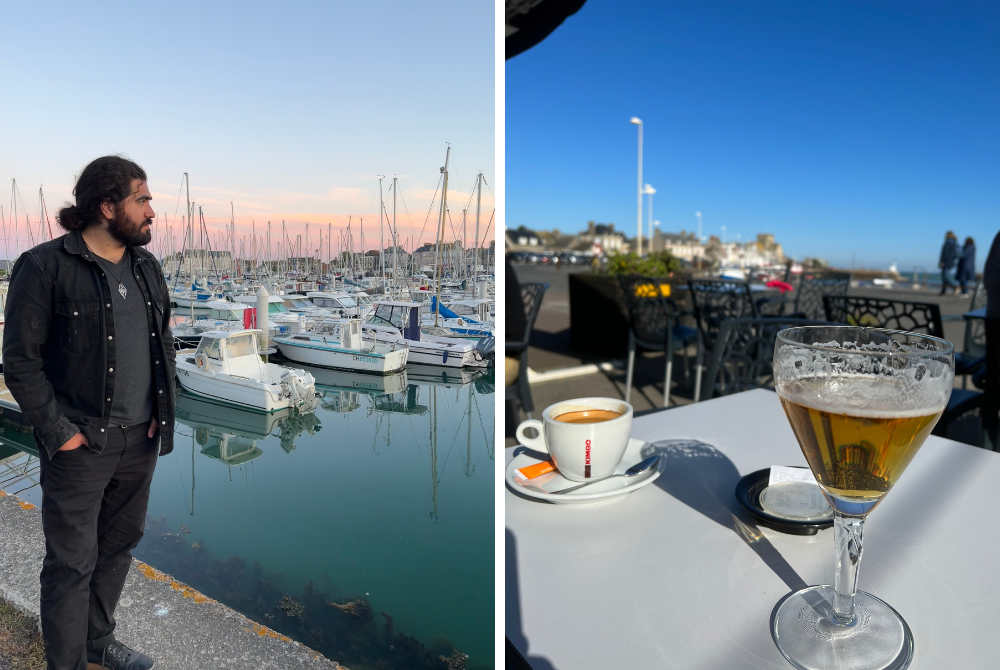
Any tips renting a car and driving in Normandy from Caen ,do you need to purchase the SUPERPAK insurance seemingly every rental agency tries to hawk and what about the triple AAA international drivers license ? please share your thoughts.
Hi there! We’ve rented from the major companies like Hertz and Avis in Caen pretty easily. I do recommend getting the additional insurance if you are not using a credit card that has rental car coverage. You do not need a AAA international driver’s license to drive in France. Hope that was helpful and enjoy your trip!
Submit a Comment Cancel reply
Your email address will not be published. Required fields are marked *
Save my name, email, and website in this browser for the next time I comment.
This site uses Akismet to reduce spam. Learn how your comment data is processed .
Meet Chris + Ellen

We look for the stories found off the typical tourist path, good food, and authentic experiences. Follow our YouTube videos and blog posts for candid travel tips, and inspiration that will get you on the road too!
Recent Posts
- Planning 2021 When You’re Still Recovering from 2020
- 5 Cheap Things to Do in Europe (For 1 Euro!)
- Anchorage, Alaska in the Winter: 1-Week Itinerary
Sign up for our weekly newsletter!
Pin it on pinterest.
- Skip to primary navigation
- Skip to main content
- Skip to primary sidebar
- Skip to footer

Normandie Lovers
To awaken your senses in Normandy - Claire et Manu’s Blog
Visiting the 5 D-Day landing beaches (in Normandy)
by Claire ROBINSON , Region Lovers | September 7, 2023 | no intrusive ads, no sponsored content, just some affiliate links - if you use them, we get a small commission (read more)
Sand, dunes, cliffs… but also bunkers, sculptures and museums. The 5 D-Day landing beaches are a must for any trip to Normandy. Their story is both heartbreaking and inspiring. Each of these beaches now has memorials and museums to remember. Here is our complete guide to prepare your visit with:
- Omaha Beach
- Sword Beach
BEFORE OUR TIPS + PHOTOS HERE ARE OUR favorites

Our favorite car rental platform with great offers: DiscoverCars

Must-See : Book your tickets for the Caen Memorial Museum Excursion : Visit the D-Day landing beaches from Paris

Our favorite places to stay: Hotel Domain de Bayeux , elegant and central – see photos and availability Hotel Domaine d’Utah Beach , for the north – see photos and availability Hôtel Ferme de la Rançonnière , the charm of the countryside – view photos and availability
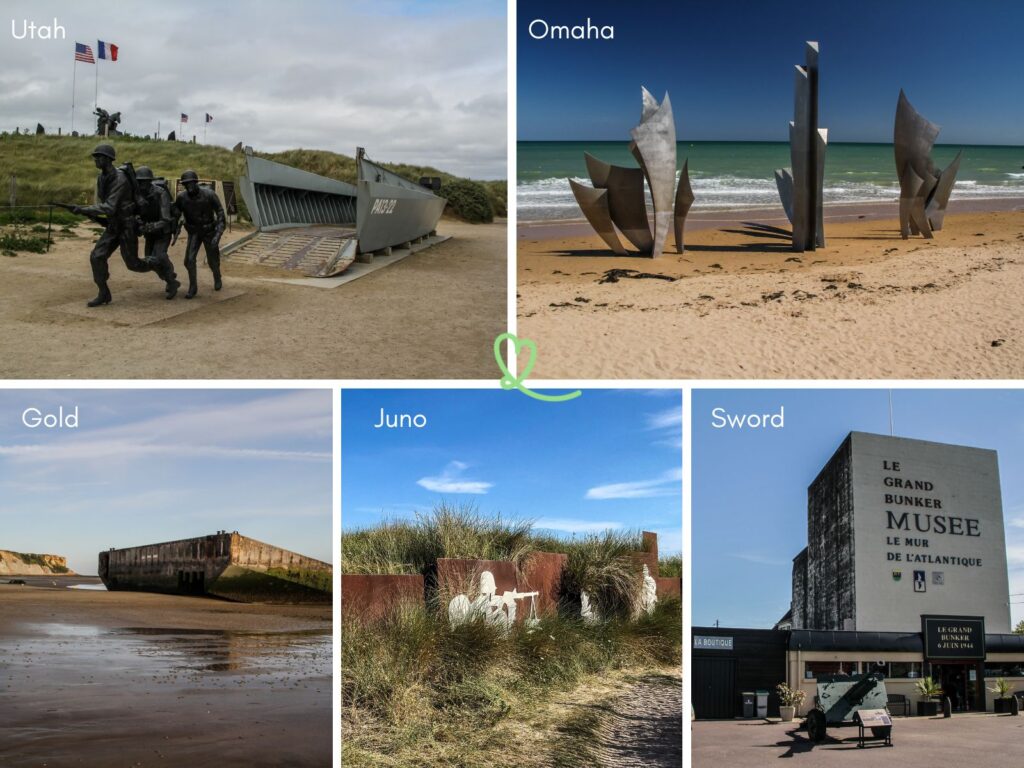
This guide is completely independent , based on our experiences. We visited the area anonymously, making our own choices, and paying all our bills in full.
Visit the D-Day landing beaches in Normandy : Map + tips
The 5 landing beaches – map and introduction.
Operation Overlord, a.k.a. the Normandy invasion, began on June 6, 1944. 5 main areas were strategically chosen by the Allies on the Normandy coast. They cover a section of more than 80km (50 miles). Code names have been given:
- Utah Beach, the easternmost beach where the American troops landed
- Omaha Beach where the American troops landed
- Gold Beach where the British troops landed
- Juno Beach where the Canadian troops landed
- Sword Beach where the British troops landed
Here is a short introduction video of each track:
The Battle of Normandy that followed lasted until the end of August.
Here is a map to help you locate them:
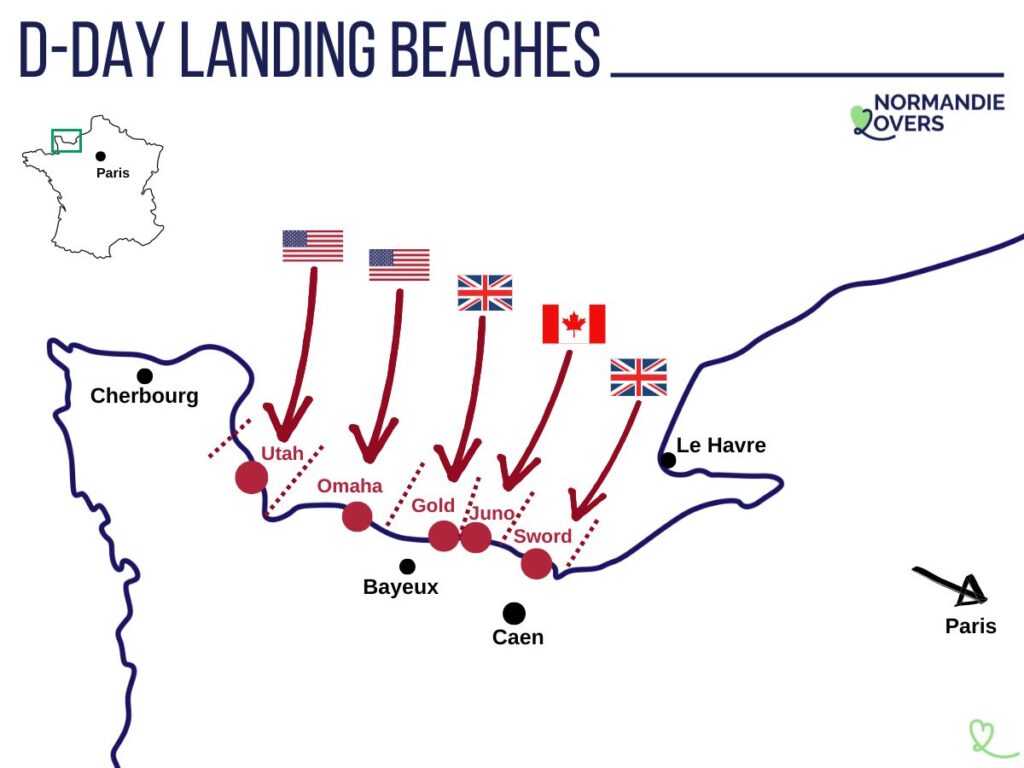
Which D-Day beach to visit?
Around these 5 beaches, you will find cemeteries, batteries, memorials and museums. They are all fascinating to discover. Depending on your family history, you can choose the one that interests you the most. And if you don’t know about special family ties, here are our opinions to help you choose:
- Utah Beach is the most fun : an open air museum, a battery and the new D-Day Experience not far away
- Omaha Beach is the most emotional : the magnificent sculpture on the beach, the intensity of the American cemetery. We didn’t expect to feel so many overwhelming emotions as we stood in front of all these crosses lined up.
- Gold Beach is the most fascinating visually: the remains of the temporary harbor that appear at low tide, the view from the cliffs…
- Juno Beach is the quickest to visit – if you’re short on time, the beach and museum are right next to each other
- Sword Beach is the most strategy oriented – no beach experience here, but the Antaltic Wall Museum in the Bunker is a unique experience and the Pegasus Memorial tells us more about this critical victory.

How to visit the D-Day beaches in Normandy?
We do not recommend public transportation to visit the landing beaches. There are some local buses, but not very frequent and with many stops for the locals. Your best options are:
- By car Visiting by car gives you a lot of flexibility in choosing where to go and how much time to spend at each place. You can rent at CDG or Orly airports, or Caen (see our tips ) or your point of arrival in France – note that Bayeux has very few choices (read more ).
OUR ADVICE FOR RENTING A CAR IN Normandy
- Compare prices on our preferred platform: DiscoverCars – one of the best rated sites.
- Choose a car that is comfortable enough (distances can be long) but compact (some parking lots and villages are narrow).
- Think of the complete insurance (some roads are tortuous and narrow).
- There is a lot of demand, book it early .
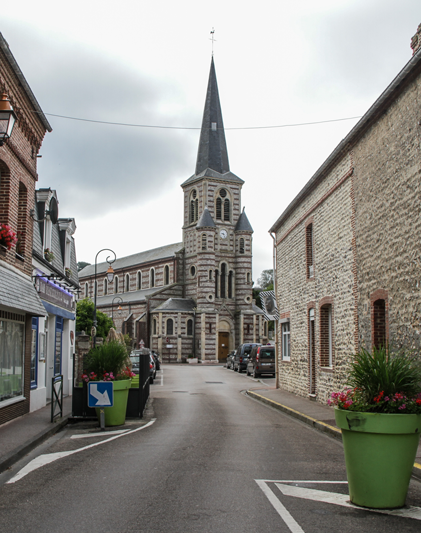
How long to visit the landing beaches
Let’s start by discussing a little bit about the driving times between locations. This will give you an idea of what is feasible:
- From Caen to Bayeux = 30 min drive
- From Bayeux to Utah Beach = 50 min
- From Utah Beach to Omaha Beach Beach = 45 min
- From Omaha Beach to Gold Beach = 45 min
- Gold Beach to Juno Beach Beach = 15 min
- From Juno Beach to Sword Beach Beach = 30 min
- From Sword Beach to Caen = 20 min
- Paris to Omaha Beach = 3h30
You can get an overview in one day. But for a more complete vision and to immerse yourself in the history we recommend 3 to 5 days, or even a week if you are passionate.

Which city is the most convenient to visit?
The most convenient cities to stay and visit all the landing beaches are :
- Bayeux, a charming little town inland see the best hotel offers
- Arromanches-les-bains, central and at the seaside, it is at the level of Gold Beach see the best hotel offers
- Caen is the largest city in the area see the best hotel offers
STAYING NEAR THE D-Day beaches
Option 1: Bayeux
The most practical option, in our opinion, is to base ourselves in the town of Bayeux. We recommend..:
- Hotel Domaine de Bayeux in an 18th century mansion – see prices, photos and availability
- see all top rated accommodations in Bayeux

Option 2: in the countryside
In the countryside around the D-Day beaches, you will find beautiful buildings with a lot of charm: farms, manors…
- Hotel Domaine d’Utah Beach – prices, pictures and availability
- Hotel Ferme de la Rançonnière – prices, pictures and availability

Option 3: next to one of the beaches
If you’re looking for a seaside holiday or are fascinated by one of the beaches, you can choose a more specific hotel:
- Hotel Villas d’Arromanches in Gold Beach Beach – prices, pictures and availability
- Hotel La Sapinière in Omaha Beach Beach – prices, pictures and availability

See all our advice on where to stay to visit the beaches
1. Utah Beach
The landing at utah beach – facts and figures.
Utah was the westernmost beach of the landing. It covered the section between Pouppeville and La Madeleine with the sub-areas Tare Green, Uncle Red and Victor. The section is 3 miles long (about 5km). 23,000 American troops landed here. Casualties were the lowest with 187 men killed or wounded.

Visit to the beach
The beach is easy to visit with a small dune, viewpoints and a large stretch of sand at low tide.

Barges and mannequins are installed not far from the museum, which allows to visualize a little better what the landing was like. But it’s hard to imagine this peaceful view with the sounds of gunfire, explosions and all the warships in the sea.

A little further down the beach, there are also some bunkers.

Museums around Sainte-Mère-l’Église
The main museum is the Utah Beach Landing Museum right on the beach. It tells in 10 sequences the events of D-Day. It is a chronological journey from preparation to victory. Open all year round

But the region is full of other museums and sites:
- The Airbone Museum with a superb scenography to understand the experience of the parachutists on the day of the landing Closed in December and January except during school vacations
- The D-Day Experience : an immersive museum with flight simulator Open all year round
- The Azeville Battery with an impressive underground complex Open from April to November 11
- The Normandy Victory Museum , about the Battle of the Hedges Open from April to October and partially in winter (weekends and vacations)
See more activities at Utah Beach .

Practical information to visit
Utah Beach is the most remote and scattered of the beaches. The museums are along the beach, in Sainte-Mère-l’église and in Carentan. You should plan at least one day but 2 days will allow you to cover more places. We stayed at the Domaine Utah Beach – Le Grand Hard hotel: a beautiful 17th century farmhouse turned charming hotel, with a restaurant known for its quality meat. A great time surrounded by nature! See photos, prices and availability Otherwise, there are hotels all around Sainte-Mère-l’église – see the best rated hotels aroundUtah Beach
USE OUR GUIDE TO PLAN A DREAM TRIP TO Normandy
All the information you need for your trip:
- 8 maps that make planning easier
- 160+ pre-selected locations
- Practical advice
- 300+ photos to help you choose
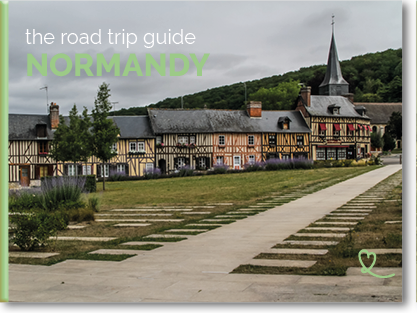
2. Omaha Beach
The landing at omaha beach – facts and figures.
Omaha, the largest, is probably the best known of the D-Day beaches. It covered the section between Sainte-Honorine-des-Pertes and Vierville-sur-Mer, with the sub-areas Charlie, Dog, Easy and Fox. The section is 6 miles long (about 10 km). 34,000 American troops landed here. Losses were highest, with 2,400 killed.

Omaha Beach is the most difficult to visualize. The beach has a promenade right on the edge and is very touristy with bathers. It is still one of the most photographed with the sculpture “The Braves”. It is composed of 3 elements: “Wings of Hope”, “Stand Up for Freedom” and “Wings of Brotherhood”. Created by Anilore Banon, it was installed in 2004, for the 60th commemoration.

The only signs of the war are the memorials and some bunker ruins.

Museums near Colleville-sur-Mer
- American Cemetery: 9387 perfectly aligned tombstones, garden, chapel, memorial, and a small museum giving the content of Operation Overlord. Open all year round
- Overlord Museum: near the American cemetery, one of the richest in terms of artifacts of the landing and the war. With a museography adapted to children. Closed in January and early February.
- The Pointe du Hoc: a strategic place of the German fortifications. The walk around the point takes you to see different bunkers above the cliffs. Open all year round
- Big Red One Assault Museum : museum dedicated to the 1st Infantry Division of the U.S. Army nicknamed “The Big Red One Open from March to November
- Maisy Battery : Battery rediscovered in 2006 with many underground passages. Open from April to September
- D-Day Omaha Museum – open from April to September
- Liberation House – open from May to September
- Omaha Beach Memorial Museum – open from June to September
Find out more about activities around Omaha Beach .

Omaha Beach is less remote but still requires a bit of a drive from Caen. The beach and the museums are grouped together, but to visit the Pointe de Hoc and the Maisy battery, you have to drive a little. You should plan at least one day but 2 days will allow you to cover more places. We stayed in Bayeux (25 min drive) at the Domaine de Bayeux: a charming hotel in the center of Bayeux surrounded by a French-style park. See photos, prices and availability Otherwise, there are hotels all around Colleville-sur-Mer – see the top rated hotels aroundOmaha Beach

MORE ABOUT THE D-Day sites
- The best landing sites to visit
- Visit the 5 D-Day landing beaches
- Where to stay – best hotels near the beach
- The best D-Day museums in Normandy
- German batteries to visit
- Car rental tips: Caen – Roissy-CDG – Orly – Beauvais
- Visit Omaha Beach
- Visit Utah Beach
- Visit Gold Beach
- Visit Sword Beach
- Visit Juno Beach (coming soon)
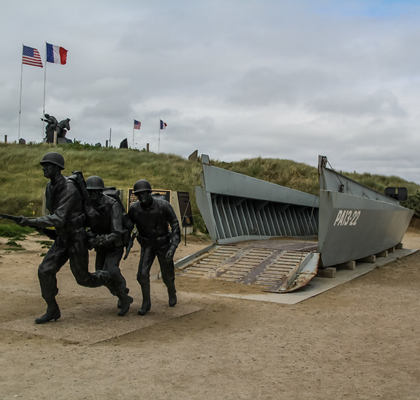
The Arromanches part of Gold Beach is one of the most visually interesting of the D-Day landing beaches. At low tide, pieces of the artificial harbor (Mulberries) appear clearly and you can approach them.

The beach of Arromanches is surrounded by cliffs. This allows to have beautiful views from the top of them.

And at the entrance to the beach, near the museum, you can appreciate several pieces of equipment.

Museums in Arromanches
- The D-Day Museum : presentation of the history of the British artificial harbor with the challenge of its construction and its key role in the victory. Closed in January
- The circular cinema Arromanches 360 : with 9 circular screens, the film “100 days of Normandy” plunges you during 19 minutes in the heart of the terrible battle. Closed in January
- The battery of Longues-Sur-Mer : a superb site on the cliffs with access to a fire command post, 4 reinforced concrete casemates and artillery pieces. Accessible all year round
- America Gold Beach Museum : dedicated to the first USA-France airmail link and the British landing in the “King” sector. Open from March to October
- Museum of underwater wrecks – open from June to September
Find out more about activities around Gold Beach .

The beach of Arromanches is very central. It is a good base to visit the landing beaches. The beach and the museums are grouped together. And the battery is only 15 minutes away. It is necessary to plan at least one day and to organize to visit the beach at low tide. We stayed at the hotel Les Villas d’Arromanches: a charming hotel in a 19th century villa on the heights of the city. A haven of peace with beautiful views of the sea. See photos, prices and availability Otherwise, there are hotels all around Arromanches – see the top rated hotels around Gold Beach

Subscribe to our Newsletter
- Get away from it all with Region Lovers’ beautiful destinations!
- Once a month
- Advertising-free
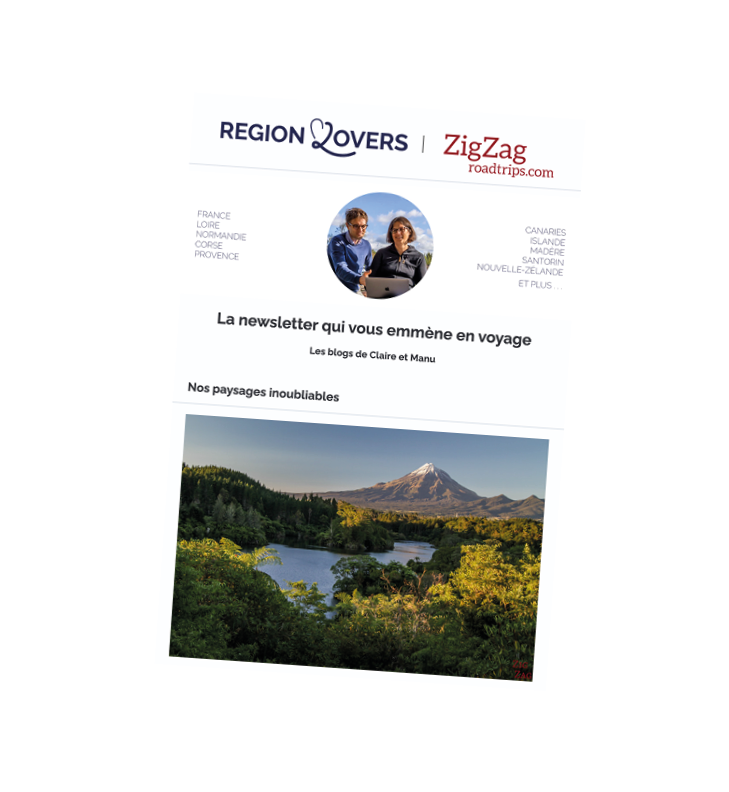
4. Juno Beach
The landing at juno beach beach – facts and figures.
Juno Beach was the landing site for the Canadian Army. It covered the section between La Rivière and Saint Aubin-sur-Mer, with the Love, Mike and Nan sub-sectors. The section is 6 miles long (about 10 km). 21,400 Canadian and British troops landed here. Casualties amounted to 1,200 wounded or killed (including 359 Canadian dead).

To reach the beach, you have to climb a small dune of white sand. The beach extends as far as the eye can see, when it is low tide.

The Cross of Lorraine is clearly visible. It was installed here to commemorate the place where De Gaulle first landed, an important turning point in the Battle of Normandy.

On the beach, not far from the museum, you can also see bunkers, tanks and representations of soldiers.

Museums in Courseulles-sur-Mer
- The Juno Beach Centre which focuses on the role played by Canadians alongside the Allied forces. You will discover a film and 5 permanent exhibition rooms. Closed in January Read more
- Beny-sur-mer Canadia War Cemetery : not far away you can visit the Canadian cemetery where over 2000 men are buried. Accessible all year round

Juno Beach Beach is surrounded by a very nice resort. It is a good base for a stay in Normandy. The museum is on the beach. And the cemetery is only 10 minutes away. You should plan for a half to a full day. We stayed at the hotel Ferme de la Rançonnière: stones and beams, everything that makes the charm of a Norman farm. See photos, prices and availability Otherwise, there are hotels in Courseulles – see the top rated hotels around Juno Beach
5. Sword Beach
The landing at sword beach beach – facts and figures.
The Sword Beach Beach landing was one of the most strategic because it was one of the main routes to northern France. It covered the section between Saint-Aubin-sur-Mer and Ouistreham, with the Oboe, Peter, Queen and Roger sub-sectors. The section is 5 miles long (about 8 km). 29,000 British troops landed here. Casualties amounted to 630 killed and wounded.

On the beach of Ouistreham, few traces of the war. It is a very large sandy beach with beach huts. On the other hand, the city is rich in museums.

Museums in Ouistreham
- Atlantic Wall Museum – The Great Bunker : Explore the former German headquarters in this massive bunker. The interior rooms have been reconstructed on all 5 levels. Closed in January and early February
- Pegasus Memorial : museum that presents the different missions of the 6th British Airborne Division, including the capture of the bridge of Bénouville called Pegasus Bridge. Closed from December 16 to January 31
- Museum No. 4 Commando : the history of French commando who joined the British troops and participate in their missions Open from April to early November
- Merville Battery: a German battery transformed into a museum with an excellent museography around bunkers, tanks, planes… Open from mid-March to mid-November
- Radar 1944 Museum (in Douvres-la-Délivrande): installed in the former German detection station, the museum presents the life of German soldiers during the occupation of Normandy as well as the history of radar. Open from April to mid-November
- And several cemeteries : La Délivrande, Hermanville, Ranville
Find out more about activities around Sword Beach .

Sword Beach Beach is in Ousitreham, a seaside resort with a huge beach. The museums are close to the beach. The Merville battery is 20 minutes away. Douvres-la-Délivrande is 20 minutes away. You should plan at least one day but 2 days will allow you to cover more places. There are many hotels and rentals in Ouistreham – see the top rated hotels around Sword Beach
Normandy beaches – D-Day in numbers
Just over 156,000 men landed on the beaches of Normandy.
The allied troops arrived
- Paratroopers: over 23,000
- By sea: over 133,000
The soldiers disembarked by nationalities
- Americans: approximately 73,000
- British: approximately 62,000
- Canadian: approximately 21,000
- and also soldiers from Belgium, Norway, Poland, Luxembourg, Greece, Czechoslovakia, New Zealand and Australia.
- And more than 170 French commandos
Casualty estimates – how many died on the beaches of Normandy
- Number of allied losses on June 6 at midnight (killed, wounded, prisoners…): more than 10 000
- Number of German losses on June 6 at midnight (killed, wounded, prisoners…): estimated between 4000 and 10000…

The equipment
- Support aircraft: over 11,000
- Combat ships: more than 1200
- Landing ships; over 4,000
- Merchant ships: over 800
- The ships were 80% British and 16% American
Frequently asked questions about beaches
Landing beach in 1 day.
If you only have one day to visit the D-Day landing beaches, it is best to choose one of the 5 beaches described in this article according to your interests:
- Omaha is the most emblematic of the beaches with the sculpture and the American cemetery
- Utah or Omaha for the Americans
- Juno for Canadians
- Gold Beach for the British
- Gold Beach for those interested in temporary port engineering
- Sword Beach and Utah Beach for the best museums (in our opinion)
What was the bloodiest beach on D-Day?
The losses on Omaha Beach were the worst on D-Day. American troops lost more than 2400 soldiers who were killed, wounded or taken prisoner.
Are the beaches of Normandy still stained with blood?
No. Without the memorials, bunkers and cemeteries, it is impossible to imagine what happened on these beaches in 1944. These are now beautiful sandy beaches where people swim in the summer.

Can we take sand from the beaches of Normandy?
No. As in many other countries, it is illegal to take sand or pebbles from French beaches.
Visit the D-Day landing beaches in winter
You can visit the D-Day landing beaches in winter. The winter atmosphere is more conducive to introspection on their history than the summer crowds… Please note, however, that almost all museums close at least in January and early February. Closing times depend on the museum. See our article on museums . However, the beaches and many of the bunkers remain freely accessible.
Films on the D-Day beaches in Normandy
The Longest Day (1962) A very realistic account of the landing at Omaha Beach. Take a look at it before your visit, to better contextualize everything you are about to see.
Saving Private Ryan (1998) War movie directed by Steven Spielberg with Tom Hanks and Matt Damon. It is inspired by the real-life story of the Niland brothers, American soldiers killed during World War II. In this fiction, the hero goes in search of the last survivor to bring him back to his mother.
Overlord (1975) Black and white film by Stuart Cooper. Story of a young recruit and his training before D-Day.
PLAN YOUR TRIP TO Normandy
Inspiration destinations
- Deciding where to go in Normandy – the best destinations
- Our weekend ideas: best-of , romantic , unusual , seaside , luxury , family
- 16 seaside hotels in Normandy
- The most beautiful charming hotels in Normandy

- Best things to do in Normandy
- Best cities in Normandy
- Most beautiful beaches of Normandy
- Most beautiful villages of Normandy
- Best castles of Normandy
- Best abbeys of Normandy
- Read our complete guide to visit the Mont-Saint-Michel
- Discover the D-Day sites

- Where to stay in Normandy – best places and hotels
- See our tips for renting a car at CDG airport , Orly airport , Beauvais airport , Caen , Rouen , Bayeux …

SHE MADE THE TRIP AND WROTE THE ARTICLE Claire
Region lovers' 10 commitments.
- Visit all the places we tell you about.
- For each city, stay in at least one hotel and visit the ones we recommend.
- For each city, eat in at least one restaurant, visit the ones we select.
- Pay all our invoices in full, refuse any partnership or sponsorship.
- Periodically update our articles, with the help of our readers.
- Enrich our articles with our first-hand experiences.
- Use 99% of our own photos
- Use digital tools in a reasoned and transparent way, feeding them with information verified on site.
- Provide information on the traveler/writer pairing that gave rise to the article.
- Tell you what we do, and do what we tell you!
Claire and Manu
Find out more about the team and our history.

SEARCH OUR SITE
Our multi-destination blogs.
Regionlovers.fr
ZigZagroadtrips.com
OUR OTHER REGIONS TO DISCOVER
LoireLovers.fr
CorsicaLovers.fr
ProvenceLovers.fr
CanariasLovers.com
CHANGE LANGUAGE
Legal Notice / Terms of Use / Privacy Policy

Traveling with Sweeney
Inspiration and information for the best in luxury, cultural, and active travel, highlights of a 7-day normandy and brittany itinerary.
Editor’s Note: Some of the links in this post are affiliate links and if you go through them to make a purchase I will earn a commission. I link these companies to provide you a quality resource for your travels. The decision is yours, and whether or not you decide to buy something is completely up to you.
Walk, ride, and drive around Normandy and Brittany in seven days
There’s so much of France to discover that I think it’s best done in small bites. One of my travel goals is to visit each of France’s regions. Hopefully, sooner rather than later! On this trip, I was able to check off two new regions and I also got to revisit Paris — a city that I think should be part of every France itinerary. Here’s a brief guide to follow for the Normandy and Brittany part of the trip.
Our itinerary — at a glance
Day 1 – paris to rouen.
We arrived at Paris Charles de Gaulle Airport (CDG) in the early morning. Although there are other public transportation options (such as the regional RER train) also available, we chose to take a taxi (50 euros) to the Gare St. Lazare to catch our train to Rouen (about 1.5 hours).
Train booking tip: We used the OUI.sncf app to research and book rail tickets while in France.
Day trip from Paris tip: If you will be using Paris as your base, there are day trips available to Rouen and nearby sites.
Day 2 — Rouen
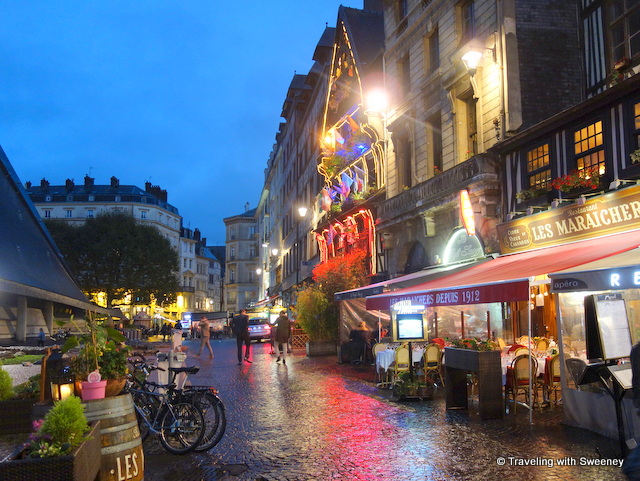
Place du Vieux Marché at night — Rouen, France
As we often do when first arriving in a new place, we checked in to the hotel and then walked around the area getting a sense of the place. Arriving in the mid-afternoon, we had a quick lunch and then walked around town for a few hours before heading back to the hotel to refresh and get ready for dinner.
Rouen highlights
Place du Vieux Marché — This is the famous square where Jeanne d’Arc was burned at the stake. A church, Eglise Jeanne d’Arc, stands on the spot where her terrible death occurred.
Cathédrale Notre Dame de Rouen — Built between the 12th and 16th centuries, this is the city’s iconic Gothic cathedral. Art enthusiasts may also know that it was the inspiration for a series of Monet’s paintings.
Historical Jeanne d’Arc — A must-see in Rouen, this is an immersive experience that takes you through the investigation and trial of Jeanne d’Arc in a series of rooms in the Archbishop’s Palace on Rue Saint-Romain where her trials took place.
Gros Horloge (the Great Clock) — The 14th-century astronomical clock is easy to spot in an arch above Rue du Gros-Horloge. Take the stairs to the Gothic belfry to get a look at the workings and history of the clock plus great panoramic views of the city.
Where we ate
Favorite meal: La Petite Auberge serves authentic French (particularly regional) dishes in a cozy half-timbered building. We had lunch here and would love to go back for dinner sometime.
Honorable mention: Cancan is a contemporary bistro and bar on the Place du Vieux Marché.
Place to start the day: Dune, a cafe on Place de La Pucelle, is a great place to start the day with delicious coffee and croissants. We also appreciated the friendly service.
Famous restaurant tip: Although we didn’t dine here, La Couronne is high on the radar for many tourists as the oldest restaurant in France and because of Julia Child who said about her meal there in 1948:
In all the years since the succulent meal, I have yet to lose the feelings of wonder and excitement that it inspired in me. — Julia Child, My Life in France
Where we stayed
Hotel de Bourgtheroulde, 15 Place de la Pucelle — Part of the Marriott’s Autograph Collection, Hotel de Bourgtheroulde is a contemporary hotel in a 15th-century historic stone mansion. The location is great for exploring the city on foot to visit all of the places mentioned above.
Day 3 – Rouen to Bayeux
As we did not plan on visiting attractions around Rouen where a car would be needed, we decided to travel once again by train to our next stop in Normandy — Bayeux. It is about a 2.5 hour journey including one transfer in Caen. Bayeux is an excellent place to make your base for visiting the Normandy D-Day sites .
Bayeux Highlights
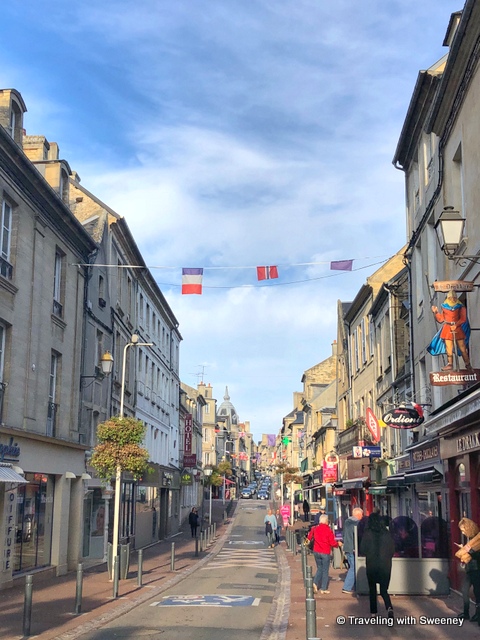
Rue Saint-Jean, Bayeux — Normandy region of France
Bayeux Tapestry — This beautiful 11th-century 70-yard long tapestry is a must-see attraction while in Bayeux. It depicts William the Conqueror’s story as duke and king, through battles, victories and other dramas of the Middle Ages.
Bayeux Cathedral — This Romanesque and Gothic cathedral is a commanding sight in Bayeux with beautiful decor, particularly seen in its stained glass windows. Some of the pieces above the altar are from the13th century.
Battle of Normandy Memorial Museum — The museum is an excellent place to start a visit to Normandy’s historic sites relating to World War II and the Battle of Normandy. There are many exhibits of wartime gear including uniforms, weapons, communications equipment, and vehicles.
Day 4 – Bayeux and D-Day Beaches
This is where the driving portion of our trip begins. We took a taxi (about 7 euros) from the hotel to the Hertz rental location at the Total Petrol station in town. From there, we traveled about 20 minutes to Arromanches, the first of our D-Day sites. Refer to our previous post about the Normandy D-Day sites for more information and photos. The map below gives you a general idea of the locations visited. It’s not an exact representation of the routes taken.
D-Day sites highlights
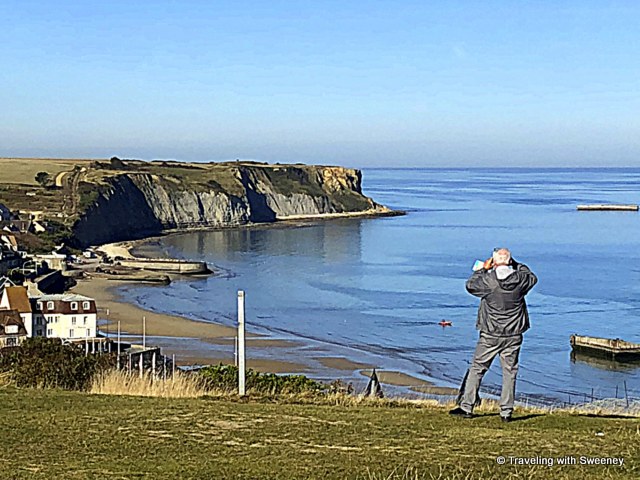
Arromanches, France
Arromanches — The village of Arromanches was a key location for D-Day operations. From the clifftop above the village, there are vistas of the English Channel and remnants of the concrete caissons that formed the Mulberries (artificial harbors) that were vital in getting Allied vehicles and equipment to shore. On the clifftop, there is also the Arromanches 360 cinema, where you can watch an excellent film, “Normandy’s 100 Days”. Also take time to visit the D-Day Landing Museum in the village.
Longues-sur-Mer — Near the village of Longues-sur-Mer is the Batterie Allemande de Longues-sur-Mer, a German gun battery and lookout bunker that was strategically positioned for views of the English Channel and approaching Allied forces.
Omaha Beach — In Vierville-sur-Mer, walk along the same wide expanse of sand at Omaha Beach that U.S. troops crossed on D-Day. Of the five D-Day beaches, Omaha Beach saw the greatest casualties with about 2,400 troops killed, wounded, or missing in action.
American Cemetery — The cemetery is located in Colleville-sur-Mer on the site of the original burial grounds established by the U.S. Army on June 8, 1944 to bury their dead. This is a must see and provided the most moving experiences during an emotional day. We recommend checking the time for the flag lowering which was the highlight of this experience.
Hôtel le Lion d’Or, 71 Rue Saint-Jean — It’s said that this was General Eisenhower’s favorite place to stay in Bayeux. All I know for sure is that we really liked it. But here’s a heads up for summer visitors — there is no air conditioning in the hotel’s 31 rooms.
La Marine — While seeing the sights in Arromanches, we stopped for lunch at La Marine Hotel on the beachfront. The food is very good and there are nice views of the village, beach, and surrounding cliffs.
La Rapiere, 53 Rue Saint-Jean — It was at this small restaurant where we had our favorite meal in Bayeux. La Rapiere serves regional dishes in a very cozy setting. It gets very busy, so be sure to make a reservation.
Patisserie Ordioni, 25 Rue Saint-Jean – For pastries and coffee before a day of sightseeing, try this wonderful bakery that was recommended to us by a local.
Day 5 – Bayeux to Dinan via Mont St. Michel
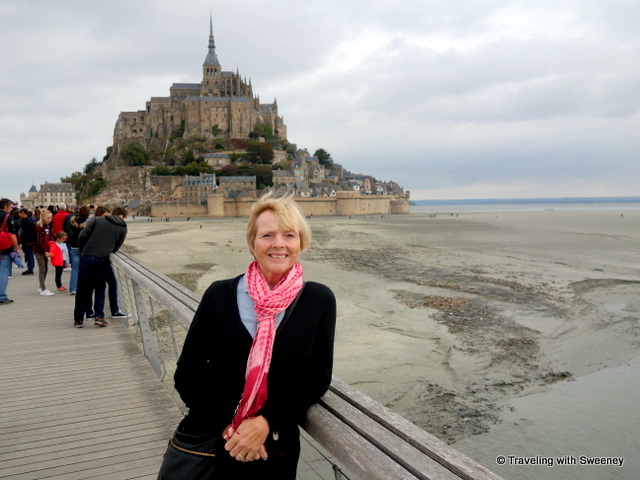
Mont St. Michel
Mont Saint-Michel — This important historic site about 73 miles from Bayeux was our final stop in Normandy. We spent about 3.5 hours, including a quick lunch, exploring the island of Mont Saint-Michel, its abbey (first built in the 8th century) at the top and the winding streets of the village surrounding it. From Mont Saint-Michel, we drove about 36 miles to Dinan where we checked in to our hotel, strolled a bit around town and had a lovely dinner at a nearby restaurant.
Day 6 – Dinan
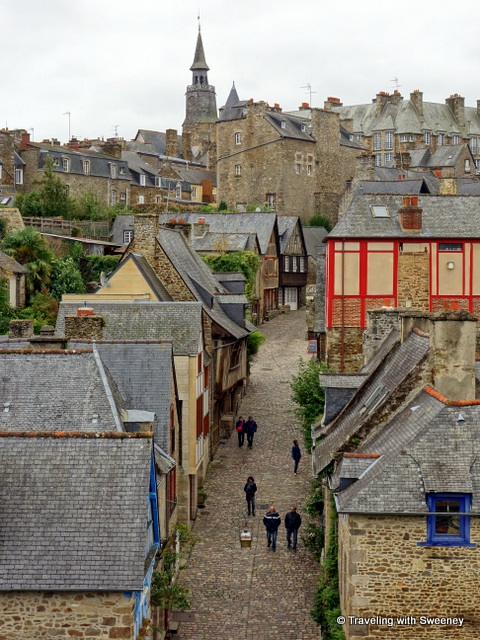
Strolling a cobbled street in Dinan, France
Dinan Highlights
We felt that a full day of exploring Dinan on the Rance River was sufficient to at least get a look at the main attractions and feel the town’s charming ambiance. However, if you have more time, an extra day or so here would be a good addition to this itinerary. Refer to our previous post with detail about this charming town and main attractions and activities, including the Basilica of St. Sauveur, English Garden, walking the ramparts and riverside path to Léhon, and browsing the shops and galleries lining the cobbled streets from Place St. Sauveur down to the riverside.
La Maison Pavie, 10 Place St. Sauveur — This is a bed and breakfast located in a historic 15th-century half-timbered house on Place St. Sauveur across from the basilica. It has five spacious and beautifully-decorated guest rooms.
Favorite meal : Le Cantorbery, 6 Rue St. Claire — This charming and intimate restaurant is located in a 17th-century house on a quiet street near the old town square. Service was impeccable and the regionally-inspired courses were and deliciously prepared.
Day 7 – The Brittany Coast
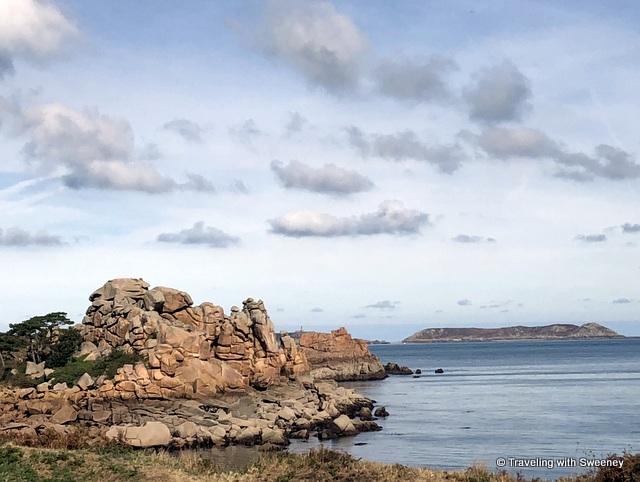
Perros-Guirec on the Brittany coast, France
We were looking to round out our northeast France trip with a coastal experience. There are many choices for diverse scenery and available activities along the Breton coast.
What we saw
Perros-Guirec — This gorgeous area of the Brittany coast is called the Pink Granite Coast . There is a wonderful trail along the coast through the abundant rock formations with gorgeous English Channel views. We had about three hours to spend in the area for the walk and lunch on the harbor.
Then it was on to Combrit (a little over two hours via inland route) where we would spend the night.
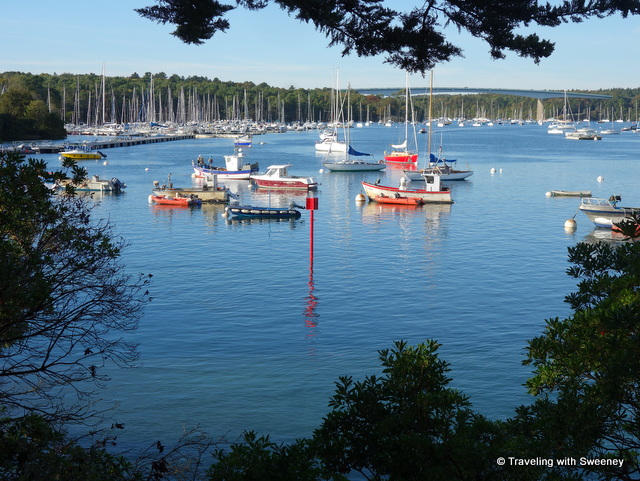
The harbor at Combrit, France
Combrit — There are numerous cities and locations that we could have chosen for our last night in the Brittany region, but Mr. TWS loves water and coastal vacations and came across an ad for an inn in the small village of Combrit. Being off-season for Combrit, a very popular spring and summer getaway spot, it was very quiet when we visited and quite affordable.
Basically, our time in Combrit was a brief, but enjoyable, chance to just relax and soak up a coastal resort town’s ambiance (albeit in the off season). After check-in at our hotel, we took a long, leisurely walk along the harbor and through some residential neighborhoods of this small village.
Villa Tri Men, 16 Rue du Phare — Villa Tri Men is a lovely inn with 33 rooms. As one of only two couples staying in the hotel that night, we got a beautiful large room with a wrap-around terrace and views overlooking the harbor. One of the wonderful benefits of traveling in the off season!
Le Bistrot du Bac on the port of Sainte-Marine — The restaurant at the hotel was not open on the night we arrived, but the bistro (also run by the owners of the hotel) was perfect for drinks on the patio and later dinner inside. It was the only choice in town, but it was a good one.
On to Paris
Then it was on to Paris for three days . We returned our rental car to the Hertz location across from the railway station in Quimper (13 miles from Combrit). From there we took the train to Gare Montparnasse in Paris.
Whether you follow in our footsteps or make changes that suit your trip plans, I know that you’ll love visiting the Normandy and Brittany regions of France.
Related posts:.

- ← Chicago: My Kind of Town at Christmas
- Uzbekistan Photography Workshop →
18 thoughts on “ Highlights of a 7-Day Normandy and Brittany Itinerary ”
Our visit to Normandy was my favorite visit to France. We also used Bayeaux as a base for exploring the history of D Day. We used a tour company called the Battle Bus at the time for a 2 day small mini van tour that in large part traced the sites featured in the series Band of Brothers. When we weren’t in 1944, I visited the Bayeaux Tapastry Museum for a quick trip back to 1066. We also rented a car to visit Mount Ste. Michel and do a loop of some of the quaint towns. Nice memories.
Bayeux really is a great place to use as a base to visit the area. Thanks for the tip about Battle Bud. That might definitely be of interest to some of our readers.
Is driving difficult in the Normandy area ? We are wanting to rent a car in Caen and drive to Mont St Michelle, Honfleur, Omaha Beach area, etc?
One of our favorite places in the world. We’ve been to Normandy a few times and spent a week biking in Brittany last year. The landscapes are lovely, of course, but the highlights for me were the Bayeux Tapestry (I’m a Latin geek) and the Normandy beaches, including Pointe du Hoc. Pointe du Hoc is interesting because the French haven’t restored the site to its pre-battle condition. Shell craters, barbed wire, bunkers and gun mounts are still there.
Thanks for the info about Pointe du Hoc. We didn’t get there this trip and will definitely put it on the next itinerary in the region.
What an action filled time you had exploring the coastal region in France. I can only imagine how historic the visit to Normandy must have been. Thanks for including your top spots in each location. It will make travel planning much easier.
I’m so glad that the post will help you with your travel planning for Normandy and Brittany!
Super post! Normandy and Brittany is a region of France that I have not yet visited. There is obviously much to see, do, and enjoy!
I think we’d love following your itinerary here, so many quaint villages and stops along the way. I’d especially love Rouen I think. Thanks for so many good details on where to stay and sites to see. Bookmarking this one for later!
Thanks for this. We stayed nearby to Dinan a couple of years back and we really enjoyed the towns along the Emerald Coast west from S. Malo – it’s a beautiful drive with lots of little coves and bays – as well as the inland towns and even the larger cities such as Rennes. The town we stayed in was Pleudihen-sur-Rance and the local boulangerie was famed for its pastries. A short walk to the river and there was a local seal who could be found resting on the boat ramp. Great place.
Great detailed post! I love your photo of the Mont Saint-Michel. I’ll be saving this for future reference. I hope we can visit this year. I’m falling in love with the streets of Dinan.
About 20 years ago we stayed in Arromanches and really enjoyed the area. Three years ago we took the kids and stayed for a week near Dinan and ventured around to the nearby towns. We loved Brittany. So diverse – a brilliant coastline with picturesque villages and little coves and inland the towns were equally as lovely.
Mont St. Michel looks amazing. I’ve never even heard of Dinan before – thanks for the inspiration.
Pingback: A Walk on the Pink Granite Coast of Brittany | Traveling with Sweeney
Thanks for posting the itinerary. Hope to do a very similar trip. Just not sure about driving the area. Any problems with signage, left side of the road, etc? Planning to take the train from Paris to Caen or Bayeux and renting a car and driving the area. Thoughts or suggestions?
Hi Lisa – Definitely try to do a trip in the area. I’m happy if this itinerary can provide you with some ideas. We didn’t plan on spending any time in Caen, so found it best to rent the car from Hertz in Bayeux where we were staying. It was easy to get to the D-Day sites from there. In fact, if you’re going to see the D-Day sites, renting a car is really the best option unless you want to get with an organized tour. We liked the flexibility of being on our own. It was also nice not to have to drive around a bigger city like Caen. Driving around the areas of Normandy and Brittany that we visited was easy (in my opinion — I love to drive!).
Catherine, I will be traveling to Brittany Oct 29 to Nov 6 with my 90 year old parents. What time of year were you there? My Father lived in Brittany and Paris during WWll, and I am not sure he’s up for Normandy. And do you have other ideas for us? Thank you and I am looking at the hotels you suggested as well. And the dining!!
Hi Ann — Sounds like you have a very special trip coming up. It will probably be quite sentimental for your father. We were there at the beginning of October and the weather was beautiful.There was one very rainy day, but it didn’t deter our spirits as we walked around Mont St. Michel (on the border of Normandy and Brittany). I don’t know if you saw my post about Dinan, but that would definitely be a town I would visiting in Brittany. I also did a separate post about The Pink Granite Coast that I mention in this article. It’s a beautiful area to see. If your parents may not be up for walking on the path there, it’s still worth a visit — particularly if you’ll be driving and can easily get around. If we’d had more time, I would have liked to visit St Malo, Cancale and other coastal towns. I hope this helps! Please let us know how you enjoy the trip.
Leave a Reply Cancel reply
Your email address will not be published. Required fields are marked *
This site uses Akismet to reduce spam. Learn how your comment data is processed .
- Top Destinations
- Mexico City, Mexico
- Tokyo, Japan
- Paris, France
- Rome, Italy
- London, United Kingdom
- All Destinations
- Upcoming Experiences
- Walking Tours
- Small-Group Tours
- Tours for Kids
- Museum Tours
- Food, Wine and Market Tours
- Newly Added Tours
- Audio Guides
- Pre-Trip Lectures
- Admin Dashboard
- My Favorites
- Cookies Preferences
- Client Orders
- Monthly Commissions
- My Advisor Profile
- Advisor Toolkit
- Guide Dashboard
Credit Balance
Transactions are based on current exchange rates and performed in USD. There maybe slight variations in the price estimates.
Visiting the D-Day Beaches: With Normandy Beach Map

Learn more about the historic Normandy Beaches during Context's Full-Day Private Tour with Private Car Service
Over one million people visit the beaches of Normandy every year to pay respects to the soldiers who lost their lives and experience the site of one of World War II’s most crucial turning points.
When was the D-Day Invasion?
D-Day, also known as Operation Overlord, was a significant event in history that took place on June 6, 1944. It marked the beginning of the Allied invasion of Normandy during World War II – which continued until July 24, 1944.
On this day, a massive amphibious assault was launched on the beaches of Normandy, France, by British, American, Canadian, and other Allied forces. D-Day represented a pivotal moment in the war, as it opened a crucial front against Nazi Germany and ultimately led to the liberation of Western Europe from the control of the Axis powers.
If you’re interested in touring this historic site, here’s what you need to know about planning a visit to the D-Day beaches in Normandy.
Can you visit D-Day Beaches?
Visitors can walk the beaches, but those inclined to learn more about history can visit dozens of nearby museums and monuments. Planning ahead will help you optimize your itinerary and ensure you get the most out of this impactful experience.
Context offers a Full-Day D-Day and Normandy Beaches Tour so you can explore key Normandy landmarks, including Normandy Landing Beaches, Pointe du Hoc, Omaha Beach, The Normandy American Cemetery and Memorial, and the Mulberry Harbour at Arromaches.
An expert on D-Day history leads the full-day tour, and it is a meaningful and educational opportunity to learn more about the events of June 6, 1944 and their impact on European liberation.

What were the 5 beaches on D-Day?
Code-named Operation Overlord, the Allied Operation included over 156,000 American, British, and Canadian troops landing on five beaches along a 50-mile stretch of coastline occupied by Germans. This meticulously planned amphibious military assault is widely considered the turning point in World War II and ultimately led to the liberation of France and the rest of Western Europe.
1. Utah Beach
Utah Beach was a last-minute addition to the plan due to its proximity to Cherbourg, a port city. Sadly, many U.S. paratroopers perished when their heavy equipment weighed them down in the flooded marshlands near the beach. Others landed outside their drop zones, but they eventually secured the beach’s only four exit points.
2. Omaha Beach
Because U.S. troops suffered massive casualties at Omaha beach, it is named the bloodiest beach on D-Day. About 2,400 U.S. troops were dead, wounded, or missing once the battle ended. Omaha beach was flanked by steep cliffs and was heavily defended, making it a perilous and devastating battle scene.
3. Gold Beach
British troops stormed Gold Beach, located in the middle of the five D-Day Beaches, about an hour after Utah and Omaha (due to the direction of the tides). While the Germans initially had a stronghold on the beach, British warships, aerial attacks, and armored vehicles proved victorious.
4. Sword Beach
Canadian and British troops invaded Sword Beach’s eastern flank and took out key bridges to prevent German reinforcements from arriving. The Germans answered with moderate fire, but the British and Canadian troops took out critical German artillery resources.
5. Juno Beach
Rough seas made for a challenging landing at Juno Beach, giving German soldiers the initial upper hand. Canadian troops faced monumental casualties as Germans fired from seaside bunkers. However, as soon as German resistance slowed, Canadians quickly advanced inland and captured several towns.

World War II Sites to Visit in Normandy
Did you know that D-Day was only the beginning of the Allied Invasion of Normandy? For twelve more weeks after June 6th, Allied forces continued to fight . Normandy played a large role in World War II, so it's no surprise that history buffs flock to the area to see the many significant locations across this region firsthand.
Omaha Beach
The serenity of Omaha Beach today starkly contrasts the violent scene that occurred here nearly 80 years ago. Visitors walk the coastline and honor those who lost their lives in a wartime battle that lives in infamy.
Visitors can also see remnants of the artificial harbor constructed by the Allies, known as Mulberry Harbour, and view the German bunkers and fortifications that remain on the beach. There are also several museums in the area, including the Omaha Beach Memorial Museum.
Normandy American Cemetery
Just beyond Omaha, the Normandy American Cemetery honors the American troops who gave their lives on the D-Day beaches. It is a poignant way to pay tribute to the legacy of those U.S. troops who never had the opportunity to return home.
Each of the 9,386 headstones contains the name, date of death, service unit, and country where he volunteered, except for the 307 who have no name. There is also a monument to the 1,557 servicemembers whose mortal remains were lost.
Caen Memorial Museum
As you make your way across the D-Day sites, plan a visit to the Caen Memorial Museum . The Museum focuses on the Battle of Normandy and 20th-century history, offering visitors unique insights into the events that marked World War II.
With a range of exhibits that provide a glimpse into the wartime life of troops and civilians, the Museum offers multimedia experiences, films, and a firsthand look at personal items from soldiers.
Arromanches-les-Bains
Today, this picturesque town is known as a seaside resort, but its coast, Gold Beach, played a major role in the Normandy landings.
Gold Beach was one of the beaches designated to receive man-made landing harbors on D-Day, also known as Mulberry Harbours. The harbors were specially created to float across the English Channel and serve as temporary harbors on D-Day. Many of the large concrete blocks remain in Arromanches today as a reminder of its significance to World War II.
Longues-sur-Mer
Longues-sur-Mer was a battery built by the German navy and strategically positioned between the Omaha and Gold Beaches. On D-Day, Longues-sur-Mer was the site of an extended gunfight between the Allied fleet and the Germans. British troops eventually landed at Gold Beach and captured both the position and the surviving German soldiers.
Visitors today can see the original cannon and take in the view from the firing command. Longues-sur-Mer is one of the best-preserved World War II sites anywhere in France, giving visitors an unparalleled view not just of the Bay of Seine, but of what life was like on that fateful day in 1944.
Map of D-Day Beaches
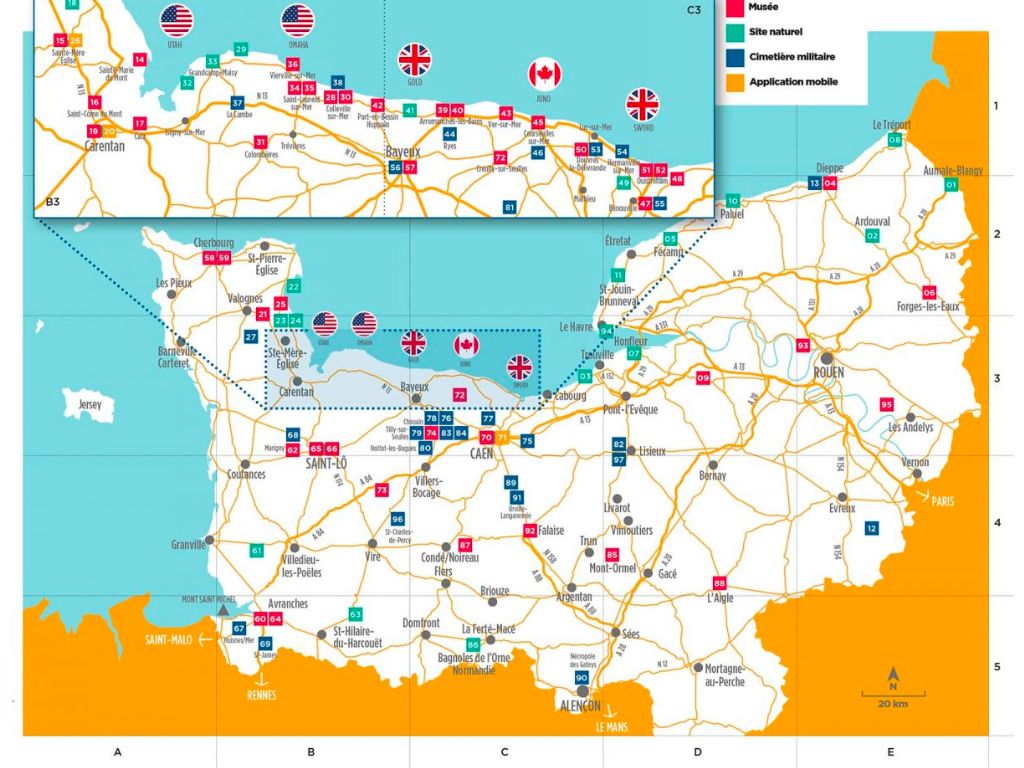
Each beach has its own unique history, and as you examine the map you’ll gain a deeper understanding of the scale and scope of this historic operation.
To look at a Normandy Beach map is not just a lesson in geography; it’s a lesson in understanding what happened on June 6, 1944. Looking at the map, you can imagine the struggles, triumphs, and heart-wrenching losses suffered on the sand.
Whether you’re zooming in for a closer look at each beach’s remaining craters, or as you stand in person on the hillside above a neverending sea of white headstones, you’ll come away with a sense of gratitude, awe, and respect for those who gave their lives on the beaches of Normandy.
Tips and Tricks for Visiting the Normandy Beaches:
- Hire a Context Tour Guide, with Private Car Service: A knowledgeable local historian can offer unique insights into each landmark’s significance to WWII and provide you with a more personalized experience. Additionally, while it is possible to visit the beaches using public transportation, it's much more convenient to rent a car and book a tour. This will give you more flexibility to explore the area at your own pace.
- Dress appropriately: Wear comfortable clothes and shoes for walking, and bring a jacket in case it gets cold or rainy. Because you will be along the coastline, wind gusts can be an important factor when planning your wardrobe.
- Pack snacks and water bottles: Weather conditions can be brutal, especially during the summer. While most museums do offer concessions, it’s important to be prepared with adequate water and snacks to keep yourself comfortable throughout the day.
- Consider visiting early or late in the day: To avoid crowds, it's best to visit the beaches early in the morning or later in the afternoon.
- Allow plenty of time: Plan to spend a full day or more exploring the Normandy beaches. There is a lot to see and learn, and rushing through the sites won't do them justice. You’ll also want to consider the seasonal tides so that you can safely walk along the beaches.
- Respect the sites: The D-Day beaches and surrounding areas are sacred places. Show respect by not littering, staying on designated paths, and not disturbing any artifacts.
- Take a moment for reflection: The D-Day beaches are solemn places that hold somber historical significance. Take a moment to reflect on the sacrifices made by the thousands of brave souls who fought and died there.

Tour the D-Day Beaches
Enhance your Normandy experience with a guided tour of the D-Day Beaches with a local expert. Our Full-Day D-Day and Normandy Beaches Tour has exclusive insights into World War II history to ensure you leave Normandy with a complete understanding and appreciation for its pivotal role in the war.
If you’re looking for other opportunities to learn more about Normandy, take our Full-Day Mont-Saint-Michel Tour and see this gravity-defying medieval monastery with an expert guide.
Learn more about the Normandy Beaches with Context Learning
Are you planning a trip to France? Check out Context’s Upcoming Online Seminars and Courses about France – which feature local experts in WWII History, Archaeology, and Art History.
Or, stream French History and Culture content instantly through Context On-Demand – hosted by the same local experts who lead our tours.
You May Also Like:
- Exploring the Coast of Normandy: Top Sites for History Lovers
- Timeline of the Normandy Invasion
- Reflections on the 75th Anniversary of D-Day
- 10 Best Day Trips from Paris
- Vive la France: Bastille Day
- How to Spend 36 Hours in Paris
Read More Stories
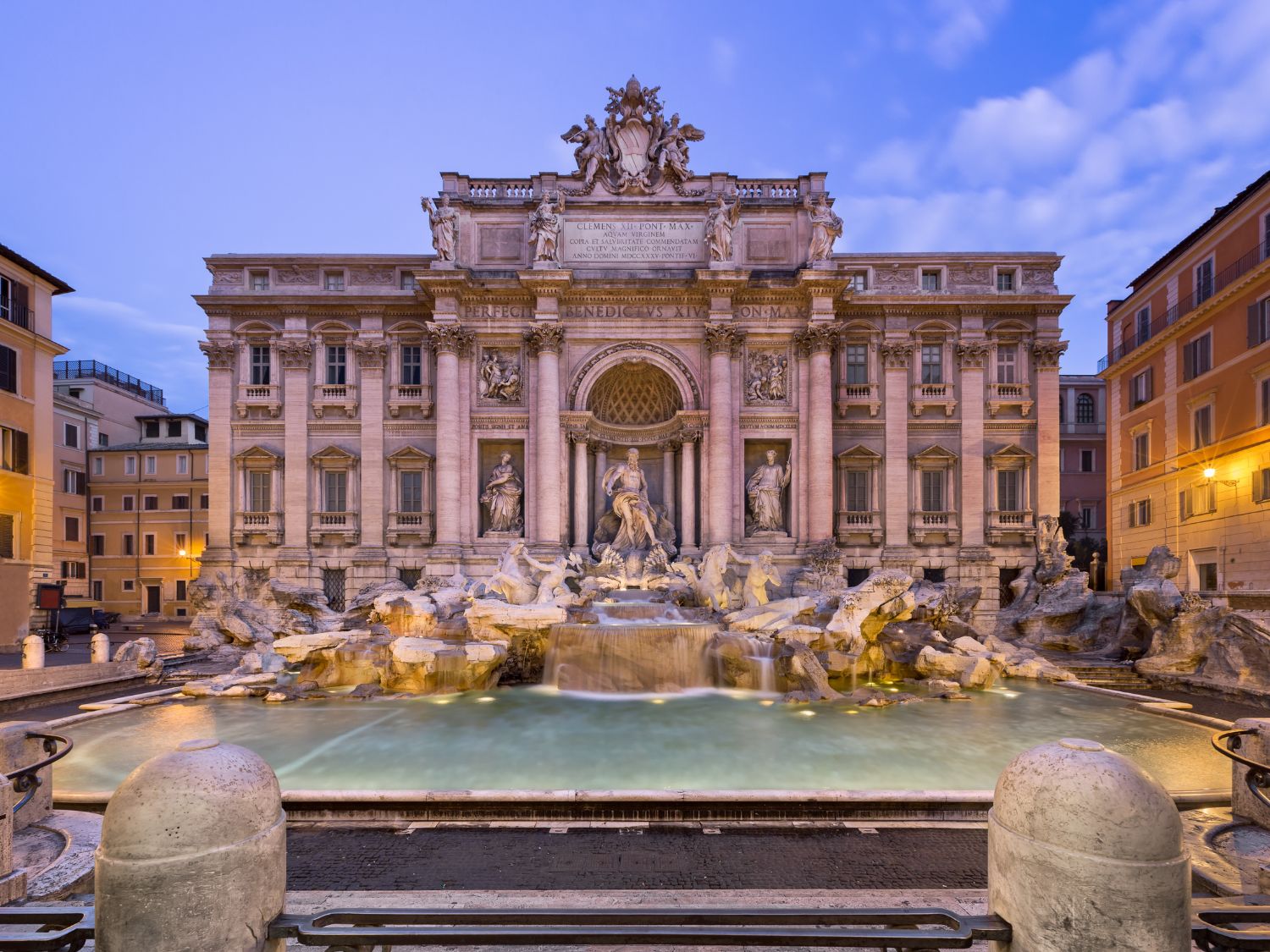
Even More from Context
Subscribe to our Newsletter
Keep Exploring

Explore Tours
Join walking tours with top experts all over the globe.
Browse Our Cities
- Our Experts
- Working with Context
- View All Cities
- Sustainable Tourism
- Refer a Friend for $50
- Travel Updates
- Advisor Login
- Expert Portal
- Privacy Statement & Security
- Cancellation Policy
Commonwealth war graves commission Caring for the fallen
Commonwealth war graves Foundation Our charity site

- Search in War Dead
- Search in Cemeteries and Memorials
- Search in Website
Visiting the beaches of Normandy – WW2 guide
29 April 2024
Thinking of visiting the Normandy D-Day beaches? Here’s a handy guide on everything you need to know.
Normandy D-Day beaches to visit
With the Normandy 80th anniversary on its way, why not make a trip to see D-Day's landing beaches?

Where is Gold Beach?
Gold Beach was one of three Normandy landing beaches assigned to the Commonwealth forces on D-Day.
The landing zone stretched 8 kilometres from Port-en-Bessin in the west to La Rivière, Ver-sur-Mer in the East. The seaside resort of Arromanches lay in the west of the landing zone. Deeper inland from Gold sat the historic town of Bayeux.
History of Gold Beach
Wehrmacht forces occupying Gold Beach were tucked away in houses along the coast, particularly at La Rivière and Le Hamel. The landing beach was also in range of a gun battery located a kilometre inland, directed from a clifftop observation post at Longues-sur-Mer.
Gold comprised three sectors, running west to east: How, Item, Jig, and King. It was to be assaulted by the 50th (Northumbria) Division.
The 50th Division’s objectives were to capture Arromanches, cut the Caen-Bayeux Highway, and link up with the Canadians from Juno Beach in the east and the Americans from Omaha to the west.
Landing craft from the 50th Division hit Gold Beach at 7:25 am on the morning of D-Day. German defences had been softened by RAF and Royal Navy bombardment before the assault.
The infantry was supported by tanks and specialist Armoured Fighting Vehicles Royal Engineers (AVREs) to help clear beach obstacles and defences.

Image: 47 Commando comes ashore on Gold Beach, 6 June 1944 (© IWM)
At the same time as the main infantry assault, special forces of 47 Commando came ashore too. Its target was to capture the small harbour at Port-en-Bassin at Gold Beach’s western edge.
No German tanks were present on Gold Beach. Infantry resistance was minimal compared with other D-Day landing beaches. The Royal Navy and Air Force bombardments had softened up defences enough.
German forces at La Rivière had been subdued by 10.00 am. By mid-afternoon, Le Hamel had been captured. 47 Commando had pushed towards its objective at Port-en-Bessin but was unable to take the small port on D-Day itself.
One of the supporting Royal Navy vessels, HMS Ajax, had taken out the Longues-sur-Mer battery after a furious long-range duel.
By the evening of D-Day, the 50th Division had landed 25,000 men. The British had pushed 50 kilometres inland. They had also linked with the Canadians advancing from Juno Beach, but they had so far failed to cut the Caen-Bayeux highway.
The forces at Gold made a good start, securing an important beachhead for 400 casualties.
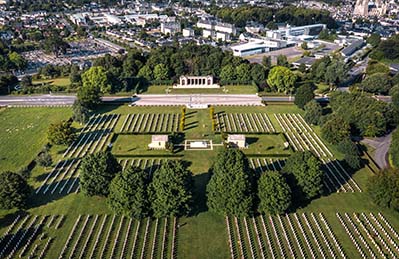
Bayeux War Cemetery
Bayeux War Cemetery , although started in 1952, has become one of the focal points for the commemoration of the Normandy campaign’s Commonwealth war dead.
Over 4,500 war graves can be found in Bayeux War Cemetery. D-Day war graves total around 500 of the Commonwealth burials here.
Within Bayeux War Cemetery stands the Bayeux Memorial, commemorating fallen officers and enlisted men with no known war grave. 1,800 servicemen are commemorated by name on the memorial.
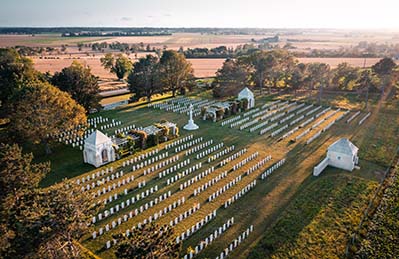
Ryes War Cemetery
Ryes War Cemetery lies close to Arromanches.
The first burials at Ryes were made just two days after the landings on Gold Beach.
Today, it contains around 650 Commonwealth war graves, roughly a sixth of which were casualties killed on D-Day itself. Interestingly, there are around 330 German graves at Ryes War Cemetery .
Getting to Gold Beach
Gold Beach is accessible via public transport using Normandy’s transport network or by road.
For travellers from the UK, the fastest direct route to Normandy D-Day beaches is by ferry from Portsmouth.
The vessel docks at Ouistreham, taking you directly into the heart of the D-Day battlefields and landing beaches.
From Ouistreham, Arromanches and Gold Beach is about a 40-minute drive. Depending on traffic, it takes but takes around four hours when driving from Calais. Reaching Arromanches and Gold Beach from Cherbourg takes roughly an hour and a half.
Sword Beach
Where is sword beach.
Sword Beach was the most easterly of the Commonwealth Normandy landing beaches on D-Day.
It lies on an 8-kilometre of the Normandy coast between Lion-sur-Mer in the west and Ouisteham in the east. It is around 15 kilometres away from Caen.
Sword Beach was and is very sandy, turning into dunes. In 1944 It had only been lightly fortified with beach obstacles and emplacements, although German defences stretched inland.
An artillery battery at Merville, 8 km to the east, overlooked the beach. A range of mortars, 88m guns and machine guns were also built inland.
History of Sword Beach
Sword Beach was divided into four sectors for the D-Day assault. From west to east, they ran Oboe, Peter, Queen, and Roger.
Assaulting Sword were the men of the British 3rd Division, made up of regiments including the Suffolks, South Lancashires, and East Yorkshires to name a few. Accompanying the main assault were the special forces units from the 1st and 4th Special Service Brigades.
3rd Division’s D-Day objectives were to land and push up the beaches to pass through Ouistreham. Caen, as the region’s major transport hub, was 3rd Division’s chief objective, however.

Image: 8.45am Sword Beach, 6 June 1944 (© IWM)
The special forces were to push inland toward the Orne River and Caen Canal Bridges and link up with Airborne forces already in Normandy.
Seaborne forces’ landing craft hit Sword Beach at around 7.25 am. Fighting on the beach was relatively light. Within 35 minutes, Sword had been cleared and combat moved inland.
In the early afternoon, the Commandos had managed to link up with the men of 6th Airborne.
6th Airborne had been in Normandy for hours already, dropping in behind enemy lines around midnight. It was their job to the Orne and Caen bridges to provide exit routes for the forces assaulting Sword Beach. Other units were assigned to knock out the Merville battery.
Both airborne objectives had been achieved by the time the amphibious assault began, making it easier for the regular army units to come ashore.
By the end of June 6th, the British had landed some 29,000 men on Sword Beach. Taking the beach and subsequent fighting cost the British around 630 casualties.
Caen remained out of British hands until the end of July 1944.
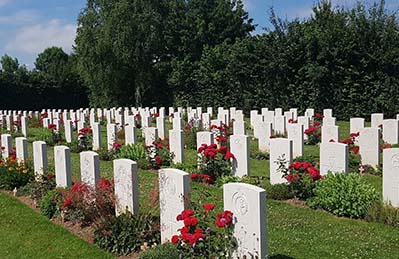
Hermanville War Cemetery
Hermanville War Cemetery contains many D-Day war graves , representing roughly a quarter of the 1,000 burials in the cemetery.
Hermanville is a small village that lies a short way behind Sword Beach.
It was occupied early on D-Day by men of the South Lancashire. Later that day, the Shropshire Light Infantry and tanks of the Staffordshire Yeomanry managed to capture Bieville-Beniville, around 4 kms to Hermanville’s south.
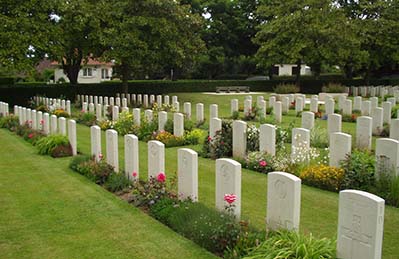
La Deliverande War Cemetery, Douvre
La Deliverande is only a short distance from Sword Beach, situated to the west of Hermanville.
The war cemetery was started not long after D-Day, with casualties from Sword Beach buried here, drawn from the beach’s Oboe and Peter sectors.
Over 1,020 personnel are buried at La Deliverande War Cemetery .
Getting to Sword Beach
Ouistreham is the quickest way to get to Sword Beach and the quickest way for UK visitors is via Portsmouth. The ferry from Portsmouth docks at Ouistreham.
Sword Beach is around three and a half hours by car from Calais and roughly the same by car from Paris.

Where is Juno Beach?
Juno Beach lies between Gold Beach to the west and Sword Beach to the East.
The landing zone stretched across a 10-kilometre front, stretching along the small fishing port of Courseulles-sur-Mer.
Several small conurbations and villages lay behind the beach’s sandy dunes or dotted the seafront. German forces occupied and fortified them with gun emplacements, fighting positions, and casemates.
Hidden beneath the sea on the approach to Juno were several natural obstacles, including reefs and shoals, making the approach tricky to navigate.
History of Juno Beach
Juno Beach was the third assigned to Commonwealth armies for Operation Overlord. The Canadian Army was tasked with taking Juno and forging inland, specifically the 3rd Canadian Division.
The Canadian D-Day objectives were to cut the Caen-Bayeux road, take the important Carpiquet airfield near Caen, and then link up with British troops making their way off Sword and Gold beaches.
Because of the natural hazards, Allied planners had to launch the Canadians later than desired so their landing craft could clear the reef on the rising tide.
The Canadians landed on Juno at 07.55 am on the morning of June 6th 1944. Not only were they 10 minutes behind schedule, but they were also three hours behind the optimal tide height.

Image: Canadian soldiers leave their landing craft on Juno Beach (© IWM)
This gave the Canadians a problem. Juno was littered in now partially submerged beach obstacles. The Royal Canadian Engineers were unable to clear an unobstructed path to the beach so landing craft pilots had to navigate by feel to get their men to shore.
Mines took a heavy toll on the Canadian landing craft. 30% of Juno landing craft were damaged or destroyed.
In contrast to Sword and Gold, the Canadians had a much tougher time getting off the beach. The German defences were more focussed on overlooking the coastline, rather than firing out to sea.
As the Canadian infantry made its way up Juno Beach, it came into enemy killing zones which reaped a terrible toll on the first wave. In the first hour of the assault, there was a 50/50 chance that each Canadian soldier become a casualty.
The Canadians never wavered, however, and by mid-morning they had captured the town of Berniéres and Saint-Aubin, getting off the beach.
Progress into Normandy was good. Success infantry waves supported by Canadian armour meant that by the end of the day, the Canadians had made the most progress of any Allied army in Normandy.
But that progress was not without cost. Off the Commonwealth forces on D-Day, the Canadians took the highest casualties, suffering 1,200 casualties (340 killed) for 21,400 troops landed on Juno.
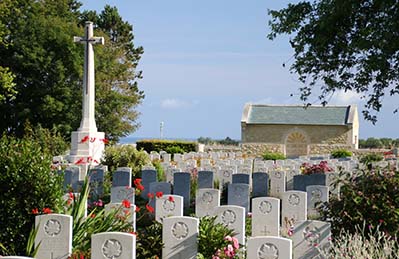
Beny-sur-Mer Canadian War Cemetery, Reivers
Beny-sur-Mer Canadian War Cemetery contains over 2,000 Second World War graves .
As the name suggests, most of the war graves in Beny-sur-Mer are Canadian.
Roughly 300 were killed on D-Day, either on Juno Beach or as the fighting turned inland.
How to get to Juno Beach
Most Canadians visiting Juno Beach will arrive in France via Charles de Gaulle Airport, around 25km north of Paris. From there, the quickest route would be a direct train to Caen or a three and hour drive from Paris.
Visitors from Britain are best to catch the ferry to Ouistreham as this will take you directly into the D-Day invasion area. Juno Beach is then a 25-minute drive, depending on traffic.
Reaching Juno Beach from Calais is roughly 3 hours and 45 minutes by car. From Paris, it can take up to 3 and a quarter hours, depending on traffic.
Omaha Beach

Where is Omaha Beach?
Omaha Beach was one of five landing beaches of the Normandy invasion. It was one of two assigned to the United States.
Omaha Beach stretched from Port-en-Bessin in the east to the mouth of the Vire River in the west, covering 10km.
The landing beach was overlooked by 30-metre-high cliffs. Some sections of the western beach were backed by a strong, 3-metre-high seawall as well. German Field Marshal Erwin Rommel had ordered Ohama Beach to be fortified as part of his Atlantic Wall.
The waters were mined, and beach obstacles were laid. German machine gunners peaked out over the beach from vast concrete bunkers and redoubts. Up the cliffs, a trench network wound its way inland.
Even today, numerous concrete strong points can be seen in and around Omaha, showing the area’s lethality.
The history of Omaha Beach
Omaha was assaulted by the forces of the US 1st Infantry Division, aka the Big Red One.
1st Division’s objectives were to capture the villages of Vierville, Saint-Laurent, and Coleville. It was to then push onwards toward the Bayuex-Isigny Road and continue heading west towards Pointe du Hoc.
The attack began at 06.30 on the morning of June 6, 1944. Choppy waters and strong winds drove landing craft off course.
Omaha turned into a killing field. American troops sought cover behind beach obstacles or wrecked vehicles, pondering whether to make the deadly run for the seawall.

Image: "Into the Jaws of Death", Robert F. Sargent's famous photo of the US 1st Division's assault on Omaha Beach (public domain)
The carnage was so bad that by 08.30, all landings at Omaha had stopped. Men on the beach were left on their own. Slowly but surely, the US soldiers began to form groups and scale Omaha’s imposing cliffs.
To alleviate the pressure, US Navy destroyers sailed up to the beach and began bombarding German positions at point-blank range.
By midday, German fire noticeably decreased as defences were flanked and taken from the rear. Allied soldiers could now begin opening each of Omaha’s five beach exits one by one.
Elsewhere in the Omaha sector, the US Rangers were given the job of assaulting Pointe du Hoc. Pointe Du Hoc is a rock escarpment jutting out into the English Channel which gave fantastic views of the American landing beaches at Normandy.
Atop were gun emplacements and casemates zeroed in on Utah Beach.
With rope ladders and grappling hooks, the Rangers scaled 100 sheer cliffs under heavy fire.
They managed to reach the top when, to their horror, they found empty casemates. Where were the big guns? Sweeping nearby, the Rangers thankfully found the German artillery, hidden in a sunken road, and disabled it.
By nightfall on D-Day, the US held ground around Vierville, Saint-Laurent and Colleville. The advance was far behind schedule, but the resistance had been incredibly tough at Omaha.
The US forces at Omaha had suffered 2,400 casualties but had managed to land 34,000 men.
How to get to Omaha Beach
Omaha Beach is around 40 minutes from Ouisreham, the disembarkation point of the Portsmouth-Caen Ferry. This would probably be the quickest way to reach Omaha Beach for UK visitors.
For those coming from Calais, the journey is roughly four hours by car.
American tourists paying a visit to the Normandy D-Day beaches are most likely to be arriving in France via Paris Charles de Gaulle Airport. By car, this will take between three and a half and four hours.

Where is Utah Beach?
Utah Beach was the most westerly of the five Normandy D-Day landing beaches.
It lies at the base of the Cotentin Peninsula, at the top of which lies the great Atlantic port of Cherbourg.
Utah covered 5 kilometres, running northwest of the Carentan estuary, along a ribbon of sandy, duned beach.
Four causeways exited Utah Beach, leading to the important crossroads towns of Carentan and Sainte-Mére-Église.
The land behind Utah is flat, open, and low-lying. To limit enemy movement, the Germans had flooded these areas and could control the flood levels with locks.
The history of Utah Beach
Of the Normandy landing beaches assaulted by US forces, Utah was the least heavily defended.
The assault began at 06.30 am, led by the IS 4th Infantry Division.
Their goal was to capture the beach, take control of the coastal roads, link up with Airborne elements dropped earlier in the day, and get ready for a later attack on Cherbourg.

Image: US troops wade ashore on Utah Beach (public domain)
The Utah landings were met with confusion. Strong currents blew the landing craft off course while the beach was obscured by smoke from the preliminary Allied naval bombardment.
Three control craft, essentially for guiding troops transports to the beach, were lost to mines.
Eventually, the Americans were able to land some 1,800 metres away from their designated area, leading commander Brigadier-General Theodore Roosevelt Jr. to declare “We’ll start the war from here!”.
This turned into a happy accident. The Americans had landed at a lightly defended section and within three hours had captured three of Utah’s four beach exits. By noon, they had linked up with paratroopers of the 101st Airborne.
By the end of D-Day, 20,000 Allied troops and 1,700 vehicles had landed at Utah.
How to get to Utah Beach
The closest ferry stop near Utah is Cherbourg, which is about 45 minutes away by car.
American visitors to Normandy’s historic D-Day beaches are likely to arrive in France at Paris Charles de Gaulle Airport. Then it is around a four-hour car journey to Utah Beach.
If driving from Calais, the journey to Utah takes around four and a half hours.
Normandy landing beaches map

Image: Map of the Commonwealth Normandy landing beaches with CWGC cemeteries and memorials highlighted.
Normandy beach tours
Guided tours are available where battlefield guys take visitors to the beaches.
These extend from week-long package deals to coach and minibus trips to day excursions to Normandy’s varied remembrance sites.
Self-driving tours are a very popular way history enthusiasts experience the beaches of Normandy. Cycle tours are also very common, taking in the beaches and the bocage.
Normandy boasts a wide network of tour operators and battlefield guides but at present Commonwealth War Graves does not partner with any tour operators in the region.
Visiting Normandy landing beaches from the UK & France
Ferry or Eurotunnel are possibly the easiest ways to visit the Normandy landing beaches from the UK.
There are multiple ferry crossings with some sea routes landing in Ouistreham (Caen), Cherbourg and Le Havre, which are all within a reasonable driving distance from the beaches.
Calais is a short ferry crossing. The Eurotunnel crossing also ends in Calais. However, the drive to Normandy can take up to four hours, depending on which beach you are visiting.
Normandy is accessible to the of France by its extensive motorway and railway network.
How long does it take to visit Normandy beaches of WW2?
The D-Day landing beaches stretch over 70 kilometres of the Normandy coastline. It may be difficult to fit all of them in just one trip.
There is a lot to see and learn at these locations and landmarks. Rushing through the sites may not be the best way to experience everything the beaches of Normandy have to offer.
Reports from tourists on sites such as Tripadvisor suggest two days should be enough to visit Normandy D-Day beaches.
What’s the best Normandy landing beach to visit?
That depends entirely on your particular area of interest or connections to the D-Day story.
For Canadians, for example, Juno Beach and the museum there will likely be the first port of call on a Normandy beaches trip.
UK tourists may prefer to visit Sword and Gold Beaches. For US tourists, their first interaction with Second World War history may have been through the stories of Utah and Omaha Beaches, so they may be more drawn to them.
Each beach is a location steeped in history. There are museums, old bunkers and gun emplacements, and artefacts of the Normandy landings at each.
In the case of the Commonwealth landing beaches, Commonwealth War Graves cemeteries and memorials are close by too, commemorating many of the men who were killed storming the beaches of Normandy.
What’s the best time to visit Normandy beaches?
Between April and October is considered by organisations such as Normandie Tourisme as the best time to visit the Normandy beaches.
Temperatures are generally mild through spring to autumn, averaging 15-28°C (55-85°F), so the weather should be pleasant.
The summer is when tourism will pick up, especially in June when D-Day anniversary events will be taking place across the beaches and at locations tied to the invasion. Normandy is likely to be very busy at times like this, so take that into account when planning a trip to Normandy.
For cooler weather and less crowds, try visiting in April/May or September/August.
What’s the best way to visit Normandy beaches?
Again, this is dependent on your circumstances, itinerary and how you like to engage with historical sites. You may wish to book a guided tour or visit at your own pace. There is no definitive “best” way to visit Normandy beaches.
Where to stay when visiting Normandy beaches?
The beaches are studded with many small villages and seaside towns, as well as larger places like Arromanches and Ouistreham.
Each is full of hotels, guest houses, and bed and breakfasts offering accommodation.
According to Camping France, there are 36 campsites near the Normandy beaches.
Do I need a guide to visit Normandy beaches?
You do not need a guide to visit Normandy beaches.
Can you visit Normandy beaches without a tour?
Yes, Normandy’s D-Day beaches are easily accessible to the public without tour guides.
Are you allowed to go on a Normandy beach? Yes, these are public beaches and open for everyone to enjoy.
At the height of tourist season, the beaches are covered in beachgoers enjoying their summer holidays with swimming and making sandcastles, intermingling poignantly with the reminders of the Atlantic Wall and D-Day landings all around them.
Other memorial sites to visit in Normandy
When it comes to Normandy memorial sites, you are spoiled for choice.
There are over 115 Commonwealth War Graves sites in the Calvados region of Normandy alone. They are reminders of the cost of D-Day and the Normandy Campaign.

Image: The Normandy American Cemetery (Public domain)
American troops are commemorated at the Normandy American Cemetery. It holds over 9,000 Second World War burials. A further 1,500 are commemorated on the Normandy American Memorial.
German casualties are buried at La Cambe German War Cemetery. Once an American war cemetery, La Cambe has been a German site since 1948 and holds 21,000 burials.

Lighting their Legacy
Across the UK, May & June
Discover our national programme of events and inspire the next generation.

The Great Vigil
Normandy, 5 June
Join the culmination of our D-Day events as we illuminate every CWGC grave in Normandy.
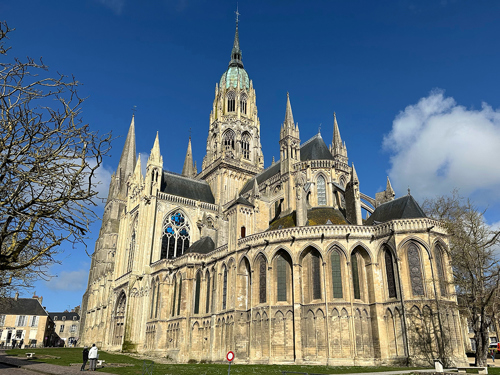
DISCOVER OUR 80TH ANNIVERSARY WW2 EVENTS
We're holding a number of events across the UK and in Normandy in the build up to the 80th anniversary of D-Day. Find out more about what we're planning and discover how you can get involved.


Visiting Bayeux, Normandy: Exploring the D-Day Beaches
If you’re planning a trip to Paris and want to include a side trip to Normandy, then a visit to Bayeux is perfect. Bayeux is an excellent base for exploring the D-Day beaches of Normandy. This guide has everything you need for spending one full day in this beautiful region of France.
This post contains affiliate links , If you make a purchase through these links I will earn a commission at no extra cost to you. Thank you!
Planning your trip to Normandy ? Below are some places to stay, things to do, and more.
- Bayeux: American D-Day Sites in Normandy Half-Day Tour
- Bayeux City Tour (2 hour tour of historic sights)
- Normandy Beaches Half-Day Tour
- From Paris: Normandy D-Day Beaches (day trip option if short on time)
- Hotel de Brunville (I stayed here! Great location and rooms)
- Villa Des Ursulines (Beautiful apartments, great location)
- Hotel Reine Mathilde (Nice rooms, restaurant attached to hotel)
Looking to visit Normandy as a road trip? Click here to find France car rental rates !
Table of Contents
Best Time to Visit Normandy
The best time to visit Normandy is April to September. I visited at the end of August and found the weather to be perfect with lots of sun but not too warm. Even though August is peak tourist season in France, Normandy did not feel crowded with tourists at all.

Where to Stay in Normandy
Normandy is a pretty large region but for visiting the D-Day beaches basing yourself in Bayeux is perfect. Bayeux is very close to the D-Day sites and is a great place to visit in its own right. It’s a charming town with beautiful medieval buildings and streets.
While I was in Bayeux I stayed at Hotel de Brunville . I loved that there was a parking lot right next to the hotel which made for easy parking and day trips. The hotel was also really well-kept with big rooms and was within close walking distance to everything in Bayeux. I would happily stay there again.
Is Normandy Worth Visiting?
Normandy is absolutely worth visiting. It’s full of gorgeous natural scenery as well as historic sites and beautiful villages. Bayeux is the perfect location in Normandy to base yourself for visiting.
Bayeux has such a compact historic centre that everything is in easy walking distance so you can see all the sights and still have time to head to the beaches. Bayeux was one of the first places liberated after the D-Day beach landings and is extremely close to those sights so its perfectly situated. The town itself is also worth a visit as the streets are lined with gorgeous medieval buildings and it’s home to the Bayeux Tapestry. There’s so much history packed into this area it’s perfect for history buffs or anyone that loves beautiful villages.
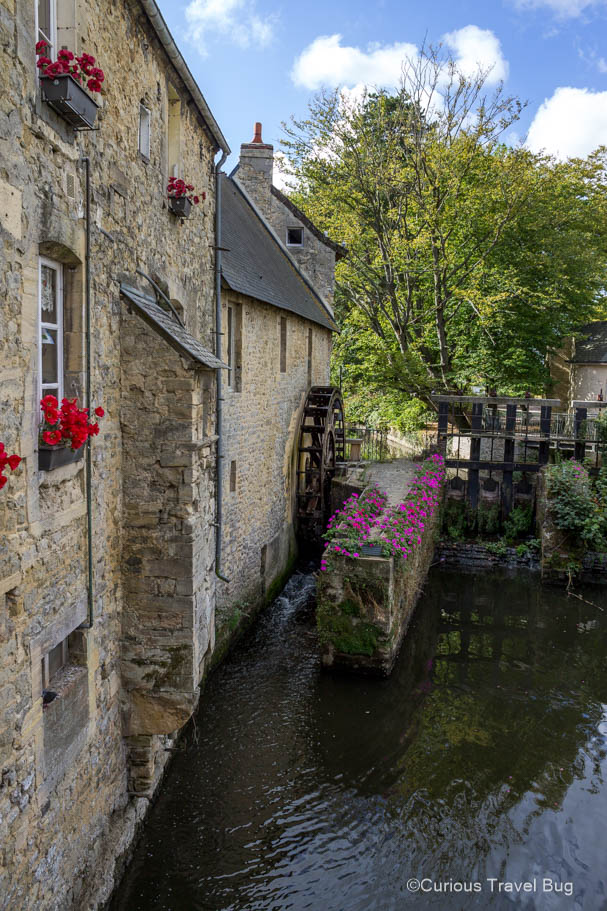
How Many Days to Spend in Normandy
Normandy is a big region so you can easily spend a week just exploring everything this beautiful area of France has to offer. To see the D-Day beaches and some cute Normandy villages, spend at least 2 nights based in Bayeux so you have one full day to explore. I personally think it is worth it to stay overnight in Normandy rather than on a day trip from Paris but it is possible to do a long day trip from Paris to the D-Day beaches.
If you are adding on a visit to Mont Saint Michel , I personally would move to stay closer so see the island lit up at night and the tide changes. You can see my entire itinerary for Normandy and the Loire Valley here.
Getting to Normandy from Paris
By Car The best way to get to Normandy from Paris is by car. Visiting Normandy by car is going to give you the most flexibility for exploring the area. I recommend picking your rental car up at the airport. If you’ve just done a trans-Atlantic flight it may be better to visit Paris first so you aren’t driving while tired. From Paris, Bayeux is about a 3-hour drive if you go directly but there are plenty of places to stop along the way to stretch your legs as well. By Train If you don’t mind joining tours to explore the D-Day beaches then travelling between Paris and Normandy by train is perfect. From the Saint-Lazare train station in Paris to Bayeux the direct train is 2 hours 20 minutes, you can find train schedules and tickets here .

How to Spend One Day in Normandy, France
Bayeux is a fantastic city to base yourself in Normandy. With one full day in Normandy, you can see some of the region’s highlights, but you can also easily spend longer exploring the villages of Normandy.
Start Your Day at French Bakery
You could start the day having a sit down breakfast but it’s the perfect opportunity to grab some pastries at a bakery and find a place to sit and enjoy your food. Croissants, quiches, macarons, tarte normande, pain au chocolate, you are spoiled for choices here and it’s an affordable way to try out local food. I ate at several, in the name of research and can happily recommend À La Reine Mathilde as my favourite here. If you are looking for a sit down spot for tea and cake, Les Volets Roses is a unique tea house that is all-pink kitsch and adorable.

Visit the Bayeux Cathedral
The cathedral in Bayeux is beautiful. You will definitely pass it at some point as it is right in the centre of things. This grand cathedral is worth a quick stop to admire the stained glass windows and impressive architecture.

The Bayeux Tapestry
The town of Bayeux is famous for the Bayeux Tapestry. I had personally never heard of it before my visit and was struggling to get excited about a tapestry. It’s actually incredibly interesting and unique.
The tapestry is UNESCO-listed and depicts the 1066 conquest of England by the Normans. The Bayeux Tapestry is 70 m (230ft) in length and provides a rich recounting of the war. The interpretive material in the museum provides context and it is fascinating to learn about how the war was waged a thousand years ago.
Tapestries seem to be quite the thing for this time period. The Angers Castle in the Loire Valley is also home to a famous one, the Apocalypse Tapestry.
Explore the D-Day Beaches
The main draw to visiting Bayeux and this region of Normandy is the proximity to the D-Day beaches. Hopping around to different D-Day sites is a great way to spend an afternoon in Bayeux. There are multiple half-day tours that you can join but you will have the most flexibility with a rental car .
A great way to start your exploration of the D-Day sites is to visit one of the museums. I visited the Canadian one, the Juno Beach Centre and really liked the displays and background it presented. There are many museums to choose from here including the one dedicated to American landings, the Utah Beach Museum . Both of these museums are also situated on important beaches for the D-Day Landings.
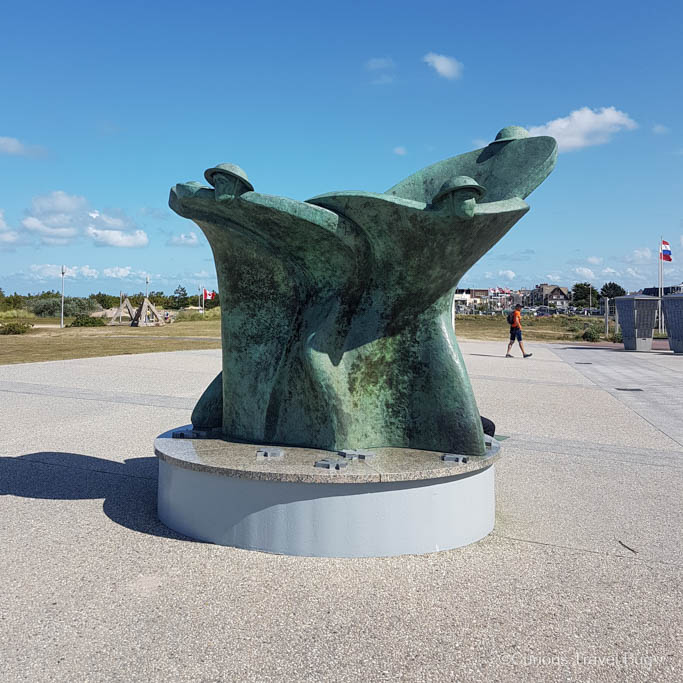
Unless you have a huge interest in WW2 then one of the museum is enough to get some background on the specific events that took place during the Normandy Landings. You can find an excellent overview of all the museums dedicated to the Battle of Normandy here.
After visiting one of the museums, start out your mini road trip by visiting some of the Normandy landing sites. Arromanches-les-Bains is a great first stop. From the viewpoint over the beach and ocean, you can see the artificial port that was installed to move heavy equipment and materials. This port allowed men and supplies to arrive quickly to the Normandy landing.

After viewing Arromanches, head towards the Longues-sur-Mer battery . This site is part of the fortification of the Atlantic coast and you can explore the area to see bunkers and gun emplacements that sit on the coast. This was my favourite site to explore as it was interesting to see the actual fortifications that were used along the coast, it really brought history to life.

Other important D-Day sites to visit include Omaha Beach, Sword Beach, the American Cemetary, and the Canadian War Cemetary.

Wander the Cute Streets of Bayeux
After spending the afternoon exploring the D-Day beaches, head back to Bayeux to explore more of the town and enjoy a nice dinner. I enjoyed the crepes at L’Insolite , they have both sweet and savoury options.
The town has cute cobblestone streets and in the summer there are beautiful flowers set around. It’s such a different pace than Paris, it’s nice to experience a different pace of life in France.
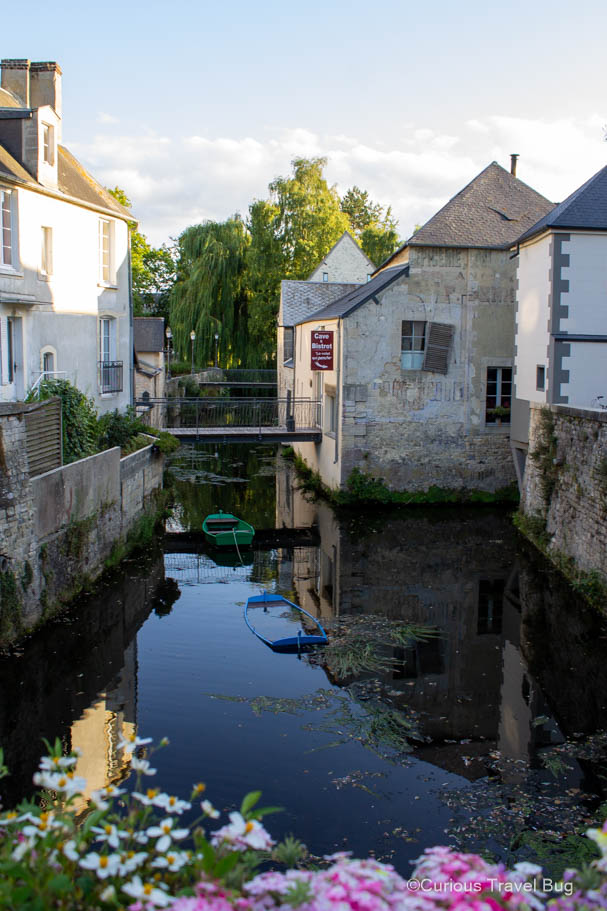
With More Time in Normandy
If you have two days in Normandy add on the cider route . The cider route is a self-drive tour to explore some of the most beautiful villages in France as well as cheese and cider producers. I ran out of time to do this but the route looks really nice and takes you through Beuvron-en-Auge, Cambremer, Bonnebosq, and Beaufour-Druval. You have the opportunity to stop at cider farms where you can purchase cider and calvados (apple brandy).
With three or four days in Normandy check out my full road trip to Normandy . You can easily add on visits to Mont Saint Michel , Honfleur, Rouen , or Etretat and its white chalk cliffs. After visiting Bayeux I went onwards to Paris with a stop to visit Giverny to explore Monet’s Gardens.
Like this post? Pin it for later!
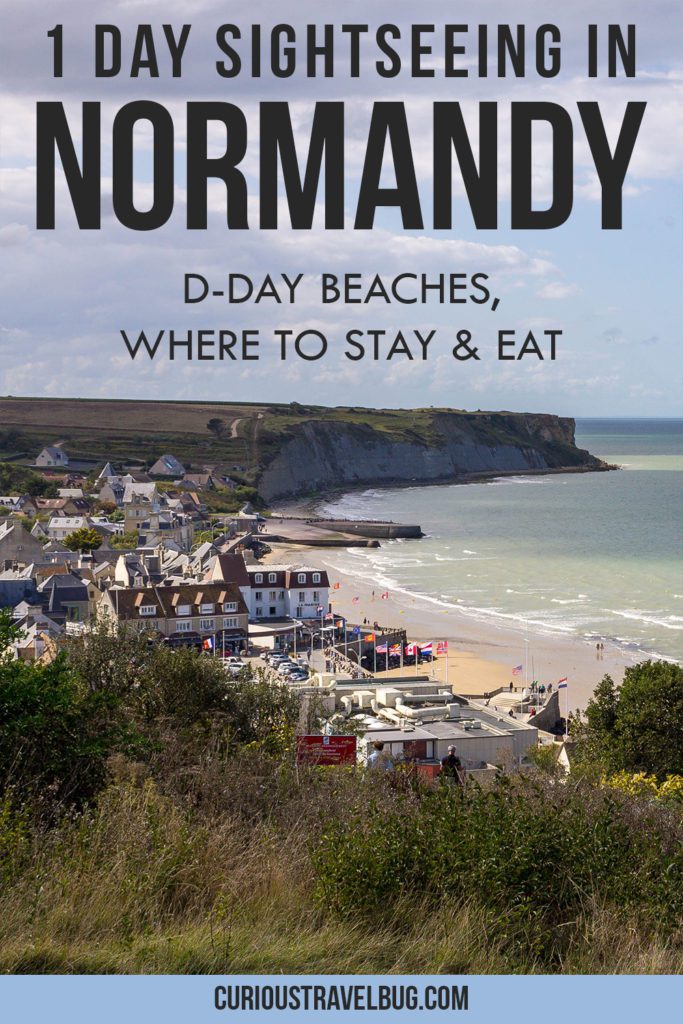
Similar Posts

Visiting Balos Beach Lagoon: Crete’s Must-Visit Attraction
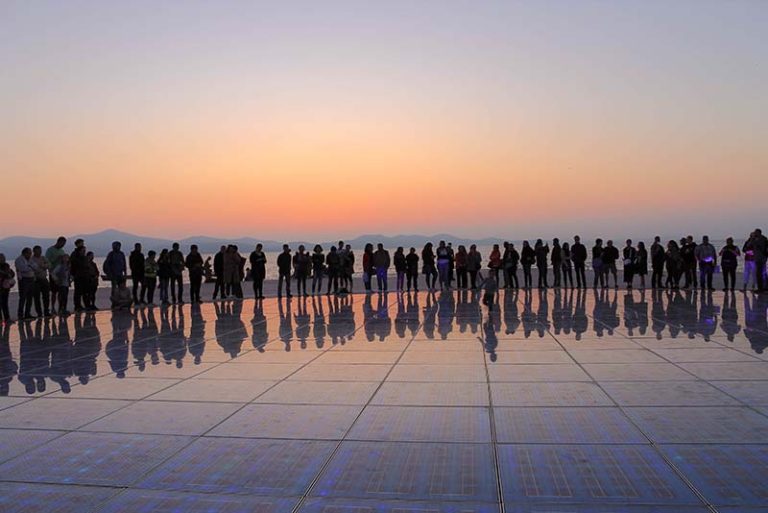
How to Have the Perfect Evening in Zadar, Croatia

Things to do During Winter in Toronto
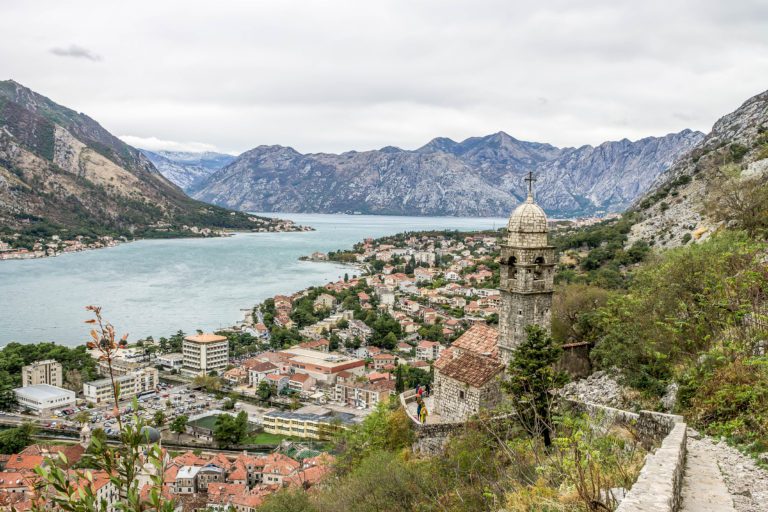
Best Things to Do in Kotor in One Day
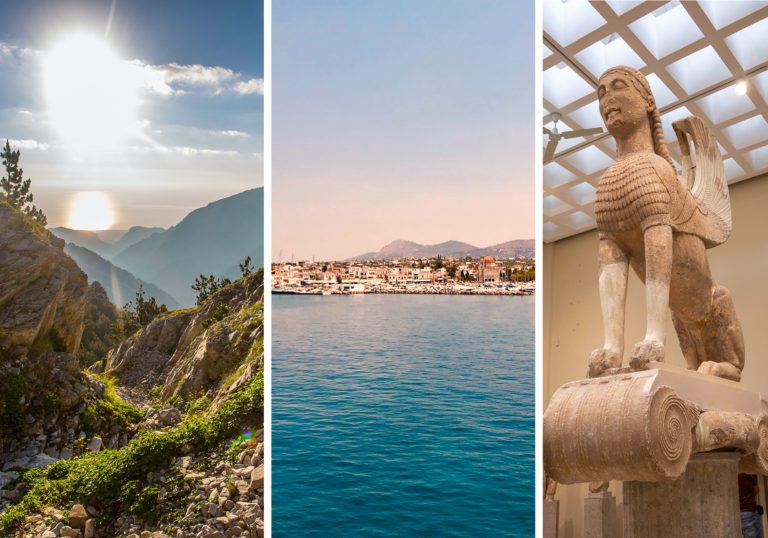
14 Best Athens Day Trips in 2024
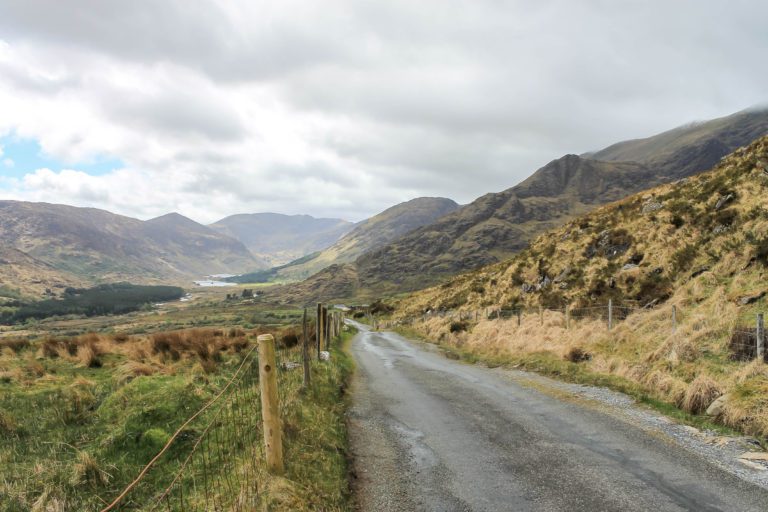
Best Things to Do in Killarney, Ireland
12 comments.
I”ve never really thought about visiting Normandy for anything other than its history, but these pictures are so beautiful! Would love to plan a trip here soon.
Glad you enjoyed the photos! I didn’t really know what to expect but Bayeux is such a pretty part of France.
I went to Normandy a couple of times on a school trip but this post is making me want to revisit and see more! The cider route sounds great fun!
Oh that’s wonderful you could visit Normandy as a school trip! Yes the cider route does sound fun, I wish I had time for it.
Such a historic place. Thanks for sharing your photos and experience with us. I’ve pinned this post for later.
Glad you enjoyed the post Lisa!
I really enjoy learning WWII history, so Normandy has been on my list of places to visit for awhile. I had no idea the town of Bayeux near the Normandy beaches was such a fabulous destination to visit though! I would also love to do the cider route – that sounds like a ton of fun. Thanks for sharing!
I hadn’t heard of Bayeux before researching where to stay for a visit to the D-Day Beaches and I was so pleasantly surprised about it. It’s such a cute town and has a lot of history there.
I know quite a lot about this area from school but have never managed to visit. It looks lovely to spend a day or two at!
There is so much to do in this area I definitely could have stayed for longer. I may have to make a trip back to Normandy and Bayeux!
Hi Brianna, my family and I are visiting Paris for a few days in early September. We originally had planned on visiting just the Normandy Beaches/Landing areas, but my sister and I really want to visit Mont Saint Michel as well. We were planning on just taking the train to the beaches, do you think it is possible to visit both sites using just the train system?? From my early train trip searches, it appears the answer is “not very easily”, but my sister insists that between all forms of public transit in the area, we should be able to cover both areas AND still get back to Paris (albeit, very late in the day). I keep suggesting that a car/van and perhaps a tour guide as well might be the better option. What do you think?? Thanks!
Hi Alejandro,
If I’m understanding correctly you intend to visit the Normandy Beaches as a day trip from Paris using trains? You will not be able to visit the D-Day beaches using only trains. You will have to combine it with local buses or cycling. It will be a very long day from Paris and a lot of careful planning of logistics. This website will help you with visiting D-day beaches without a car. I would probably find it less stressful to join a day trip from Paris for the D-Day Beaches. Day trips from Paris to the D Day beaches are about 14 hours long. To then go to Mont Saint Michel from somewhere like Bayeux is 2.5 hours on the train plus a bus to Pontorson and then a shuttle to Mont Saint Michel. I really cannot recommend trying to do both in one day as I think you will spend way too much time in transit and not enough time enjoying Normandy.
If it is important for you to visit both locations, I recommend spending a couple nights out of Paris or doing it as two separate day trips from Paris. I myself would rent a car, drive to Mont Saint Michel (optional visit to nearby St Malo), stay overnight in Pontorson or Bayeux, visit the D-Day beaches and then return to Paris with optional stops in Honfleur or Giverny. Even with car rental cost I think it may end up cheaper as accommodation costs are much higher in Paris than in Normandy.
Hope this helps!
Leave a Reply Cancel reply
Your email address will not be published. Required fields are marked *
- Skip to main content
- Skip to primary sidebar
- Skip to footer

8 Top Things to See at the Normandy D-Day Beaches in 2024
Debra Thimmesch Last Updated: September 26, 2023
D-Day, June 6, 1944, was one of the most pivotal days in world history. That day, thousands of Allied troops began their liberation of “the oppressed peoples of Europe,” as then-General Dwight D. Eisenhower put it. Today, you can explore this important place in history from Omaha and Utah Beaches to the American Cemetery and Point du Hoc. In this article, I’ll tell you about the top must-see sites at the Normandy D-Day beaches.
Pro Tip: Planning what to do on your trip to Paris? Bookmark this post in your browser so you can easily find it when you’re in the city. Check out our guide to Paris for more planning resources, our top Normandy tours for a memorable trip, and if a Normandy tour is worth it .
What You Have to See at the Normandy D-Day Beaches
“Your task will not be an easy one,” Eisenhower wrote to the Allied troops. Those words were part of his now-famous official order for the June 6, 1944, D-Day invasion. Indeed, it was not easy. In fact, according to the US Department of Defense, 4,700 of the 35,000 soldiers who first went ashore that day were wounded, killed, or declared missing.
The huge D-Day operation included the invasion and the push through Normandy then southeast to Paris . The invasion architects who selected Normandy as the landing zone gave it the codename Operation Overlord.
Gaining a strategic foothold in northwest Europe was essential to turning the tides in the war. Allied troops landing in Normandy were extremely vulnerable. The Germans had established positions, including bunkers, along the coast. They had also occupied cities such as Caen, the capital of Normandy.
Eisenhower warned the troops , “Your enemy is well-trained…He will fight savagely.” Therefore, it was up to the Allied forces to liberate the land and the French people. The battle that turned the tides of World War II started in Normandy.
In this article, I will explain why 50 miles of coastline in Normandy—which includes specific areas you can visit—held the key to victory. Here are 8 important sites from the Caen Memorial Museum to La Pointe du Hoc you won’t want to miss.
Not ready to book a tour? Find out if a tour of Normandy’s D-Day beaches are worth it .
8. Caen Memorial Museum
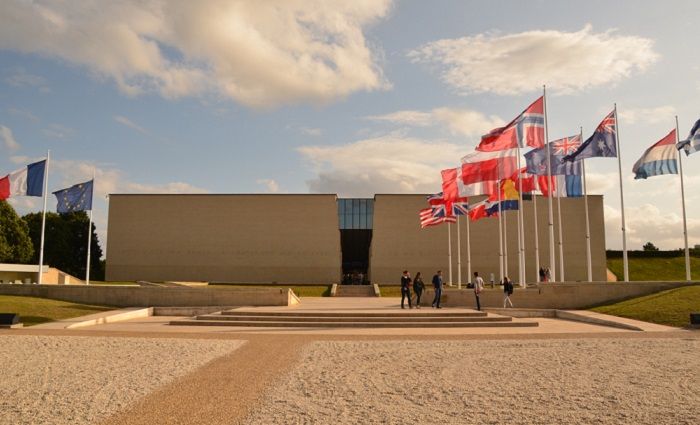
I recommend starting your Normandy D-Day Beaches visit in Caen. Caen is about 10 miles inland from the English Channel. It is the largest city in Normandy and played a crucial role in the war as it has in days past, such as when William the Conqueror once used Caen as his capital. It was heavily bombed by the Germans during World War II, and the city lost numerous historical buildings entirely.
The Caen Memorial Museum provides visitors with a comprehensive picture of the war in this part of France. Different areas of the museum tell different stories, so be sure to allow plenty of time here.
For example, you’ll learn about how civilians coped with the German Occupation. You’ll see objects related to the French Resistance, which was extensive. Finally, you’ll hear the stories of D-Day and the Battle of Normandy. The Caen Memorial Museum is the perfect place to get a full understanding of what you’ll see here at the Normandy D-Day Beaches before you head to Omaha Beach.
Address: Esp. Général Eisenhower, 14050 Caen Cost: starting at €17.50
7. Bayeux Battle of Normandy Museum
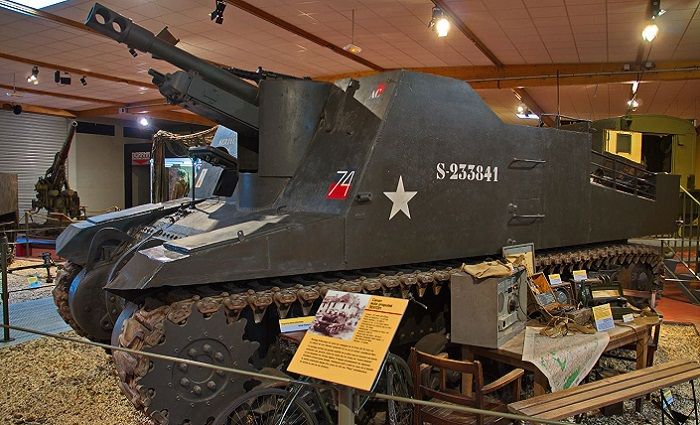
The Memorial Museum of the Battle of Normandy is a top place to see at Normandy. Bayeux is around 20 miles west of Caen on the inland side. This ancient city also hosts the famous Bayeux Tapestry.
Wondering what that is? Well, it’s not a tapestry at all but a famous embroidery that tells the story of the invasion of England by William the Conqueror. Thus, it seems apt that Bayeux would also tell the story of a more recent, historic invasion.
Bayeux’ museum focuses solely on the Battle of Normandy. Part of Operation Overlord, the Battle of Normandy took place over the summer of 1944. After the successful but bloody D-Day invasion, Allied troops pushed southeast across Normandy to the Seine river.
Their goal was to liberate Paris, and according to WWII historian Stephen Ambrose, Paris was liberated on August 25. The Germans retreated across the river to the east on August 30, 1994. That fateful event marked the end of Operation Overlord.
Address: Bd Fabian Ware, 14400 Bayeux Closed: Annually in January Cost: starting at €7.50 (buy in person only)
6. Artificial Harbor at Arromanches
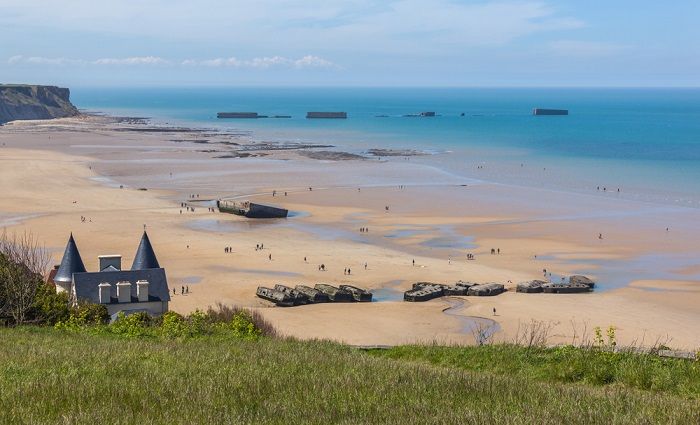
You might wonder how the Allied forces moved their vehicles and cargo across the English Channel and onto the shores of France. A key piece of their success was the genius installation of two portable, temporary harbors.
They named the first harbor at Omaha Beach Mulberry A. Then they built Mulberry B at Arromanches-les-Bains on Gold Beach. Today, you can see remnants of Mulberry B in Arromanches—the very same harbor the Allies used for over 10 months after D-Day. Incredibly, 2.5 million troops and 4 million tons of supplies came through Mulberry B, notes historian Jonathan Falconer.
A 17-minute drive from Bayeux gets you to scenic Arromanches. You have a splendid view of the artificial harbor from above. While you cannot walk on the remaining constructions, at low tide you can get quite near them. If you arrive around lunchtime, I recommend having fresh seafood at Restaurant La Maison du 6 . It’s just a short walk from the main square on Cale Neptune.
Address: 14117 Arromanches-les-Bains Cost: FREE
Not ready to book a tour? Find out how to visit the Normandy D-Day sites .
5. 360 ° Theater at Arromanches
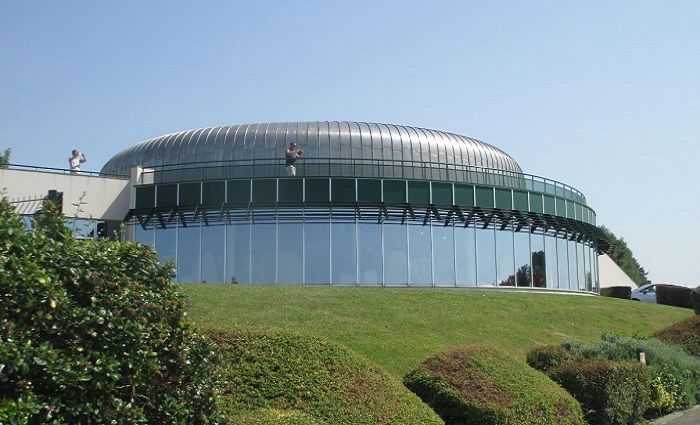
The impressive 360 ° Circular Cinema lies on the ridge above the city. The view of the artificial harbor and beach is stunning. So is the 20-minute film you’ll see in this remarkable theater.
“The 100 Days of the Battle of Normandy” is a breathtaking movie montage of footage from multinational archives. The film begins with the D-Day landings. It is projected on nine different screens, which place you at the center of the action. The experience is intense and deeply moving.
Address: Rue du Calvaire, 14117 Arromanches-les-Bains Cost: starting at €6
4. Omaha Beach
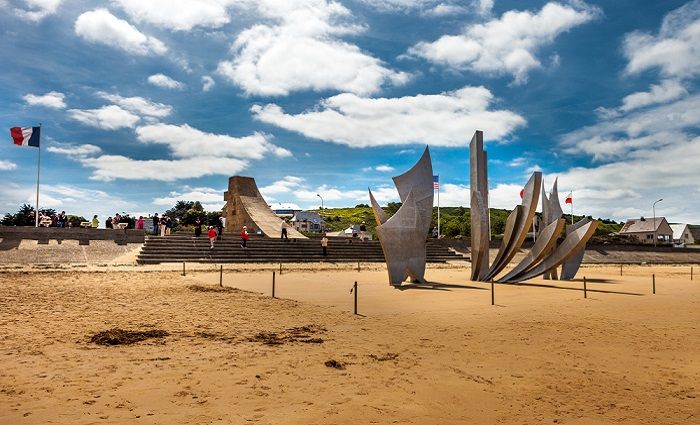
It goes without saying that Omaha Beach can’t be missed at the Normandy beaches. The Allied forces decided to call the beach landing part of the attack Operation Neptune. They designated five beaches as landing zones, and Canadian and British soldiers landed at Juno, Gold, and Sword beaches.
However, the Americans’ entry points were Omaha and Utah beaches, explains Ambrose. That’s just part of why these two beaches are the most recognized by Americans. But it’s also because the most intense fighting on D-Day took place on Omaha Beach .
The Germans had a superior position on the cliffs overlooking the beach, including concrete bunkers. In contrast, the invading troops had to enter the beach from the water—completely exposed. As a result, 2,400 lives were lost, according to the Department of Defense records. However, untold lives were saved by their heroic sacrifices. Today, Omaha Beach is peaceful—there is no sign of the violence and bloodshed of June 6, 1944, and the days that followed.
I recommend taking the D514 road parallel to the sea to get to Omaha Beach where visitors are free to explore. Whereas once you could walk down to the beach from the Normandy American Cemetery above, you must now arrive via Saint-Laurent-sur-Mer. Upon arrival, you’ll see the massive memorial sculpture titled Brave . It looks like gleaming silver swords and tongues of fire.
Address: Av. de la Libération, 14710 Saint-Laurent-sur-Mer Museum Cost: starting at €5
3. Normandy American Cemetery and Memorial
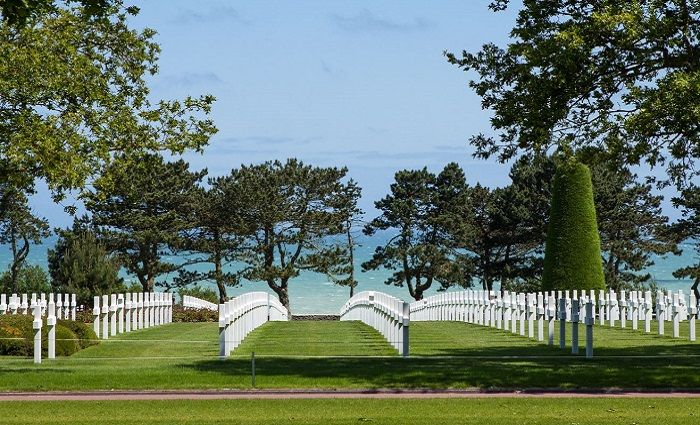
The Normandy American Cemetery and Memorial is located in Colleville-sur-Mer. According to the American Battle Monuments Commission, the Army constructed it on the site of a temporary cemetery for American soldiers in June of 1944. It was the first American cemetery on European soil in World War II. The 172.5 acre cemetery contains the graves of 9,386 dead. Most of the fallen died on D-Day and the days of battle that followed.
The Walls of the Missing on the east side of the memorial enclose a quiet, semicircular garden. The 1,557 names of the missing have been inscribed on those walls, and it’s worth taking some time to see it. Sculptures and large maps describe the military operations that took place in Normandy.
There is a beautiful reflecting pool and a small chapel. To the north, rising above the ocean, a table with a diagram of the beaches is available to help orient visitors. However, the lines of austere white crosses are by far the most poignant aspect of the cemetery and likely what you came to see here at the American Cemetery.
Address: Rte du Cimetiere Americain, 14710 Colleville-sur-Mer Cost: FREE
2. La Pointe du Hoc
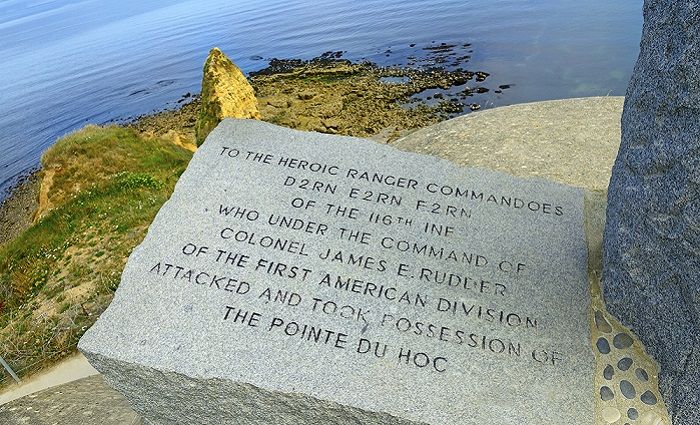
Drive further west of Omaha Beach for 15 minutes and you’ll reach La Pointe du Hoc. As a cliff overlooking the English Channel, Pointe du Hoc was enormously strategic for the Germans.
They had fortified it and built concrete bunkers that seemed completely impregnable. It was their front-row seat for the invasion of Normandy. Thus, the Allies knew that its position would prove a dire threat to the success of the invasion and determined to conquer it at all cost.
The massive battle that took place there left scars that you can still see today. As you stand at Pointe du Hoc, you’ll see huge craters created by the awe-inspiring and deadly assault of the Allied forces. The site is unimaginably eerie. You can walk alongside the craters and even climb down into the bunkers to get a feel for what it might have been like to stand guard there.
Address: 14450 Cricqueville-en-Bessin Cost: FREE
1. Utah Beach and Landing Museum
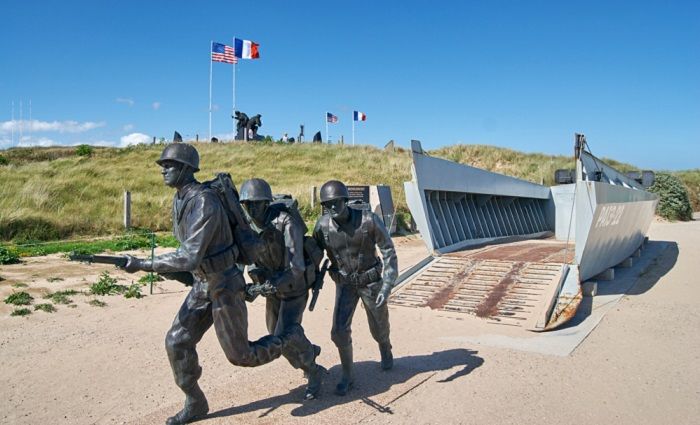
If you drive about 35 or 40 minutes west of Pointe du Hoc, you will reach the Cotentin (or Cherbourg) Peninsula where Utah Beach is located. Utah was the furthest west of the D-Day beaches. The decision to attack this beach was a late addition to the planning stages, notes Ambrose. Yet, it proved to be strategically essential due to its close proximity to the deep water port at Cherbourg.
Utah Beach was the first place the Allies landed on June 6, 1944. According to the Department of Defense, they only lost 197 men of the 23,000 troops who deployed on there. However, they succeeded in taking the beach and establishing a beachhead.
The Musée du Débarquement Utah Beach, or the Utah Beach Landing Museum, is another top place to see when you visit the Normandy D-Day beaches. First, the architecture of the museum integrates with the beach thanks to the huge windows that provide an immense view. You can’t forget where you are.
Second, the museum’s extensive collection of vehicles, equipment, and objects really gives you important context to the tragedy and heroism that occurred here at these sacred sites. Your trip to the Normandy D-Day beaches, museums, and cemeteries will be one to remember.
Address: La Madeleine, 50480 Sainte-Marie-du-Mont Museum Cost: starting at €5
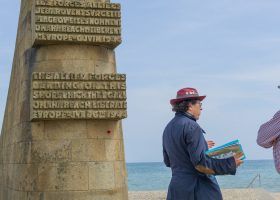
Where to Stay in Val d’Orcia, Tuscany
8 things to do in florence off the beaten path, 12 astonishing facts you might not know about the medici family, where is the statue of david, how to climb the florence duomo.
About Debra Thimmesch
Debra Thimmesch is an art historian, researcher, independent scholar, editor, and visual artist. She mentors undergraduate and graduate students in the history of art and is a published author. Her work has appeared in publications such as The Brooklyn Rail, Art Papers, and Blind Field and a variety of exhibition catalogs. Her BA, MA, and PhD in art history have provided only part of the broader, global view of the history of art that she has acquired through the years. As a world traveler, she considers herself a sort of pilgrim of great art and architecture. As a teacher and tour guide, she has led private tours and student groups to numerous sites in the US, the UK, and Europe.
Reader Interactions
Leave a comment cancel reply.
Your email address will not be published. Required fields are marked *
- Travel Guide
- In The Press
POLICY & TERMS
- Cancellation Policy
- Terms & Conditions
- Privacy Policy


Visiting the beaches of Normandy: D-Day landings and WW2 sites – your ultimate guide
Visiting the beaches of Normandy, with its wealth of D-Day and world war 2 sites, was on our bucket list of things to do while in France and it’s one of those places that are well worth the visit.
They can be accessed easily from either the UK or other parts of France (and as such, the rest of Europe) and each year they get more and more visitors eager to learn of what happened on 6th June 1944, or as it’s now known – D-Day.
This article probably contains affiliate links. This means that if you buy or book after clicking, I may get a commission at no extra cost to you. Thanks!
I hope our guide to visiting these WW2 sites on the French coast of Normandy will be helpful and inspiring to anyone planning a visit and also anyone with a passing interest in our recent history.
Essentials for your D-Day explorations:
- Guide book with background info on the D-Day Sites
- Normandy Road map
Guided tour from Bayeux
- Half Day Small group tour to Omaha Beach
Our guide to visiting the beaches of Normandy and WW2 sites
The words have become almost normal now – incorporated into our everyday speech – D-day, beaches of Omaha, Utah, Sword, Gold and Juno. Strange to think that 100 years ago, these words meant nothing in the context that we now think of them.
That’s what’s so moving about visiting the beaches of Normandy , the fact that it was so recent, that there are still people alive who remember those days, lived through them and either were there themselves or heard the news about it. As time moves on fewer are around to tell the tale first hand, so it’s all the more important to keep the stories alive and to give weight to those words.

I knew of D-day, of course. I grew up with fairly limited knowledge of the history though, I had heard the term but only really learned about the operation when our son developed a passion about the time period. We watched films, documentaries and tv series about the war – I thought I knew what we were going to see when we visited Normandy!
What remains of World War 2 in Normandy today is sombre, touching and hopeful. Sombre because it was the scene of many deaths, not just fallen men, but brothers in arms (to coin a phrase), comrades and friends. Touching because there are still memories of a time gone by scattered around. Hopeful because it’s a reminder of what can be achieved by humans in the pursuit of a better world.
Pin for later!
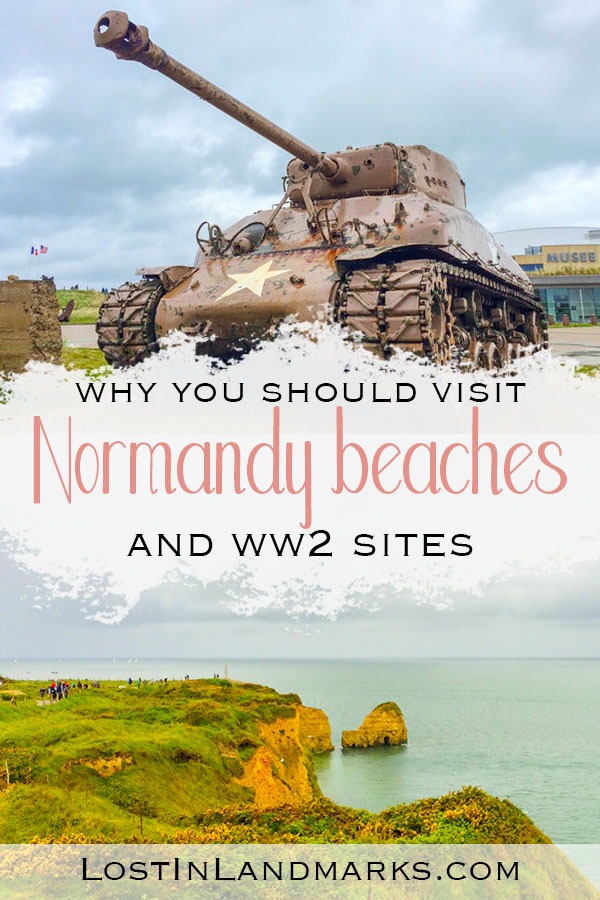
It’s not all about the war in Normandy though. If you’re planning a trip with those who aren’t quite as interested, or perhaps with children who might not cope with days learning about death and fighting, the area has so much more too. Gorgeous little towns, beautiful scenery and of course that amazing French food!
Normandy Invasion – a super quick history
Ok, this will be quick as I imagine if you’re interested in visiting the Normandy D-Day beaches you have a slight inkling of the history involved.

It was one of the largest organised invasions of all time that incorporated naval, air and land troops and it was a turning point for the Allies in World War 2. The Normandy invasion on D-Day, 6th June 1944, were truly immense undertakings from the armed forces of not only Britain but also the USA and Canada.
Prior to it happening, France was under occupation from the Germans and their advancement throughout Europe was continuing. The Allies needed to have a foothold in Europe in order to have any hope of turning the tide. What’s interesting is that the Germans actually knew that an invasion was likely to be happening, but they didn’t know where from and where the Allies would land. There were many attempts to throw off the scent and the Germans did think the invasion would come further up the French coast in Calais or Dunkirk where it was much closer to the UK coast but of course that never happened.
It was so much more than D-Day itself though – there was months of preparation which included simulating the Normandy coastline in areas of the UK coast, practicing their manoeuvres and training the personnel. This was an immense undertaking. Further to this there was an operation whereby the coastal defences were bombed in advance of the invasion.
On the day itself, the Allies began by parachuting in airborne forces behind the enemy lines where they took strategic points and would meet up with the troops that began to land in the early hours of June 6th. They fought with the soldiers and guards of the Atlantic Wall that Hitler built. It certainly wasn’t easy but eventually they took the areas one by one, strategic towns and points were gained and the Allied forces pushed the Germans back.
Although the operation as a whole was a success there were many stories within D-Day where it seems the opposite. Many, many lives were lost on both sides which is a terrible tragedy no matter the outcome.
A note on the names of the beaches in case you don’t know.
There were many different areas of the coastline that troops landed on but they were generally split in to 5 sections and each had a different armed force in charge of landing there.
Each area was given a code name – Utah, Omaha, Sword, Gold and Juno. The Americans were charged with the Utah and Omaha landings. The British landed at Sword and Gold and Juno was mainly Canadians. The overall operation was called Operation Overlord and the landings themselves Operation Neptune.
The history of this time is vast and I’ve researched thoroughly for this article but I’m not a historian so please forgive me if there are any inaccuracies – and also let me know so I can put it right! For more in depth research of this time period Wikipedia is a good start and from there explore their related links at the bottom.

Why visit the D-Day beaches in Normandy?
Of course D-Day has been immortalised in films and tv series over the years and it’s one of the biggest and most well known operations from the Second World War.
It’s an iconic moment in history and one where we can look back and see the huge sacrifice that was made actually did make a difference. If D-Day hadn’t turned out as it did the outcome of the war might have been very different. As such it’s a huge part of our history.
I feel that we must always remember the sacrifices made for us and while watching documentaries, reading books and enjoying movies about it can keep the stories alive, visiting the sites really gives a new dimension.
You can know that soldiers lost their lives on a beach, but it’s just words. Seeing that area and visiting the nearby graves really brings home the personal sacrifices.
For many of us it’s important to visit because we have a personal connection to the day too. Many people come as a pilgrimage to pay their respects to family members who fought there.
For others, and I include myself personally in this, it’s just a really interesting place to go. This is recent history and an important piece of the huge story that is the second world war. No matter what I know about a place or piece of history I can’t fail to get something out of experiencing the place in real life.
Museums help to keep the information of each area in an organised manner and you’ll find many enthusiasts willing to speak to you about the history if you take the time to ask. By supporting these places you’re also helping to preserve the historic sites for future generations – definitely worth it.
Lastly, Normandy is a beautiful place in its own right. I’m focusing this guide on the D-Day beaches and the war history of the area, but there’s so much to enjoy here that’s not just war related so go enjoy the food, the countryside and the people too!
What are the Top 10 must see sights at the D-Day Normandy beaches?
Here’s the places you really shouldn’t miss on your tour of the D-Day beaches in Normandy – I’ve listed them in order from west to east rather than importance:

The first beach that you’ll get to if you are coming from Cherbourg or doing the tour West to East is Utah.
This beach was landed by American troops and was the more successful out of the two the US were dealt. The reasons are most likely geographical, the Germans were defending a wide open coastline here, flat with no difficult to reach areas they could attack from. Overall there were less than 200 casualties for the Allies here and it was a relatively quick victory.
Utah beach is one that isn’t in a built up area and the beach itself is nice to walk along if you get good weather with many remains of the German defences scattered along and lots of monuments to the battalions and units present there. There’s also a museum which attracts most people with an interest in the time period and is fairly inexpensive.
Utah Beach Landing Museum – learn about the chronology of the landings, see a B26 bomber.
Winter opening hours (Oct 1st – May 31st): 10am – 6pm. (It is closed for the majority of December, opening from the 26th – 30th only)
Summer opening hours (June 1st – Sep 30th): 9.30am – 7pm
Get tickets here
Sainte-Mère-Église
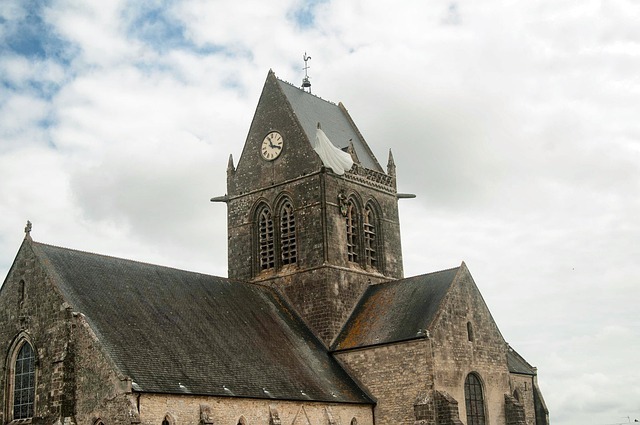
A big part of the operation at Utah beach was the destruction and capturing of many of the strategic points in the area from the airborne divisions who landed at various places including Sainte-Mère-Église, a small Normandy town.
Some of the 82nd Airborne division landed at Sainte-Mère-Église in the very early hours of the 6th of June 1944, unfortunately too close to where they planned to land. Many of them died as some buildings on fire in the town lit up the parachutists descending and were easy targets for the Germans. One interesting tale is about the soldier, John Steele, who found himself caught on the steeple of the church as he tried to land. He was shot in the foot, in lots of pain and could only watch some of the others in his company as they were killed. He dropped his knife so could not free himself and so had to pretend to be dead while the fighting was going on around him. He eventually was rescued from his precarious position by the Germans and he became a prisoner of war until he escaped a few days later. Despite early German dominance the town of Sainte-Mère-Église was taken soon after on June 7th 1944 and it also has the honour of being the first liberated town of the Normandy invasions.
In the town itself there’s a museum dedicated to the 82nd and 101st Airborne division – if you’ve watched Band of Brothers, 101st Airborne is portrayed in it.
It’s well worth spending some time there with plenty that will keep kids happy (both of mine enjoyed their time there) and provide an insight in to what happened in the area for those interested to learn more. Lots of replica planes and gliders to get a sense of what was involved!
The church keeps the story of the parachutist alive by keeping a fake dummy of a soldier on its roof top.
It’s a pretty town to explore round with many tourist shops selling world war 2 memorabilia, some restaurants and cafes too. We really enjoyed our time there.
Airborne Museum – learn about the airborne attack, how they liberated the town and also see some of the gliders and planes used.
Opening times:
- May – Aug: 9am – 7pm
- April and September: 9.30am – 6.30pm
- October – March: 10am – 6pm (the museum is closed throughout December and January)
See here for more information
Pointe du Hoc

One of the areas of Normandy that remains much as it was during the time of the landings is Pointe du Hoc. It’s a steep cliff edge and the highest point of the area which sat between the beaches of Utah towards the East and Omaha which lay to the west. As such it was heavily fortified and protected by the Germans despite it having been bombed prior to D-Day.
The United States Army Ranger Assault group were charged with the scaling of the cliffs at Pointe du Hoc and removing the German artillery with the help of the British to land them at the scene. Before even landing there were problems straight away with the sinking, and subsequent loss of those on board, of one of the amphibious DUKW vehicles. On landing the Germans fired heavily on all of the troops with disastrous effect and on reaching the base of the cliffs the Rangers were at half the initial numbers. To reduce the risk of them being fired at as they grappled up the cliffs, navy ships from the US and British navies fired on the German defences. On reaching the top the soldiers struggled with yet more set backs: their radios didn’t work and their objective of removing a main artillery defence was already gone. After intense fighting the finally overpowered the remaining guns and destroyed them. They held off lots of counter attacks from the Germans over the next couple of days until they got relieved by further US troops on the 8th June.
Pointe du Hoc is one of the stories I personally didn’t know much about but which I’m so glad I learned about.
The museum at Pointe du Hoc does a really touching video which explains what happened. Reading about the words often don’t convey the sense of what happened, but listening to the stories from the soldiers who scaled the cliffs themselves, watched their friends get fired upon and who came home to tell the tale brought tears to my eyes.
There’s lots to see at Pointe du Hoc as well as the visitor centre – the remains of the casemates built by the Germans can be explored and you can imagine how it might have looked to them as the enormous amounts of D-Day troops descended on the area. Craters litter the site too where it was heavily bombed.
Visiting Pointe du Hoc
Open daily throughout the year
- April 15th – September 15th: 9am – 6pm
- Rest of the year: 9am – 5pm
Pointe du Hoc is one of the few free things to do in Normandy related to WW2 – if you’d like more information about visiting see here .

Maisy Battery
I have such a soft spot for parts of history that are covered over and forgotten about for years and Maisy Battery is one such place.
It was a very important German defensive position situated between the Utah and Omaha beaches and consists of over 2 miles of tunnels, bunkers and trenches. The history of the site is still coming to light with all the war documents being released over the years – it seems that it was an unknown site to the Allies and that the Germans used Pointe Du Hoc as a ruse to confuse them and with the removal of the big guns that were expected to be there, this could certainly be true. It was lost to the world for over 60 years and was only rediscovered as someone found an old map to it in a veteran soldiers trousers. That discovery combined with the opening of war files has opened up an exciting and interesting chapter!
If you drive past you might miss it – it’s completely camouflaged from the casual viewer! Nowadays you can walk round the site, explore the tunnels, see some old guns, cannons and weaponry. It’s a great day out and quite different to many of the other WW2 sites around Normandy.
Visiting Maisy Battery
Opening times
- April 1st – May 31st: 10am – 4pm
- June 1st – Aug 31st: 10am – 6pm
- September 1st – September 30th: 10am – 4pm
- Closed from October – March (although you can contact them with a possibility of visiting)
See here for more details and tickets
Omaha beach

The US Army had the objective of securing the Omaha beachhead however a catalogue of mistakes and confusion led to this being an extremely difficult operation with huge numbers of soldiers losing their life. It started with the naval bombardment of the German defences – it wasn’t enough as they navy didn’t want to risk hitting the landing crafts. The landing troops were also blown off course quite a lot on the morning of the invasion due to the weather and this did not help matters. The intelligence about the defences were flawed, they had trouble bringing vehicles on land with many of them being swamped as they tried to land and finally many of the soldiers were wiped out as soon as they did land due to heavy gun fire from the Germans. As many as 2000 lost their lives (some sources report up to 5000) on that day. After many days of fighting the objectives were completed, the beach secured and it was eventually used as a harbour to bring artillery and troops in to France and to help the push against the Germans.
Nowadays there’s a few remnants of the war still visible. There’s many monuments to the regiments that fought along this stretch of land and who also lost lives as well as a memorial museum. At low tide you might also be able to see the remains of the harbour that they built but not as prominent as the one at Arromanches.
Omaha Beach Memorial Museum
- February: 10am – 5pm (opens mid February – check their site for dates if travelling round then)
- March: 10am – 6pm
- April – May: 9.30am – 6.30pm
- June: 9.30am – 7pm
- July – August: – 9.30am- 7.30pm
- September: 9.30am – 6.30pm
- October – November: 9.30am – 6pm (closes mid November)
- Closes from mid November – mid February.
See more information here
American cemetery

Overlooking the beach at Omaha is the American Cemetery which holds a great number of US soldiers who died in the second world war and with many of them being in the time of the Normandy landings. It’s a beautiful place which overlooks the sea and it’s a heartbreaking visual reminder of the loss of life suffered.
Of course, it’s not the most cheery of places to visit and we couldn’t stay long as our daughter didn’t want to go (always something to bear in mind when visiting these WW2 sites with kids) but it’s a very important place that should be included in your itinerary if you can.
There’s a visitors centre there too which tells the stories of the soldiers and is free to enter.
Normandy American Cemetery Visitor Centre
Admission is free – see more info about the site here
Gold beach & Arromanches sur les bains

This was my favourite site of our trip (see below for our thoughts on what to visit if you can only visit one beach) and it provides lots for anyone visiting Normandy with hopes of seeing WW2 history – there’s lots still visible!
The landings at Gold beach are slightly to the east of Arromanches and this was on of the two beaches that was taken by British troops. The day started like many of the others with bombardment and bombing of the area the night before and the troops landed in the early hours of the morning of 6th June. Choppy and rough seas meant that like many other beaches the men landed slightly off course and the vehicles they tried to bring ashore would get bogged down in the sand. There were many casualties at Gold with around 1000 reported. At the end of the day, almost 25,000 troops landed, they took Arromanches and eventually used that site to build a mulberry harbour which allowed them to bring in more weaponry to mainland Europe for the rest of the war.
There’s lots to see at this area. We really enjoyed our visit to the town of Arromanches-sur-les-bains as you can see lots of the remains of the mulberry harbour. This was the temporary harbour that was built to move tanks, weapons and soldiers in to the country. There’s also a really good museum in the town too which I recommend to learn more about this area and how they landed and used the town. Longues-sur-mer battery is also a well preserved German defence area that is worth visiting if you’re around this section.
Longues-Sur-Mer Battery
Freely open to look around – there are guided tours as well at the following times of year:
April, May, June, September & October: weekends only
July & August: daily
Tours run in both English and French – see here for more details.
Musée du Débarquement / D-Day Museum in Arromanches – learn about the mulberry harbours and the d day landing beaches
- January: Closed
- February: 10am – 12.30pm & 1.30pm – 5pm
- March: 9.30am – 12.30pm & 1.30pm – 5.30pm
- April: 9am – 12.30pm & 1.30pm – 6pm
- May – August: 9am – 7pm
- September: 9am – 6pm
- October: 9.30am – 12.30pm & 1.30pm – 5.30pm
- November & December: 10am – 12.30pm & 1.30pm – 5pm
See here for more details

The responsibility of the Canadian army was Juno beach which was located inbetween Gold and Sword. The familiar story of the sea conditions causing delays and problems to the landings also applied here and the beaches were heavily protected by the Germans. Although there was a preliminary bombardment of the sites they weren’t very effective and as such the troops landing were under heavy fire from the very start. It’s considered one of the more successful landings, alongside Utah, even though many of the objectives weren’t actually met. Casualties were relatively low, around 340 dead on the day.
One of the towns in the area, Courselles-sur-Mer, now features a museum and memorial called the Juno Beach Centre. If you’re at all interested in the Canadian effort in the war as well as the specifics of the Juno landings then I’d highly recommend a visit.
Juno Beach Centre
- January: closed
- February: 10am – 5pm
- April – September: 9.30am – 7pm
- October: 10am – 6pm
- November- December: 10am – 5pm
Get more information here .
Sword beach & Pegasus bridge

The final beach going from west to east is Sword beach at the town of Ouistreham.
Sword was the responsibility of the British army and although the experienced quite a few casualties on landing at the beach, they managed to get their armoured vehicles landed quickly and took the beach in fairly good time. This beach was the closest to Caen which was a major objective in Operation Overlord and so the troops moved onwards to there but suffered lots of setbacks and resistance on the way. Another important place nearby is Pegasus Bridge which played a part on the night before the landings where the plan was to secure the bridge and prevent any further German troops from gaining access to the bridge and hindering the landings the day after. They arrived by using gliders successfully taking the Germans by surprise.
Sword beach was the first that we visited and it’s very strange, yet happy place that is a completely normal beach town. Not what we were expecting at all. There were people playing on the beach, lots of land sailing going on and just a generally nice atmosphere.
The town of Ouistreham is a pleasant town to spend a night as well with lots to see if you’re interested in the landings. There’s the Grand Bunker museum which is well worth a look, No4 Commando museum and also the Pegasus bridge memorial too all within that town.
Grand Bunker Museum, Ouistreham – see the command post as it was and learn about the Atlantic Wall
- Jan 6th – Feb 8th: Closed (2019 dates)
- Feb 9th – March: 10am – 6pm
- April – September: 9am – 7pm
- October – January 5th: 10am – 6pm
See here for more information
Pegasus Memorial Museum
Open every day from 1st February – 15th December
- February – March: 10am – 5pm
- April – September: 9.30am – 6.30pm
- October – 15th December: 10am – 5pm
See here for more information.

Though not a beach, a major player in the Battle for Normandy is the city of Caen which suffered terribly in the days after D-Day. It was actually in the plans for it to be captured on D-Day itself, but that never happened, the Germans defended it fiercely and what ensued was fierce fighting and many casualties on both sides and civilians. It actually took around 7 weeks for the city to be taken and ended with a bombing from the Allies which killed many French citizens and completely destroyed the city, reducing the majority of it to a pile of rubble.
Caen has many memorials about WW2 but the main one is the Memorial de Caen which houses a really good museum which is worth checking out. If you are in the area do also check out the Abbey d’Ardenne which was the site of an atrocity committed by the Germans against some Canadian soldiers they had taken as prisoners. At least 20 soldiers were executed there and there’s a touching war memorial to the men.
Caen Normandie Memorial Museum
- February – March: 9am – 6pm
- October – December: 9.30am – 6pm (some Mondays are closed also in this time)
See here for more information and tickets
Tips for visiting the Normandy WW2 sites
- Winter sees lots of the sites close for the season – do be aware of this if you are coming in the winter months. If sites are open their hours are reduced a lot too. Although out of season is generally a good time to visit, do make sure what you want to see will be available. January sees many of the museums close completely so I’d recommend not to visit that month at least.
- It rains. A lot. We were there for about a week in April and saw so much rain! Later we learned that Normandy is a very rainy region and is well known for it!
- As these are war graves, dress and act respectfully
- Around D-Day itself many of the sites close for ceremonies and it will be much busier so if you’re visiting around then check individual sites and book well ahead.
- France is well known for long lunch hours – as you’re visiting the towns and villages around be aware of this and don’t be surprised that shops shut.
- Sundays are also a day when almost everything shuts (although the D-Day museums around here tend to be open) – get any supermarket shopping done in advance. We were definitely taken by surprise by this on our first visit to France!
What Normandy WW2 museums are worth visiting?

There are many museums along the coast line and in towns, too many really for one trip. Unless there’s a specific area or operation that you’re interested in I’d suggest heading to wherever is convenient for you and enjoying what is on offer there. There’s a chance of information overload if you try to do too many.
I mean, how many guns can you see without getting bored? My son would probably argue with me about that!
We haven’t visited all the museums in the area (unfortunately!) but we did enjoy the D-Day museum in Arromanches as well as the Airborne museum in St Mere Eglise and I’ve heard good things about all the museums in Normandy.
How long should you spend in Normandy?
If you’re planning a Normandy trip I’d say that a good time to take in the sites is around 3 or 4 days. This would allow you to really see all the beaches, plenty of museums and other sites around the area and for you to take in the larger towns such as Bayeaux and Caen.
More than this and I’d imagine that history overload might take over, but your mileage may vary!
If you want to incorporate checking out the rest of the area including the gorgeous Mont St Michel then I suggest as long as you can spare and at least a week! France is a great place to visit and we enjoy the slow pace of life there a lot! Try not to rush your time there.
You can only visit one beach – which one?
This is a difficult one to answer and each person in our family who I asked said a different place.
I think this can possibly depend on your war knowledge or maybe your heritage – Americans will almost certainly say Utah or Omaha, Canadians will say Juno!
Personally I found Gold beach and specifically the town of Arromanches to be a really special place to visit and this is coming from someone with only basic knowledge of what happened in Normandy in WW2. With parts of the artificial harbour still in view and being able to be seen up close, it really helps you visualise what happened back then. Obviously if you can, visit at least a couple, but if I had to choose just one it would be the area around Arromanches-sur-les-bains.
I asked my son (our resident WW2 nut – he knows way more than me!) for his opinion and he said Omaha due to the extreme loss of life there and the significance of that beach in later films so that would be my second choice. You also have the American Cemetery nearby too so easy to incorporate that in to your day.
My husband said to visit Pointe du Hoc. I know, we’re not very helpful in narrowing down the choices!
If you are pushed for time, consider what is important for you to see. If you’re British and want to see the places that they fought concentrate on the middle to east part. If you’re Canadian you’ll likely want to concentrate on the Juno area and if you’re American or interested in the infamous Bloody Omaha then you’ll want to stick to the west.

Interested in more WW2 travel? See our posts about London’s WW2 sites or visiting Colditz Castle in Germany
Getting to the Normandy beaches
How to get to the normandy beaches from the uk.
Update – check out our new post about getting to Normandy from UK
When we travelled we took our motorhome over on the Dover to Calais crossing with DFDS (always the cheapest option when I check) and travelled down from there. It was a fairly straightforward journey but one thing I’d say is to not underestimate the time it can take to get to places in France. It never looked too far on the map but it can be especially if you’re not using the motorways.
If you want to get yourself right in the heart of Normandy straight away and keep journey times to a minimum then I recommend a ferry to Cherbourg which means you can start at the Western end of the beaches near Utah within around 45 mins drive of the port. Alternatively you can get a ferry to Le Havre which is about an hour and a half from Ouistreham and the eastern end of the beaches or Dieppe which is just over 2 hours drive away.
Brittany ferries – goes to Caen, Le Havre and Cherbourg
DFDS – goes from Newhaven to Dieppe
P&O ferries is another option to Calais
Looking for an itinerary for your trip? Check our 3 day self drive Normandy D-Day itinerary
There are also many tours that depart from the UK if you want to visit but aren’t too keen on doing it independently. My Father in Law took a coach trip a few years back and thoroughly enjoyed his time there and it’s a great idea if you want to just sit back and enjoy your time there.
How to get there from Paris
If you are arriving in Paris and want to incorporate the beaches in to your France itinerary then I suggest one of two options: either hire a car or arrange a place on guided tour.
It’s around a 3 hour drive to Ouistreham on the most eastern end of the landing sites so doable as a day tour if you wanted to, although it would be a long day. To check out rental car options I recommend DiscoverCars.com which compares many companies to find the best deal.
Guided tours from Paris to Normandy are plentiful from the capital with some taking in the area over a couple of days and others just doing a day trip.
When looking at these tours bear in mind if you have any specific places you want to visit and see if they include them as it’s impossible for them to cover everything!
This one is a good option and if you have a couple of days to spare this one is worth a look and even covers other Normandy sites such as Mont Saint Michel.
Visiting the beaches from Le Havre
Many cruise ships stop in Le Havre and as such it’s a good place to get excursions to the beaches. Here’s one that covers many areas in a day.
Canadian sites from Le Havre
US sites from Le Havre
Using public transport to visit the Normandy beaches
It’s not particularly easy to use public transport to get to all the sites in Normandy but with some planning you should be able to visit a few places.
Caen is an important part of the invasions and is worth seeing if you can. Trains are around 2 hours from Paris in to the city. If you want to do a tour from Caen this one would be worth checking out.
Bayeaux is another good town to visit and easily reached by train as well. From Paris it can take between 2.5 and 3 hours to get there and it’s also easily reached by Cherbourg in about 1 and a half hours if you happen to be a foot passenger on one of the ferries.
Tours from Bayeux
There are many tours from Bayeaux that can take you on to the beaches themselves and are a better option that trying to navigate the buses which are infrequent.
US Sites tour
US and British sites
Canadian sites tour
Driving tips for France
If you decide to drive over in France then here’s just a couple of tips:
- make sure you have a european driving kit that covers you for the legal things you need in France – Hi vis jackets, headlight deflectors (if coming from the UK),
- the motorways in France are often toll roads and it can add up over time. Either be prepared for this or plan a route that avoids them.
Where to stay when visiting the Normandy beaches
Bayeaux is a perfect base for any tour to the beaches whether it’s self drive or going by guided tour. I’ve linked below to a couple of options with Booking.com – they are my preferred booking portal as often you can book without needing a deposit and they are super easy to use.
If you want to stay in the centre of town itself, be close to the town’s attractions such as the Bayeaux Tapestry (ok, now WW2 but still pretty cool) then I suggest the Hotel du Luxembourg which comes highly recommended. It does have parking, although there’s a charge of €9 a day so do bear that in mind. Check the hotel out here .
A budget option in Bayeux would be the Ibis hotel with free parking on site – here’s some more information about it .
Campervan and motorhome travel in Normandy
If, like us, you decide to take your motorhome to Normandy then you’re in for a treat as France is amazing for free or low cost camping areas (called Aires) in towns and villages all round the area.
I think we managed pretty much not paying anything for the whole of our journey except for one night on a campsite. I recommend getting the book All the Aires which gives all the information on where to stay and what facilities are available.
What next? Get inspired with movies, tv shows and books: Band of Brothers Saving Private Ryan D-day audio book Start planning your WW2 France trip with these guide books: Lonely Planet Normandy Travel the Liberation Route Book your hotel in Normandy: Booking.com
You might also like :
- Visiting Sherwood Forest: See Robin Hood’s Tree hideout – the Major Oak
- 5 gorgeous hotels overlooking Edinburgh Castle
- Our Texas to California Road Trip itinerary with 1000 miles on Route 66
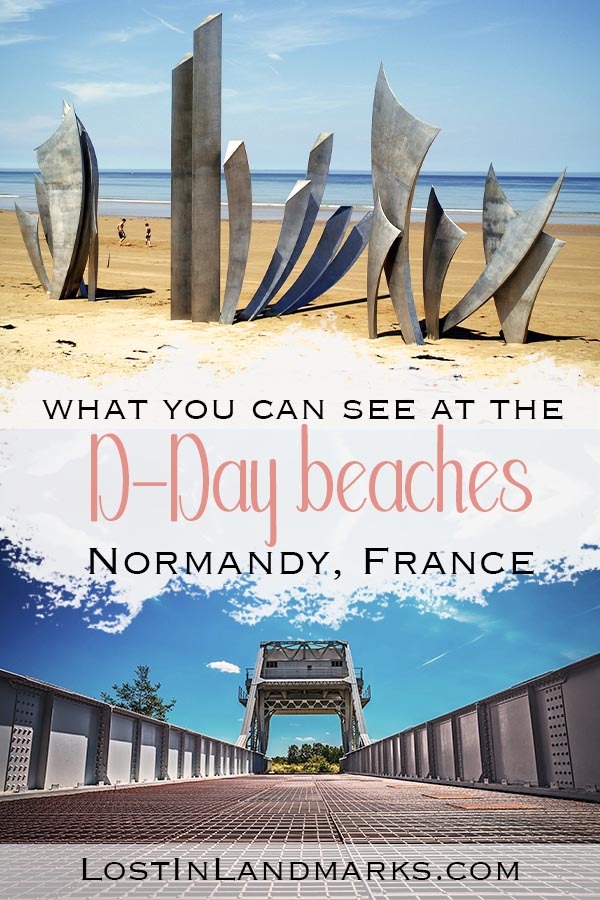
Kirsty Bartholomew
2 thoughts on “Visiting the beaches of Normandy: D-Day landings and WW2 sites – your ultimate guide”
Opening times typically range from 9-10am to 5-6pm, but daylight stretches much further. Therefore, my usual question: which beaches/sites can be acceptably experienced outside 9-18 time bracket?
Good question Pablo – all the beaches are accessible outside of opening times for the visitor centres. I would say to perhaps look at the tide times especially for beaches like at Arromanches as when the tide is out you can walk up to the pontoons but of course when it’s in they are covered. BUT definitely don’t let the fact that the visitors centres not being open deter you from going. Plenty to see!
Leave a comment Cancel reply
- Work with us
- Favorite travel blogs
- netherlands
- switzerland
- family travel
- food and wine
- trip planning resources
- accommodation guides
- travel gear guides
- itineraries
- packing guides
- travel gifts
- health and safety
A trip to Normandy – the beautiful northern coast of France
This article may contain compensated links. See our full disclosure here
If you are in the mood for spectacular coastlines, delicious gooey cheeses and browsing local markets then plan a trip to Normandy in the north of France .
This French region is perfect for wandering pretty towns, soaking up the coastal breezes and walking barefoot on wide sandy beaches.
Northern France is easily accessible from the south of England and London as well as Paris and Belgium. Within a few hours you are soaking up the gallic vibes and getting your French fix in the fresh sea air.
Here is how we spent our days exploring Normandy’s coastal countryside.
What's in this article
4 day northern France itinerary – Rouen & Normandy’s classic coast
Day 1 – rouen: medieval city with half timbered houses, day 2 – picturesque harbour town honfleur, day 3 – trouville by the sea, day 4 – étretat – the spectacular normandy coastline, tips for visiting normandy with kids, more highlights of normandy for your onward journey, resources for planning your trip to normandy.
Northern France is beautiful and historic. I have been a little in love with France my whole life and this is one of my favourite regions.
In Normandy you will find rolling green hills, cows munching on green pastures, some of the prettiest towns and villages in Europe and of course delicious food. Not to mention spectacular coastal scenery.
We used our trusted Lonely Planet guide to help plan our four day trip to northern France starting in Rouen. We made our base in Honfleur and explored that town and nearby Trouville before our finale in Etretat.
Our first stop was the medieval city of Rouen. A thriving city in the Middle Ages, it most famous for its gothic cathedral and association with French legend Joan of Arc. She met her untimely end, burned at the stake, in the city’s Place du Vieux Marché.
For such a pretty place, the city has been the scene of great tragedy over the centuries. Rouen suffered serious damage during both world wars – 45% of the city was destroyed in World War II.
But not to worry, restoration has ensured that visitors can enjoy the charm of its gorgeous half-timbered houses and position on the banks of the Seine.
We wandered the cobbled streets and found a local restaurant – Restaurant La Petite Auberge – that satisfied our need for French food.
Like most regions in France, Normandy has some famous gastronomic specialties. We were keen to try the famous Normandy cider and cheese varieties but we were also tempted by the restaurant’s specialty – les escargots – snails!
Make time to stop at popular Fromagerie François Olivier to pick up some local cheeses when you are in Rouen. You will not be disappointed.
Pro tip – try the local Pont L’Évêque variety – it is soft and pungent just like a French cheese should be
Tip – if you are driving there is a handy underground car park near the Abbatial Saint-Ouen/Monastery of Saint-Ouen
Rouen is a city I would like to return to and explore further. Here are some of the things to do in Rouen that we missed:
- the interior of Rouen Cathedral is breathtaking
- at the Historial Jeanne D’Arc museum you can learn more about this French heroine via a multimedia reenactment of her trial
- the Musée des Beaux-Arts has an impressive collection (plus free admission)
You could easily spend several days in Rouen but those coastal breezes were calling.
We drove along the Seine through the National Park – Parc natural regional des Boucles de la Seine – passing through the countless pretty villages of Normandy along the way.
You can’t help but fall in love with the half-timbered and thatched roofed buildings of Normandy. They are the perfect escape from a busy city life.
Our base for this trip was picturesque Honfleur, a harbour town overlooking the English Channel.
Honfleur is the ideal spot for a few days of relaxing and exploring northern Normandy.
Pretty Honfleur was immortalised by the Impressionist artists including Monet. Since then it has been a hub for artists and there are many galleries in the town.
Honfleur’s old harbour – le Vieux Bassin – is surrounded by colourful buildings and cobbled streets. It is easy to see why the Impressionists were so inspired by this pocket of Normandy. It’s literally pretty as a picture!
Where to stay in Honfleur
Honfleur has some beautiful hotels and B&Bs in the heart of the old town and near the harbour.
La Cour Sainte Catherine – >click here to check prices
- historic B&B in former convent just steps from the harbour
- lovely sun drenched garden where continental breakfast is served
- sitting area in every room
- 2 bedroom apartment suitable for families
Hôtel L’Ecrin – >click here for more information
- friendly hotel close to the old town and harbour
- large swimming pool and pretty garden
- free parking on site
- family rooms
On this occasion we stayed in the old town in a wonderful attic apartment with views of the church and clock tower. I found it using my tried and true method of finding the best short term apartment rentals – you can read about that here .
Our apartment was the perfect vantage point to see the market traders set up their wares on Saturday morning and hear the bells tolling and choir singing from the church below.
> Check accommodation options and latest prices in Honfleur
Things to do in Honfleur
We spent our days in Honfleur wandering around the produce market, choosing pastries, tasting (more) cheese and fruit before heading to the Vieux Bassin (Old Harbour) to admire the sailing boats.
The harbour is lined with colourful cafes and restaurants and has a magnificent 1920s carousel at its mouth. You can easily spend an afternoon simply enjoying the goings on at the harbour.
Don’t forget to visit the Church of Sainte Catherine (pictured above) and its clock tower. Built in the 15th and 16th centuries by local boat builders, these unique structures provide an additional focal point for the city.
Honfleur’s general household and souvenir market is held at the harbour on Saturdays. All the locals turn out and the atmosphere is festive.
If that is not enough market for you, Honfleur hosts a brocante (antique and bric a brac) market on the first Sunday of each month.
Soaking up the atmosphere, taking a walk along the promenade and browsing the shops and galleries built up our appetites. Luckily there are many wonderful eateries in Honfleur.
Where to eat in Honfleur
Of course there is an abundance of seafood to be found at all the cafes and restaurants in Honfleur. But our favourite was La Ciderie specialising in cider and crepes.
I tried the local galichot (pancake), described as a combination between a galette and a blini. I am not sure about that, but it was fluffy and delicious.
In the early afternoon sun we drove the short journey to Trouville to enjoy some beach time. The beach at Trouville is wide, flat and sandy and stretches for over a kilometre.
In other words, great for kids young and old to run amok.
Trouville hosts several seaside attractions including a sandy beach park and fairground rides. These were the highlight for our kids but I enjoyed laying on the sand gazing at the nineteenth century mansions looking down over the beach.
We visited in June and while the weather and sea were a little bit cold for our Australian bodies, there were plenty of people were swimming.
We drove back to Calais via the spectacular white chalk cliffs near the town of Étretat. Here you can walk along the beach boardwalk and admire the cliffs and rock formations.
If you are feeling energetic, climb the cliffs for views of the surrounding coastline. If not, there is a tourist car train – perfect when you are managing tired or little legs.
The town itself has the typical half-timbered buildings of Normandy and you will find many restaurants, cafes and tea rooms catering for hungry visitors.
Normandy is a wonderful destination for families. Apart from the wide sandy beaches we found playgrounds with equipment for all ages in all the locations we visited.
Pedestrianised streets ensure that supervising the little ones is relatively easy and they can explore unhindered.
Kids will quickly discover the fairground ride attractions. Who can resist treating children to a few turns on a carousel when you see the smiles on their faces.
It certainly makes for a happy holiday. And I don’t mind admitting that I enjoyed the carousel rides too!
Our children also loved the sights and sounds of the bustling markets.
They were keen to choose their own market produce including seasonal cherries, apricots and raspberries. And of course they gobbled up the delicious french pastries and crepes.
How to get to Normandy
Getting to Normandy is easy from Paris or the UK.
How to get to Normandy from the UK
If you are driving from the UK, take the Eurotunnel or ferry from Folkestone to Calais.
I prefer the Eurotunnel to the ferry services because it is a lot quicker but obviously that means you pay a bit more.
You could also catch the Eurostar from London St Pancras and pick up a hire car in Calais.
Pro tip – book your Eurotunnel and Eurostar tickets well in advance for the best deals on ticket prices
From Calais it is a 2½ hour drive to Rouen and the A16 and A28. It is another hour from Rouen to Honfleur on the A13.
Flights to Caen in Normandy leave from Southend starting in Spring. You can also fly to Paris and connect to train services from there.
We use Skyscanner to find the best flight deals and plan our trips.
How to get to Normandy from Paris
Paris is understandably a starting point for many trips in France. Once you have wandered the streets , and eaten your way around Paris , head to Normandy for some fresh country air.
Train travel in France is fun and easy. Trains to Rouen from Paris take 1½ hours – even faster on the express – and leave from Gare St Lazare. If you plan well ahead you can pick up fares as low as €10 for this trip.
Alternatively, if you don’t have much time in France, you could join a guided tour of Normandy from Paris. It’s a long day and you would need to choose from:
- Visit a traditional Normandy village
- Explore beautiful Mont St Michel and its spectacular abbey
- Explore Omaha Beach and the visitor center
- Visit the Colleville-sur-Mer cemetery dedicated to fallen American servicemen
- Enjoy a traditional lunch
Normandy is a large region that we had explored several times before. Our goal with this trip was to relax so we did not see some of the region’s main attractions:
Mont St Michel
If the pictures don’t make you want to go, I am not sure what will. Mont St Michel is a magical place and should be on your bucket list. The town and abbey built on a small rocky island has been attracting visitors for centuries.
It is a 2 hour drive from Honfleur to Mont St Michel.
The historic town of Bayeux is just over an hour from Honfleur.
The famous Bayeux tapestry that commemorates the Norman conquest of England in 1066 is found here.
D-Day beaches
Of course many people visit Normandy to pay their respects to American, British, Australian and other Allied soldiers who fought in World War II. Normandy was the scene of the Allied assault into Nazi occupied France and was as a major turning point in the war.
You can take a tour of the Normandy beaches from Caen (just under an hour from Honfleur by car) – > click for ticket info and prices
Giverny – Monet’s Garden
Closer to Paris, you can visit Impressionist master Claude Monet’s beautiful garden at Giverny. You feel like you’ve stepped right into one of his paintings as you wander the grounds. Don’t miss the Japanese bridge and waterlily pond lined with weeping willows.
For more information about visiting Giverny, read our guide to the gardens. If you can’t squeeze Giverny into your Normandy itinerary you can do a combined day trip to Giverny and Versailles from Paris .
I found these useful sites while researching our trip:
- Those keen to discover the local cider can follow the 40km cider route mapped out by the Normandy Tourist Board
- Normandy Then and Now is a fascinating resource full of suggestions, stories and an all round passion for Normandy
- Trouville has an English language website full of interesting information on activities and attractions
- More information about beautiful Rouen
Untold Morsels assists our readers with carefully chosen product and services recommendations that help make travel easier and more fun. If you click through and make a purchase on many of these items we may earn a commission. All opinions are our own – please read our disclosure page for more information.
The creator, writer and photographer behind Untold Morsels , Katy has been travelling and tasting the world since she was a teenager.
Now the proud mum of twins, she hopes they grow up to share her passions of great food, wine and travel. Favourite destination: Italy

The Ultimate 3, 4 or 5 Day Normandy Road Trip Itinerary
Last Updated on February 19, 2024
by Neota Langley
Disclaimer: This article contains affiliate links. That means if you click a link and make a purchase, we may make a small commission. As an Amazon Associate we earn from qualifying purchases. For more information, see our privacy policy.

Located along the northwest coast of France, planning the perfect 3, 4 or 5-day Normandy road trip itinerary is an excellent way to experience this diverse region. Boasting picturesque countryside, charming coastal towns, and iconic landmarks, this is an excellent corner of France to explore.
Whether you’re interested in the history of the D-Day landing beaches, the imposing charms of the Mont Saint-Michel tidal island or want to walk in the footsteps of an impressionist painter, you cannot go wrong with a road trip to Normandy.
Table of Contents
How Many Days in Normandy?
Whether you are hoping to go on a cultural tour of this historically significant region in Northern France or enjoy the picturesque towns and dramatic coastal scenery, you may be wondering how many days to spend in Normandy.
If you only have 3 days for your trip or are passing through as part of a more extended road trip through France, don’t worry. You will still be able to visit the highlights but may have to focus your trip on either the eastern or western side of the region to make the most out of your time.
With 3 days in the Normandy region, you will be able to visit Mont Saint-Michel, Caen and the D-Day landing beaches without feeling rushed.
If you have 4 days in Normandy, you will have time to visit the highlights as well as Honfleur, a charming town on the coast of Normandy that’s known for its picturesque harbour, quaint streets, artistic ambience and the dramatic white cliffs of Étretat.
Ideally, you would spend a full 5 days exploring this varied region. 5 days in Normandy will give you time to visit the highlights as well as a bonus day in Rouen, the historic capital of Normandy, which transports you back in time with its stunning medieval architecture, narrow cobblestone streets, and grand Gothic cathedral.
Those who have more time can continue to explore more of Normandy itself or even head south to explore neighbouring Brittany .

Getting To & Around Normandy
Getting to Normandy is a breeze, with several convenient transportation options available. If you’re travelling from within France, the region is easily accessible by train.
The cities of Caen, Rouen, and Le Havre have well-connected train stations, offering regular services from Paris and other major cities across France. You can view train schedules here.
For those flying in from abroad, the closest international airports are both located on the outskirts of Paris , Paris Charles de Gaulle and Paris Orly.
From there, you can rent a car, drive to Normandy, or take a train to one of the region’s main cities. The train journey from Paris to Normandy takes approximately 1-2 hours, depending on your destination.
If you are visiting from the UK and prefer to take the scenic route, consider taking a ferry. Regular ferry services are operating between UK ports (such as Portsmouth or Dover) and ports in Normandy (such as Ouistreham or Le Havre). It’s a fantastic way to enjoy the sea views and arrives directly in Normandy with your vehicle.
The Eurotunnel is also an option if you are coming from the UK which can be cheaper than the ferry, especially during peak times. However, if you do opt for the Eurotunnel, bear in mind you will have to drive from Calais, which takes around 5 hours.
Taking a road trip in Normandy is the best way to explore this compact region so if you are travelling without your vehicle, you may wish to hire a car. This will allow you time to discover the highlights at your own pace and stumble across the hidden gems along the way.
If you need to rent a car for your trip, you can browse Rentalcars.com which compares prices for major companies.
Normandy has a local network of buses and trains, and the towns and cities are small enough to explore on foot once you have arrived. There is a direct train between the two main cities, Rouen and Caen, but travelling using public transport to the smaller villages can be more fragmented with several changes giving you less time to explore your destination.
If you don’t have access to a vehicle, you may want to consider staying in Paris and taking guided day tours out to Normandy to explore the D-Day sights or Mont Saint Michel.

3, 4 or 5-Day Normandy Itinerary
On this Normandy road trip, we are taking you on a journey from west to east along the region, starting with Mont Saint Michel and ending in the picturesque city of Rouen.
The climate of this region is much the same as the southern corner of the UK, they are close neighbours looking out at one another across the English Channel. During the summer months, you can expect glorious sunshine, long summer evenings and pastel sunsets, but be aware the main attractions can get busy during the peak times.
Spring is a beautiful time to visit, with flowers exploding into bloom after a long winter. The crowds have yet to arrive and you can often enjoy the highlights all to yourself.
The autumn and winter months can be wild, windy and wet so if you are hoping to wander through the streets, stand tall on the white cliffs and take the bridge across the Mont Saint Michel, you may want to avoid these seasons – or pack a decent waterproof.
Day 1 – Mont Saint-Michel
Mont saint-michel village.
You’ll find the captivating rocky mound of Mont Saint-Michel, North of the Normandy coastline, where the Breton coast meets the Couesnon River. With its abbey dating back to the 8th century, this island is one of the Western world’s most ancient Christian pilgrimage sites.
Today, Mont Saint-Michel is a world UNESCO heritage site and is France’s second most visited tourist attraction, pipped to the post by the Eiffel Tower in Paris.
Arrive at Mont Saint-Michel early to beat the crowds, parking spaces can be limited so if you are arriving by car, set the alarm early to avoid disappointment.
If you are arriving by train, head to Pontorson, the closest station to the Mont-Saint-Michel, and then take the free shuttle bus. You can walk across to the island in around 50 minutes, but there is a free shuttle bus from the car park.
Mont Saint Michel is a tidal island and although there is a bridge connecting the island to the mainland, during high tide times eg. spring tides, the bridge can become fully or partially submerged, so check tide times before you set off.
Start your day in the picturesque village, wandering through its narrow streets and admiring medieval architecture. Then, spend some time exploring the shops and boutiques, where you can find souvenirs, local crafts, and tasty treats such as buttery biscuits and cider.
Grab a coffee and a croissant from an artisan boulangerie in the village centre before heading up to the Abbey.

Mont Saint-Michel Abbey
Mont Saint-Michel Abbey, perched atop the rocky island, is a magnificent architectural masterpiece. Dating back to the 8th century, it showcases stunning Gothic design and houses intricate chapels, grand halls, and a beautiful cloister.
Make sure to buy your tickets in advance and download them onto your phone on the mainland as internet connectivity is patchy on the island itself.
Enjoy a delicious lunch at one of the charming restaurants on the island, savouring local specialities like salted lamb or a fresh seafood dish.
Mont Saint Michel is a fortified village, meaning it is surrounded by medieval ramparts. Spend the afternoon walking around these ramparts for a scenic tour of the island with excellent views of the bay. You can also take a walking tour of the area.
This is a spectacular way to enjoy the sunset, especially if you can get up to one of the towers – North Tower, Gabriel Tower or Tour du Roi.
You can either spend the night on the island or head back to a nearby village for more budget-friendly accommodation, such as the historic town of Avranches or the charming coastal town of Cancale, known for its oysters.

Where to Stay in Mont Saint-Michel
Hôtel Vert – Mid-range visitors to Mont Saint-Michel will love this comfortable hotel just outside of the tidal island. They have a range of rooms on offer, breakfast available in the mornings and a great restaurant/bar on site.
Le Relais Saint Michel – Those looking for a high-end option close to Mont Saint-Michel will love this 4-star hotel. Overlooking the bay of Mont Saint-Michel, many rooms have panoramic views of the tidal island and the hotel also offers a shuttle service to and from the attraction.
La Ramade – This hotel in the town of Avranche makes for another great base for exploring Mont Saint-Michel. They have a beautiful location in an old mansion, a number of lovely rooms to choose from, free parking for guests and a fabulous breakfast each morning.
Edd Hostel – Budget and solo travellers will love this highly-rated hostel located within easy reach of Mont Saint-Michel. Offering both dorms and private rooms, they also operate shuttle services to Mont Saint-Michel along with Saint-Malo and Dinan in Brittany.
Not quite what you’re looking for? Click here to browse more Mont Saint-Michel hotels!
Day 2 – Caen
Château de caen.
Caen is a vibrant city, a captivating blend of ancient history and modern vitality. The city showcases its medieval past with picturesque cobblestone streets and charming timber-framed houses.
Begin your day in Caen by visiting the magnificent Château de Caen. Built by William the Conqueror, it stands as a testament to medieval architecture and history. Explore its imposing walls, towers, and ramparts, and delve into the castle’s rich past as a symbol of power and conquest.
Abbaye-aux-Hommes
Next, take a short stroll over to Abbaye-aux-Hommes, another architectural marvel founded by William the Conqueror. This abbey showcases Romanesque design and houses the tomb of the legendary king.
Admire its grandeur, explore its serene interior, and immerse yourself in the rich history and spiritual significance of this iconic Norman landmark.

After enjoying some of the city’s awe-inspiring architecture, head over to stroll through the picturesque streets of Caen’s Old Town, known as the Vaugueux Quarter. Admire the charming half-timbered houses, quaint shops, and cosy cafes.
The old town is the perfect spot to stop for lunch. Enjoy one of Caen’s charming restaurants, indulging in local specialities such as tripe à la mode de Caen (a traditional dish) or delicious seafood. If you have a sweet tooth, opt for a wafer-thin crepe at Crêperie l’Instant.
Memorial Museum
Take the afternoon to explore the exhibits of the Memorial Museum, dedicated to the events of World War II and the Battle of Normandy. Explore the extensive exhibits, including interactive displays and powerful testimonials.
This is the perfect opportunity to delve into the history of the 1944 D-Day landing beaches before taking a tour on day 3. You can book tickets in advance here.
Where to Stay in Caen
Hôtel Mary’s – Located in the centre of Caen, this hotel is a great option for mid-range visitors. Offering a range of clean and comfortable rooms, they have a great continental breakfast available each morning.
Clos Saint Martin – This bed and breakfast is located in a 16th-century mansion in the centre of Caen. Perfect for those looking for a boutique, upmarket stay, there are a range of lovely rooms to choose from along with a hearty breakfast on offer in the mornings.
City’O aparthotel – This aparthotel is a good option for those looking for a great self-catering option in Caen. They have a number of fully-furnished flats available and a great location for exploring all this lovely little city has to offer.
Not quite what you’re looking for? Click here to browse more Caen hotels!

Day 3 – D-Day Beaches
Omaha beach.
A must-visit on any itinerary for Normandy, day 3 brings us to the hallowed grounds of the D-Day beaches. If you only have 3 days in the region, this is a highlight and is the perfect way to round off your trip.
These shores, locations of the historic World War II invasion, bear witness to the bravery and sacrifice of the Allied forces. Immerse yourself in the stories of courage and resilience that unfolded on these beaches, forever shaping history.
The best way to visit the D-Day beaches is by road trip, with your own vehicle you can take your time, visiting the beaches at your own pace. However, if you don’t have access to a car, several guided group day trips or private D-Day tours are available from Paris or from nearby towns – such as this day tour from Bayeux.
Start your day by heading to Omaha Beach, one of the most significant D-Day landing sites. Visit the Omaha Beach Memorial Museum to learn about the Allied forces’ heroic efforts and the challenges they faced during the invasion.
Pointe du Hoc
Continue to Pointe du Hoc, a strategic location where U.S. Army Rangers scaled cliffs to neutralise German artillery. Explore the well-preserved bunkers and enjoy panoramic views of the coastline.
After taking a short lunch stop to enjoy a packed lunch or a bite to eat at one of the local restaurants, make your way to the American Cemetery and Memorial in Colleville-sur-Mer. Pay your respects at the solemn gravesites and reflect upon the sacrifices made by the soldiers.

Arromanches-les-Bains
Next, visit the Arromanches-les-Bains and the Mulberry Harbor remains. Discover the innovative engineering behind the artificial port and its vital role during the Normandy invasion.
If time allows, visit the Juno Beach Centre, dedicated to Canada’s contribution to the D-Day landings. Explore the exhibits and gain insight into the experiences of Canadian soldiers.
As the sun goes down, take a moment to reflect on the beaches themselves, where history unfolded. Then, you can either head back to Caen to spend the night or head on to Honfleur, our destination for day 4.
Alternatively, if you have more time, you can also visit the town of Bayeux on the way back. This is currently home to the Bayeux Tapestry which depicts the 1066 Norman Conquest and dates back to the 15th Century.
Day 4 – Honfleur
Honfleur .
Honfleur is a charming old port town known for its picturesque harbour, vibrant art scene, and quaint streets lined with colourful half-timbered houses.
Spend the morning wandering around Vieux Bassin, the heart of the port. Quaint buildings, artisan shops, bakeries and restaurants line the street, looking out on the harbour. You can organise a walking tour if you prefer.
Honfleur is pretty as a picture and has long been an artistic haven. Museums and galleries showcase masterpieces that pay homage to its Impressionist heritage. Notably, the birthplace of Eugène Boudin, mentor to Claude Monet, Honfleur holds pride in its connection to these renowned artists.
You’ll find numerous galleries across the town, but if you don’t feel like meandering through a gallery, you’ll often find artists set up with easels along the Vieux Bassin, painting the waterfront scenes just as the impressionists did 200 years before them.
Honfleur’s most famous landmark is the largest wooden church in France, Église Sainte Catherine. A short walk away from the hustle and bustle of the harbour, the church is free to enter and the interior is a marvel of craftsmanship.
The church was built by shipbuilders in the 15th century using wood from local forests. Don’t forget to look up at the unique ceiling which looks like two upside-down ships’ hulls.

Grab a picnic from Honfleur, a variety of local delights such as Camembert and Pont-l’Évêque Cheese or a slice of Tarte Tatin (caramelised apple tart) and take a drive out to the dramatic white cliffs of Étretat. You can also take a bus from Honfleur to Étretat with a change in La Havre.
Nestled along the picturesque cliffs of the Alabaster Coast in Normandy, Étretat is a charming seaside village renowned for its breathtaking natural beauty. Its iconic white chalk cliffs, including the majestic formations of the Falaise d’Amont and Falaise d’Aval, have inspired countless artists and writers throughout history.
Take a leisurely stroll along the promenade, admiring panoramic views of the English Channel and the famous Arch and Needle rock formations. Then, for the best view of the Needle Rock and Elephant Trunk, head up to the cliff paths and take a hike out of the village.
The views from either end are breathtaking, but Falaise Aval offers better views of the needle and the third arch, making it the most popular route.
Spend the evening in the sunshine sitting out on a restaurant terrace in the village. Normandy is known for its apple orchards, so make sure to sample some local cider with your dinner or try some apple brandy, known as calvados.
If you only have 4 days, this is the perfect way to round off your trip.

Where to Stay in Honfleur
B&B Le Fond de la Cour – This cosy bed and breakfast makes for the perfect mid-range base in Honfleur. They have a number of lovely rooms on offer, a delightful garden courtyard and terrace, and a wonderful breakfast in the mornings.
A L’ecole Buissonniere – Another rustic yet comfortable bed and breakfast, this is a great place to base yourself in Honfleur. They have a number of comfortable rooms on offer, a wonderful breakfast available in the morning and a great location.
La Petite Folie – Situated in the historic centre of Honfleur, this modern bed and breakfast is a great choice for those looking for a comfortable base in this area of Normandy. They have a number of great rooms to choose from and plenty of amenities for guests.
Not quite what you’re looking for? Click here to browse more Honfleur hotels!
Day 5 – Rouen
Rouen cathedral.
Welcome to Rouen, the historic capital of Normandy, France. This enchanting city, steeped in rich history and architectural splendour, boasts magnificent Gothic cathedrals, charming cobblestone streets, and a vibrant cultural scene.
Start your day in Rouen by visiting the magnificent Rouen Cathedral, a masterpiece of Gothic architecture immortalised by Claude Monet’s paintings. Admire the intricate facade and explore the interior, including the stunning stained glass windows.
During the summer months, make sure to return to the cathedral at dusk, as it transforms into a sound and light show. The themes change regularly, ranging from Joan of Arc, the Viking adventure or the impressionist movement.
Explore the Historic Centre
Next, take a stroll through the charming streets of the historic centre, making your way to the Gros Horloge, an iconic 14th-century astronomical clock. The clock’s mechanism is thought to be one of the oldest in France, the movement having been made in 1389.
Spend the early afternoon exploring the Rue du Gros-Horloge, a vibrant street lined with shops and cafes. Indulge in retail therapy or relax at a sidewalk café while enjoying the lively atmosphere. You take a walking tour of the area.
This is the perfect place to stop for lunch at one of Rouen’s cosy bistros, savouring local specialities such as duck confit, creamy Normandy cheeses, or a savoury galette.

Musée des beaux-arts de Rouen & Musée Le Secq des Tournelles
After lunch, take your pick from several world-class museums and galleries. Visit the Musée des beaux-arts de Rouen (Fine Arts Museum of Rouen), home to the second-largest collection of Impressionist works in France.
For a more unusual artistic experience, the Musée Le Secq des Tournelles is a must-visit. Home to unusual, ornate pieces of wrought ironwork.
Ordinary objects like hinges, tools, signs, locks, and cutlery undergo a surreal transformation, resembling works of art straight out of the Surrealist movement. They metamorphose into whimsical faces, intricate swirling patterns, and animal-like forms.
Joan of Arc Square
If art is not your thing, head to the Joan of Arc Square and the Church of Saint Joan of Arc, an open-air museum experience dedicated to retelling the story of Saint Joan of Arc. This is a truly immersive experience with projected images and films on the building’s stone walls.

Seine River Cruise
If you have time, taking a boat trip on the Seine River is a wonderful way to view the city and Normandy countryside from a different perspective to bring your 5 days in Normandy to a close.
Leaving from Rouen, embark on a 1.5-hour sailing around the marina. Learn about the history of the area with a local guide, before returning to the docks.
Those who have a bit more time or are heading back to Paris from here may love to stop in the town of Giverny, which was once home to impressionist painter Claude Monet.
Normandy is a diverse region, with bags of history and culture to discover alongside the beautiful French countryside. Whether you are lucky enough to have 5 days to explore Normandy or are only passing through, you’re bound to be enchanted by this region. So pack your picnic, and hit the road for a Normandy road trip you’ll never forget.
Are you planning to visit Normandy? Have any questions about this itinerary? Let us know in the comments!

Related Posts:

The Perfect 2 to 3 Days in the Loire Valley Itinerary

Is France Expensive? A France Trip Cost Guide

8 Best Places to Stay in Normandy

About Neota Langley
Neota is a writer for The World Was Here First. Born and bred in Cornwall, she can usually be found with hiking boots on, ready to embark on an adventure. For the last 6 years, she has travelled throughout Europe in her self-built campervan with her trusty canine companion, Ivy. She loves exploring France, the Nordics and spending time in Alpine destinations.
Day 5 – Rouen
Seine River Cruise – we are travelling this coming May and are following your suggestions. Do you know the name of the Co. we could book a tour with? Thank you Jane Canada
Leave a Comment Cancel reply
Normandy Travel Guide

Courtesy of © Marco Bottigelli | Getty Images

Why Go To Normandy
Skirting the English Channel and occupying a hefty portion of northern France, Normandy is known for its Camembert cheese, its apple orchards (thus, cider and brandy too) and its cow-peppered landscape, complete with quaint cities and towns like Rouen, Bayeux and Giverny . But it's also revered for its momentous place in history. The site of the 1944 D-Day invasion, Normandy's beaches , saw a death toll in the thousands but also a changing tide in World War II. Its military cemeteries, memorial museums and the D-Day landing sites bring a huge number of visitors to the region.
Another highlight of Normandy is one of France's most famous tourist sights, the stunning Mont Saint-Michel , but almost at every turn, you'll find historic castles, churches and charming small towns. You should visit Normandy for the history, the food and slow pace of life, but you should also come for a taste of France at its friendliest. This is not glitzy Nice or Cannes – neither is it cosmopolitan Paris – this is where France's salt-of-the-earth citizens congregate.
Find Flight and Hotel Deals
Navigate forward to interact with the calendar and select a date. Press the question mark key to get the keyboard shortcuts for changing dates.
Navigate backward to interact with the calendar and select a date. Press the question mark key to get the keyboard shortcuts for changing dates.
- # 6 in Best Beaches in France
- # 9 in Best Places to Visit in France
Best of Normandy
Best hotels in normandy.
- # 1 in Hotel Villa Lara & Villa Augustine
- # 2 in Hotel de Bourgtheroulde, Autograph Collection
- # 3 in Hotel Barrière Le Normandy Deauville
Best Things to Do in Normandy
- # 1 in D-Day Beaches
- # 2 in Mont Saint-Michel Abbey (Abbaye du Mont-Saint-Michel)
- # 3 in Cathedrale Notre-Dame de Rouen
Popular Tours

D-Day Beaches Shore Excursion with Packed Lunch from Le Havre
(30 reviews)
from $ 205.19

Normandy American D-Day Beaches Full Day Tour from Bayeux
(1027 reviews)
from $ 137.12

American D-Day Beaches Private Tour Full Day Tour from Bayeux
(322 reviews)
from $ 361.99
Normandy Travel Tips
Best months to visit.
The best time to visit Normandy is June to August. Though this is the height of the peak tourist season – which can last from May to mid-October – this period also promises the most pleasant weather. Fall and spring can be optimal shoulder seasons if you're hoping for fewer crowds and better accommodation rates, but a visit during this time will likely require coats (highs hover around the 50s). Winter will usher in the best hotel rates, but some of the businesses in the region's small towns and cities will likely close up shop for the season. Plus, some of the region's top museums close for the month of January.
Weather in Normandy
Data sourced from the National Climatic Data Center
What You Need to Know
- Consider winter closures If you're hoping to plan a winter trip to save money, check to see if the key attractions you want to visit are open. Some of the region's museums close in January or operate on shortened hours during the winter season.
- Consider a tour guide Though it's easy to tour some of the region's most famous D-Day sites without a guide, past visitors say a tour guide provides necessary historical context (along with transportation between sites).
- Consider a museum visit Normandy is considered the birthplace of impressionism, so you'll want to visit an art museum or two to take in some of the region's most famous pieces. Popular stops include the Musée d'art moderne André Malraux and the Musee des Beaux Arts de Rouen, among many others.
How to Save Money in Normandy
- Head to the market Do as the French do and pick up fresh foods at the market. A picnic of cheese, bread and other local items, even wine, will make for a tasty meal that doesn't break the bank.
- Take the train If you aren't in a hurry, traveling by train can be less expensive than renting a car and you get to take in the sights instead of navigating in a new place.
- Travel during shoulder season If you can avoid a trip in the summer – especially August – you can score a hotel deal.
Culture & Customs
Normandy as a whole is quite friendly to travelers, and areas around the D-Day Beaches are used to American tourists. A great way to bridge the cultural divide is to learn a little bit of French. While many locals know English (especially in tourist areas and hotels), a little effort from your end can go a long way.
Pleasantries are highly regarded in French culture. Saying a bonjour ("hello" or "good day") or bonsoir ("good evening") will not only show that you're making an effort, which the French appreciate, but enhance your own cultural experience. Merci is "thank you" and s'il vous plait is "please." If you're at a loss for words, politely ask the waiter or shop attendant Pouvez-vous m'aider? ("Can you help me?") or "Parlez-vous anglais?" ("Do you speak English?"). Another helpful phrase: Excusez-moi ("Pardon" or "excuse me").
France uses the euro, and major credit cards are accepted at most establishments in Normandy. Since the euro to U.S. dollar exchange rate fluctuates, be sure to check what the current exchange rate is before you go. Keep in mind the exchange rate when you tip and make purchases. Some smaller shops, bakeries or bistros may only take cash, though, so keep some euros on hand just in case. Most restaurants and cafes will include a 10 to 15% service charge ( service compris ) on the bill. You can leave some additional change for exceptional service, if you wish.
What to Eat
Restaurants around Normandy love to celebrate their dairy products and their fruits, which they are rightly proud of. The region's rich pastures and bucolic farmlands produce a rich bounty of these staples. Don't miss any opportunity to sample Normandy's four distinct cheeses: Camembert, Livarot, Pont l'Evêque and the heart-shaped Neufchâtel. There is even a Route des Fromages that highlights the four cheeses through stops at museums, farms, towns and restaurants. These cheeses are often served as dessert and pair well with the ever-present apple-based beverages from the region, such as cider, perry, Calvados and Pommeau, made from local apples and pears. Le Volet qui Penche in Bayeux is a popular wine bar known for its charcuterie and local cider.
Considering Normandy boasts hundreds of miles of coastline, seafood is another favorite, with lobsters, scallops and shrimp on many menus. Michelin starred-restaurants are also easy to come by in Normandy. If you're willing to splurge, restaurants like Jean-Luc Tartarin , Gill and Le Pily come highly recommended.
Getting Around Normandy
The best way to get around Normandy is by car. Many travelers fly into Paris , then drive or take the train to Normandy. However, Normandy does have two regional airports, Aéroport de Caen-Carpiquet (CFR), which welcomes regular flights from Air France and regional airliners, and Aéroport de Deauville-Normandie (DOL). Rental cars are readily available at any of the airports. Other options from Paris include traveling by train, bus or with an organized tour, of which there are any number of companies offering daytrips.
SNCF trains depart from Paris' Gare Saint-Lazare and Paris-Montparnasse several times a day to a variety of towns in Normandy, including Rouen, Giverny, Caen and Le Havre, among others.
Entry & Exit Requirements
A United States passport is required for U.S. residents traveling to France; children of all ages must have them, too. Your passport must be valid for at least three months beyond your date of departure. U.S. citizens do not need a visa unless they plan on staying longer than 90 days. Visit the U.S. State Department's website for the latest information on exit and entry requirements.
Normandy is full of charming fishing villages.
Explore More of Normandy

Things To Do
Best hotels.

You might also like

# 1 in Best Christmas Vacations

Aix-en-Provence
# 4 in Best Cheap European Honeymoon Destinations

If you make a purchase from our site, we may earn a commission. This does not affect the quality or independence of our editorial content.
Recommended
The 18 Best Napa Valley Wineries to Visit in 2024
Lyn Mettler|Sharael Kolberg April 23, 2024

The 25 Best Beaches on the East Coast for 2024
Timothy J. Forster|Sharael Kolberg April 19, 2024

The 50 Best Hotels in the USA 2024
Christina Maggitas February 6, 2024

The 32 Most Famous Landmarks in the World
Gwen Pratesi|Timothy J. Forster February 1, 2024

9 Top All-Inclusive Resorts in Florida for 2024
Gwen Pratesi|Amanda Norcross January 5, 2024

24 Top All-Inclusive Resorts in the U.S. for 2024
Erin Evans January 4, 2024

26 Top Adults-Only All-Inclusive Resorts for 2024
Zach Watson December 28, 2023

Solo Vacations: The 36 Best Places to Travel Alone in 2024
Lyn Mettler|Erin Vasta December 22, 2023

26 Cheap Beach Vacations for Travelers on a Budget
Kyle McCarthy|Sharael Kolberg December 4, 2023

The 50 Most Beautiful White Sand Beaches in the World
Holly Johnson December 1, 2023

How to Plan the Perfect Paris to Normandy Trip (+ Itinerary)
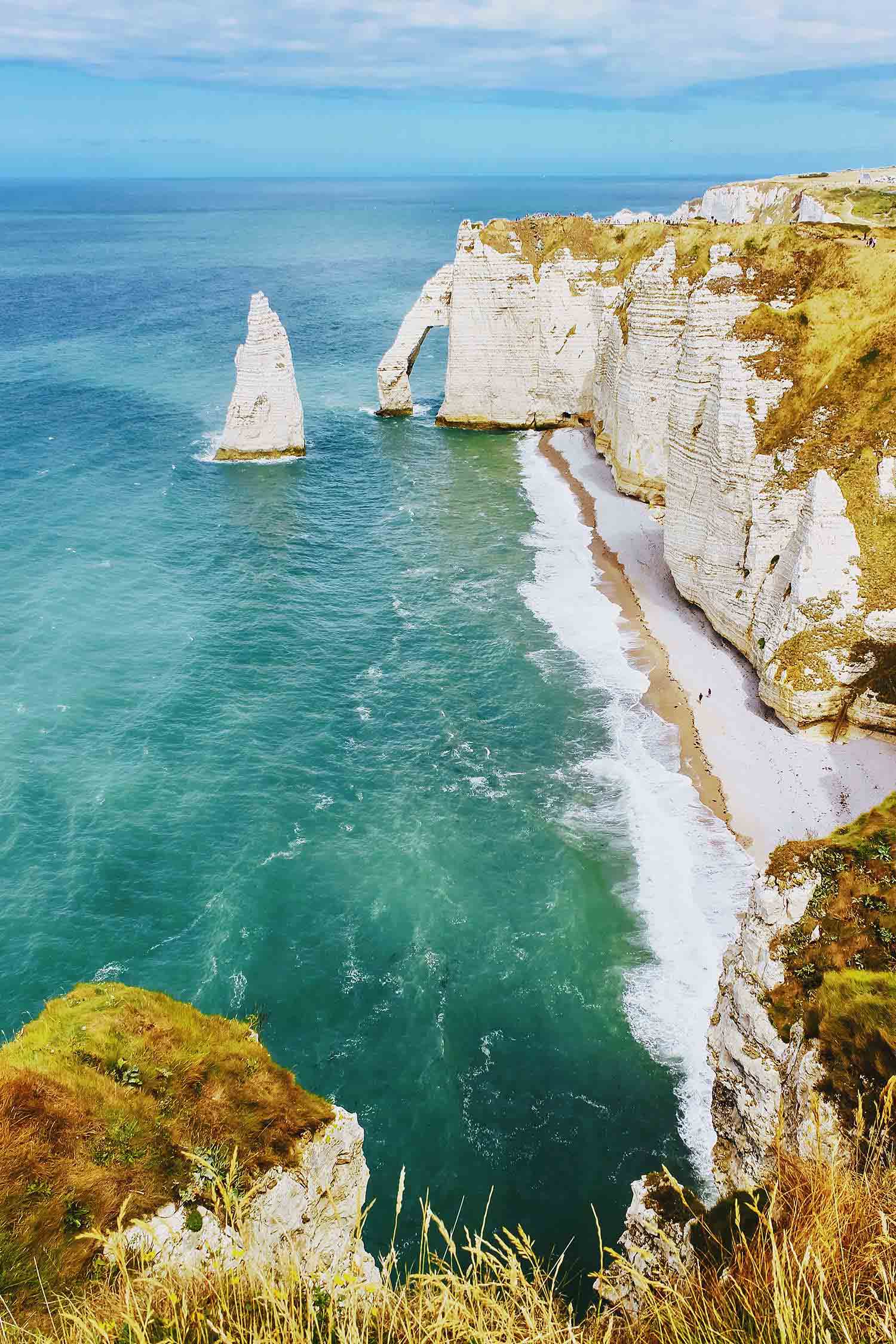
Paris to Normandy
With the 75th anniversary of D Day approaching, it’s a momentous time to visit the World War II memorial sites in Normandy .
Here’s a practical guide about how to get from Paris to Normandy!
Quickly jump to:
Where is Normandy
- Normandy’s Best D-Day Sights
- Visiting as a Day Trip from Paris
- Visiting via Guided Tour (recommended)
- Staying in Bayeux vs Caen
How to Get from Paris to Normandy
ADVERTISEMENT
Or save this article to read later by pinning it ⇟
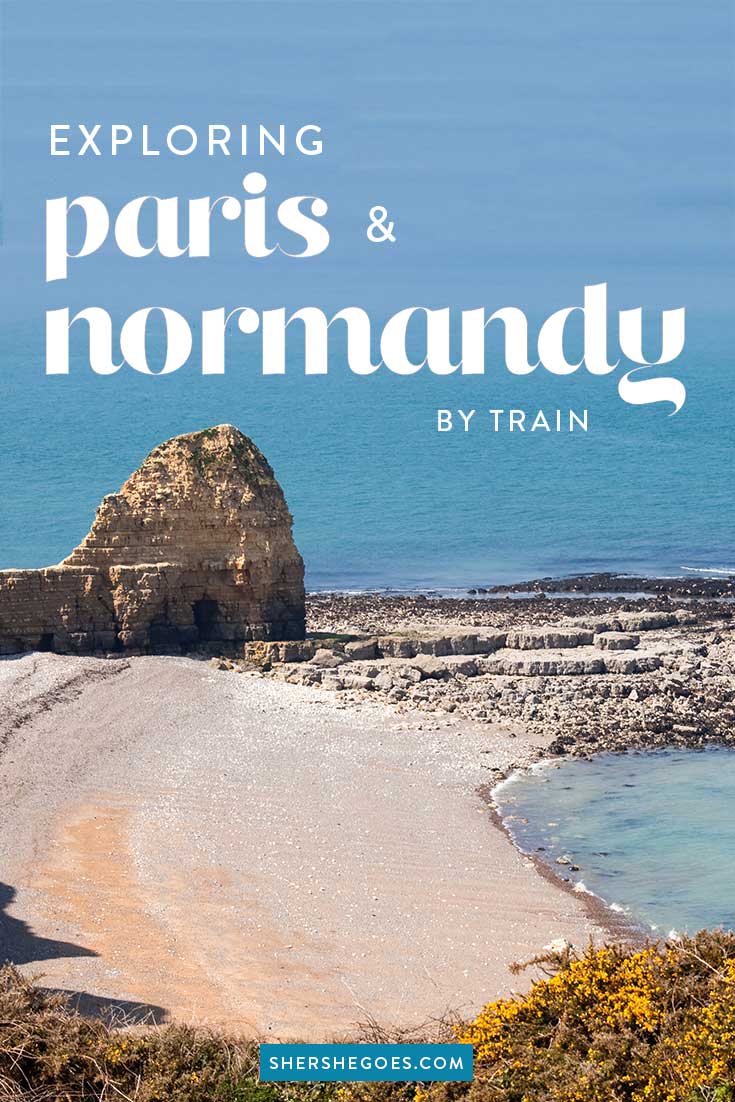
Normandy is one of the 18 regions of France and located in the north.
Its beautiful coastline is most famous for the church of Mont Saint Michel, a medieval monastery perched on an island off the shore, and the World War II beachheads where the Allies launched their offensive attack on five beaches for D Day.
There is lots of significant history in Normandy, due to its close proximity to England.

A Brief History of Normandy
Norman lords led by William, the Duke of Normandy, and later named William the Conqueror, crossed the English Channel to successfully capture the throne of England.
A few centuries later, Normandy wavered back and forth between English and French control during the Hundred Years War. Plantagenet King of England and Crusader Richard the Lionheart is buried in Rouen, the regional capital of modern-day Normandy.
Whether you like history, small towns or great cuisine, there is so much to explore in Normandy!

How Far is Normandy from Paris
Normandy lies roughly 200 km (approx 125 miles) west of Paris.
Some quaint towns, like Giverny , can be easily explored on a leisurely day trip from Paris. Others, like Mont Saint Michel and the World War II memorials along the far northwest coast, are better explored by staying overnight.
Visiting Normandy for D Day
Since most Americans head to Normandy to see the D Day beaches , I’ll go into depth about how best to visit them below.

Day Trip from Paris to D Day Beaches
It’s possible to see the d-day landing beaches in a day trip from Paris, but fair warning – it will be a brutally long day.
For context, the Normandy beaches are spread out across 50 miles, from east to west, in an area far from Paris with lots to see. You’ll likely have just enough time to see a couple of the main sites briefly.
With that being said, if all you have is a day, one day is better than nothing!
How to Day Trip from Paris to Normandy
1. First take the train from Paris into Bayeux or Caen.
These are the two historic cities nearest to the Normandy beaches. Both are easily accessible by train from Paris but the one way train ride takes roughly 2.5 hours.
I cover how to take the train in more depth, below.
2. Next, I would definitely hire a local guide or pre-book a D Day tour
By booking ahead, the guide will meet you at the train station in Normandy and care of all the logistics to getting around Normandy. Normandy is the countryside, so it’s pretty difficult to get around without a car.
Local guides are really fantastic – as they are typically always led by locals who can provide a full historical context of the memorials, ensuring that you can see and do as much as possible.
Most group tours start early in the morning and end around 6pm, so then you can take the evening train back to Paris and arrive in time for a late dinner, around 9pm.
But, honestly, this will be a rushed day.
It’s even better if you have the time to stay overnight in Bayeux or Caen for a night or two, as there is much more to Normandy than just the 5 landing beaches.
Tips for Visiting the Normandy Beaches
Most guided tours to the D Day sights will start early in the morning, around 9 – 9:30am, so you will need an early train from Paris to Bayeux, or better, arrive in Bayeux the night before.
If you want the freedom to explore on your own, there is a Hertz car rental in Bayeux, at the Total gas station outside the city. In Caen, there are a ton of rental car offices to choose from.
Browse car rental rates for your dates here .
Normandy D Day Tours
For the D Day sights in particular, I don’t recommend trying to use public transportation as it will waste a lot of time trying to get around.
The most memorable part of our visit was the history, background and depth which our guide provided.
Here are some popular D Day tours

Bayeux vs Caen
The two closest towns to the Normandy beaches are Bayeux and Caen .
The two cities are roughly 20 miles apart, or about 30 minutes driving distance. If you have a couple of days to spend in Normandy, definitely visit both!
They are each relatively central to the D Day sights – it simply depends on how you want to explore Normandy. Let me explain..

Bayeux is a charming French town, with a really quaint ‘small town’ feel. It has under 15,000 inhabitants and is small enough to walk around on foot. The riverfront area is very picturesque and the historic center is a very pretty area with cute shops and great restaurants.
Medieval Bayeux is most famous for its cathedral (just as stunning as Paris’ Notre Dame) and the historic Bayeux Tapestry (showing the Norman conquest of England). Woven by the wife of William the Conqueror, the Bayeux Tapestry is one of the oldest in the world that remains intact and has its own dedicated museum.
During World War II, it was in Bayeux that Charles de Gaulle made his famous speech proclaiming France’s allegiance to the Allies. There is a Battle of Normandy WWII museum to visit and the German Gun Batteries at Longues sur Mer. Bayeux was virtually untouched during the Battle of Normandy.
But, Bayeux is a bit more touristy and expensive. The town quiets down early, around 5pm. Bayeux also has fewer direct trains from Paris so you will often have to change in Caen, and there is just 1 car rental agency in town, outside the train station.
If you plan to pick up a rental car and drive around Normandy , I wouldn’t recommend taking the train from Paris to Bayeux. But, if you plan to take a guided D-Day tour, most tours will originate from Bayeux so riding the train here makes sense.
Best for: D Day Tours
Where to Stay in Bayeux: Hotel Lion D'Or
This historic inn is cozy, modern and perfect for those wanting to stay in quaint Bayeux to see the D Day beaches. It's within walking distance to tons of shops and restaurants and also very affordable.
Book rooms: Hotels.com , Booking.com
Check rates: TripAdvisor

PROS :
Caen feels quite vibrant and modern, with great options for dining, hotels and nightlife. It has lots of direct train connections to Paris and also lots of car rental options . This city is a great base for those wanting to road trip Normandy.
Caen boasts one of the best World War II museums in France, the Caen Memorial Museum, which is just 15 minutes from the D Day beaches. Also worth exploring is the castle of William the Conqueror and medieval fortifications.
Caen is a convenient base for exploring many of Normandy’s coastal towns like Dieppe, Honfleur, etc. The city is a central hub for both train and bus connections.
Most people who visit think Caen is ‘ugly’ in comparison to Bayeux. But, there’s a lot of interesting background history here..
Caen played a key role in WWII during the Battle for Caen, a fierce fight which lasted for 2 months in the summer of 1944. Some consider the city to have been martyred during Operation Overlord, as the Allies were forced to bomb the city and countryside extensively.
After the war, the city was slowly rebuilt in dreary concrete. Caen today is a large industrial city, with over 100,000 inhabitants.
Best for: Visitors who plan to see more of Normandy
Where to Stay in Caen: Hotel Le Dauphin
Hotel Le Dauphin has a terrific location near the Chateau de Caen, in the historic city center. Beds are comfy, the on site restaurant is pretty good, and there's also tons of nearby restaurants and shops to explore.
Book rooms: Booking.com

How to Get to Normandy from Paris
From Paris, you have 3 main options:
- Cruise on the Seine River
- Take the Train
Seine River Cruise
I’ve been to Normandy many times, but most recently we opted to go via cruise. It was SO much more convenient to have all the transportation taken care of and the guides we had were excellent. You can read more about our Seine River cruise experience here .

Renting a Car
France’s A13 highway (the first motorway in the country) runs from Paris to Rouen . You can reach almost all of Normandy’s most famous places with the motorway.
Check car rental rates for your dates here .
Driving from Paris to Normandy by Car

Taking the Train from Paris to Normandy
It’s also very doable to take the train from Paris.
In France, the national rail system is called SNCF and trains will leave from either of two Paris stations: Gare Saint-Lazare and Gare Montparnasse / Vaugirard.
Normandy is a region, so you need to pick an arrival town for your train ticket. Here is a list of the train options for some of the most popular places in Normandy.
Paris to Normandy by Train
Note: The times are just for reference. Actual duration will depend on the train you take, as there are often multiple options with both slow trains and faster direct trains.
For visiting the D Day sites, the closet train station is either Bayeux or Caen. For visiting Mont Saint Michel, the closest train station is in Rennes.

Train Schedules
SNCF typically releases its train schedules 90 days prior to departure, at which point you can book your tickets.
For peak season (July to August), SNCF will sometimes open the train schedules earlier. If you are seeing that a route ‘doesn’t exist’, you’re likely just browsing too early.
Book as soon as you have settled on your dates – it can save you nearly half price as fares will rise with time. There are a couple different ticket options . The cheapest fare is non refundable. If you aren’t set on your dates or want some piece of mind, purchase the flexible tickets which can be exchanged or refunded.
How to Buy French Train Tickets Online
Ah, French bureaucracy.
The French railway website has different subsidiary websites for countries around the world. If you speak French, are using a computer located in France and have a French credit card, you can buy online directly very easily.
Here’s what to do if you’re located outside France.

Where to Buy French Train Tickets
Don’t buy from sncf.com if you are in the US, as the website will automatically re-direct you to a US subsidiary that is known to sell only higher priced fares for the US market, and does not allow you to choose your seat class.
Instead, use Omio , which syncs up to SNCF’s ticket system and sells French train tickets for a much more wallet friendly price.

Final Train Travel Tips
If you are printing your tickets in France at the train station, make sure to bring the credit card you used to purchase the tickets.
If your credit card has a chip, you can use the ticket machine. If it does not have a chip, you will need to go to the ticket window.
These printed tickets should be validated before boarding. Look for the yellow machines at the entrance to each platform that say ‘Compostez votre billet’. Failure to do so can result in a fine.
If your tickets are the print at home kind, don’t worry about validating them. It’s not needed.
There are so many great reasons to visit Normandy. What’s your main reason?
Visiting Normandy – Travel Checklist
We took a red eye to Paris from JFK, then sailed on the Seine to Rouen on a river cruise . You can check for flight deals here and set an alert for your dates.
It's also easy to take the train from Paris to cities throughout Normandy. Check my post here for more logistical information on taking the train in France and how not to buy tickets.
In Normandy, there's so much to see over a large area that I'd recommend basing yourself in a city for a couple nights to take day trips, then moving to another city. For the D Day beaches, Bayeux and Caen are both popular bases. Check here for deals on Normandy hotels .
Lastly, be sure to visit Paris with travel insurance . Whether you get injured and need to be hospitalized, your phone gets stolen, or a flight delay leaves you with nothing but the clothes on your back, travel insurance will help when you need it most.
During our recent trip, riots in Paris shut down the city center and forced a closure of all the main sights (the Louvre, Versailles, etc). Get a quote for your trip here .
You Might Also Enjoy:
Normandy Vacation Planning
Cruising on the Seine River from Paris to Rouen
The Most Beautiful Places in Normandy
21 of the Best Things to Do in Normandy
Normandy Towns
Quick Guide to Rouen , Normandy's Capital
Paris to Normandy Day Trips: Vernon & Auvers-sur-Oise
Visiting Giverny & Monet's House
Where to Stay in Giverny
WWII Memorials
How to See Normandy Beach & D-Day Sites
Visiting the Normandy Cemetery in Remembrance of D-Day
Follow me @Sher She Goes on
Youtube | Tiktok | Instagram
You may also enjoy:
Dutch windmills, cheese & tulips: 5 day trips from …, review: alila villas uluwatu, bali where modern …, the perfect ireland itinerary & road trip, conrad bangkok hotel, 10 comments.
- Pingback: Visiting Normandy Beach in Remembrance of D-Day
- Pingback: The Prettiest Towns in Normandy: Where Impressionist Art Was Born!
- Pingback: Best Things to Do in Normandy (D-Day Beaches, Medieval History & More!)
- Pingback: Sailing on the River Seine from Paris to Normandy
Hello – your site is very informative. I have a question about the train from Paris to Bayeux — your site says that this train is about 2 hours, but when I check the SNCF website it shows 6 – 7 hours. We plan to visit in early June but I think train schedules are posted only 3 months ahead so I checked a Feb date. Will there be more/quicker trains in June ? Many thanks Liz
Hi Elizabeth, Yes there should be much more frequent, faster options in the summer.
Bonjour! Planning a trip the end of April. We are meeting a tour in London but we have 2 days ahead of the tour to visit Normandy. I would like to leave Bayeux and go to London without going back to Paris. How would you suggest we travel ?
Hi Sher: Thanks for your great travel tips. I will be visiting Normandy in October 2020 and cannot figure how to reach Bayeux by train from CDG airport on our day of arrival. Alternatively we may consider renting a car, biut prefer not to drive as first option. Thanks.Alma
Very Helpful information. well done.
Leave a Reply Cancel reply

LITTLE SHERPA TRAVELS
See the world in just a weekend | short break travel guides and local insights to add more adventure into your limited time off
Travel guides for australia, usa, south east asia & more.
- Oct 28, 2019
Normandy, France: A 3 day Road trip itinerary
Updated: Oct 13, 2020
Experience the best Normandy, France with this ideal 3 day road trip itinerary and travel guide featuring all of the top things to see and do in and around Normandy.

Sometimes the best trips are the ones entered into unplanned and with little expectations. Before visiting, our knowledge of Normandy was limited to the association with its D-Day beaches and dreamy pictures of Mont Saint Michel. This Northern seaside region of France wouldn't have generally been high on our list of places to visit, but thanks some close friends, we ended up here. Living a world away, in the cosmopolitan city of Singapore, we've been lucky enough to meet wonderful people from all over the globe. Sitting in a Chinese language class several years ago a friendship bloomed between us and a lovely French couple from Normandy. This year we were invited to attend the baptism of their children in their hometown, where Andrew would become their daughters' Godfather. It was an invite we wouldn't have missed. Thanks to them we got to experience this historical region of charming seaside towns and rolling green fields.
This post contains some affiliate hotel links, if you click through and book via these links we will get a small commission at no extra cost to you.
Getting to and around Normandy:
We flew into Caen Carpiquet airport via a daily direct flight on Flybe from London Southend Airport. We rented a car from Europcar for 4 days during the trip which we were easily able to collect and return to the airport. As most towns are spread out across the region, having the flexibility of a car to get around made life easy for us, despite having to learn to drive on the other side of the road through narrow laneways. Here is some of the beautiful countryside lanes we passed by during our travels:

Where to stay: Hotel La Glycine Benouville
We drove through narrow winding roads of quintessentially French-looking country brick houses and pulled up in the small neighbourhood of Benouville , just north of Caen (20mins drive from the airport). We had booked to stay at the Hotel La Glycine , a small boutique hotel with brick exterior covered in green vines and bright purple flowers. This building had been standing since at least world war two. Unbeknown to us, we had selected to stay in the very first neighbourhood liberated in France during World War Two . We were surrounded by history, greeted on entry to historical pictures of the celebrations outside of the building post-liberation.
Our lasting impression of this hotel was the smell as we walked passed its restaurant. It was a smell of warm, meaty and fresh ingredients cooking. On our second night, we would enjoy a four-course meal here, including foie gras, tender veal steak, a seemingly limitless supply of cheese selections. It was one of our favourite meals of the trip and we highly recommended to book if staying there.

Normandy Accommodation: Other Normandy hotel deals in Caen
Our normandy, france itinerary - the summary:.
Day One: We journeyed back to the 6th June 1944, D-Day during World War Two. Our itinerary started with a brief visit to the small Overlord museum, providing context on the invasion and its planning. We visited some of the key American D-Day sites including Omaha Beach, the American Cemetery , and the remnants of the artificial harbour at Arromanches-Les-Bains . As we made our way back to Caen in the evening, we travelled via Benouville to visit the Pegasus Bridge and the very first house to be liberated in France.
Day Two : Stepping back even further in time we started our day with a drive to Bayeux , to see the UNESCO world heritage listed 70m long tapestry depicting the 1066 story of William the Conquerer's conquest of England. We then spent the afternoon visiting the fairytale-like Mont Saint Michel , before returning to Caen for dinner in the old town .
Day Three: We enjoyed a countryside road trip visiting the seaside towns of Deauville and Honfleur.
The detailed story - Our Normandy Highlights
Day One - A journey back to 6th June 1944, the D-Day landing beaches
Arromanches-Les-Bains:

After zig-zagging through narrow country lanes we pulled up atop a hill overlooking the town of Arromanches-Le-Bains. We parked at the visitor's carpark of the 360-degree museum, which we were moments too late to enter (arrive before 6 pm). It didn’t matter as the view was more than worthwhile.
We looked out onto a seaside town of old fashioned little houses, bustling restaurants, and happy beach-goers. Across the sand stood several large partially eroded looking steel containers, serving as reminders of this beaches sombre history. This was a striking contrast from the happy place it appears to be today. The structures are the remnants of an artificial port survived from D-Day. Having no access to a full port during the initial days of the allied landing in France during World War two, the challenge was set for engineers to design a makeshift port in this very spot. It was a unique challenge, requiring a creative solution to be designed. This story was of particular interest to us, having Andrew spend his career on ships and ports being a marine engineer. We enjoyed our visit so much here, we went back on our final day to spend more time walking along the sand and enjoy an evening snack by the seaside.
The American cemetery and Omaha Beach:

A lump in our throats formed as we walked through the museum of the American Cemetery. Silently we passed by other tourists, no one else made noise either. We all read in awe of the difficult challenge these men faced on D-Day and beyond. In the background, a speakerphone called out the names of each man who lost their lives. Pictures of the men, dressed in their finest were displayed. After walking through museum we stepped outside to the first glimpses of Omaha beach. A surreal and moving moment to see this sight in person.
We carried on walking to the cemetery where we witnessed row by row of immaculately clean white crosses. Each was placed symmetrically for the 3000+ Americans who lost their lives. They spanned the length of football fields, a clear visual representation of the immense sacrifice that occurred. We arrived in the late afternoon to also see the lowering of the American flag. Everyone gathered for a moment of silence before the flag was passed to a veteran and his family. Today it must be a rare occurrence to see veterans visiting so we felt privileged to witness this. He was treated with a hero’s welcome as he walked through the graves, being cheered by onlookers.
The overlord museum:

As part of our history tour we wanted to visit a least one Museum, the Overlord was a quick stop right by the American Cemetery. It was a nice start to add context to all the sights we would later see. It was filled with old military vehicles and planes and only takes about 30 minutes to visit.
Pegasus bridge:

As we stayed in Bénouville we were lucky enough to have this bridge walking distance from our hotel. The night before the D-Day landing, several airborne troops landed here to secure this bridge with a mission t keep it intact to support an allied advancement. Next to the bridge is the first houses liberated in France. The story is well worth stopping by for a read.
Day Two - The Bayeux Tapestry, Mont Saint Michel and Caen

Initially, we weren't overly appealed by the thought of spending half a day to go and see what we had pictured as a giant old cloth. However, everyone we had told about our upcoming visit to Normandy had advised us that Bayeux and its UNESCO world heritage listed Tapestry was a 'must-see'. We trusted in these recommendations and visited. We would now say the same to anyone else planning a trip, it is a 'must-see'. The museum holds the 70m long Tapestry depicting the story of William the conquerers defeat of England. An audio guide told us the story behind each section of this artwork. The depth and intricacy of details stitched into the cloth allowed us to fully visualise this story in a way that felt like we could have been watching it as a movie. The story was coming to life for us, and we were completely engaged in it. It took around 30 minutes to walk past the entire piece and we didn't notice the time passing at all. After the museum, we took time to wander the medieval city centre of cobbled streets and centuries-old buildings, including a visit to the cathedral in the centre.
Mont Saint Michel:

A further two-hour drive from Bayeux we continued toward Mont Saint Michel. This was the place we were most excited to visit. We'd seen the fairytale-like pictures of this dreamy castle surrounded by the sea. Even Disney was so captivated by this place that it became the inspiration for the castle in the movie 'Tangled'. Along our drive, through fields of grass and sheep, we captured the first glimpse of this massive structure erected in the distance. It is a visual masterpiece. It's not possible to drive to the Mont itself so we parked at the visitor's centre and took a free shuttle bus in. The buses ran every few minutes. Upon arrival, the entrance was crowded by tourists, as were the narrow and steep laneways. Staircases lined with overpriced restaurants and souvenir stores. While it was photographically stunning, the crowds did feel a bit overwhelming at times.

In the evening we visited the old town district in Caen, we enjoyed a sunset walk taking in the historic buildings including the abbeys and city hall. We were lucky enough to have our friends playing host for us to show us around the town and take us to dinner.
Day Three - Deauville and Honfleur

On our final road trip day, we headed toward the seaside, starting with a visit to Deauville. This town is full of glamour, high-end hotels and luxury stores. Our highlights included sitting in a cafe along the street watching the fashionable French tourists and luxury cars pass by, scoping out the cheese selections at a local weekend farmers market and walking past the rows of grand and iconic looking mansions.

Honfleur was the most charming and picturesque towns we visited during our trip through Normandy. This one is not to be missed. This port town centres around a harbour of old sailing boats which are surrounded by colourful and narrow buildings, buzzing restaurants with sun umbrellas and tourists enjoying an outdoor seafood feast. Tucked behind this vibrancy are little cobblestone streets full of cafes, cider stores, small art galleries and historical buildings. The town is full of character and worth spending a few hours exploring. Our original trip plan had been to continue our drive further on to Etrat, but as we were having such an amazing time here we instead chose to stay a few extra hours and fully enjoy it.
We hope you enjoyed our road trip travel itinerary to Normandy, France. For more blog posts on weekend getaways and travel itineraries check out the destinations section of our blog.
LITTLE SHERPAS
Follow us @littlesherpatravels

- destinations

West Coast Sweden - 4 Day road trip itinerary for Summer (from Stockholm to Smögen)

Portland, Maine: Perfect 3-Day travel itinerary for a summer long weekend

Estes Park and the Rocky Mountain National Park: The ultimate weekend travel guide

OUR AIM: is to help more people experience the world in just a weekend. We hope through sharing our easy-to-follow short break and weekend travel guides we can inspire others to make the most of their weekends and precious annual leave.
WE ARE: An Australian and British married couple living in Australia, which we recently moved back to after 7 years exploring Asia. By week we manage data forecasting and engineering projects. By the weekend we wander. This is the story of our weekend travels. We are passionate travellers who love taking photos, eating and going on adventures. We hope you enjoy our travel blog.
Your LITTLE SHERPAS
- Skip to main content
- Skip to primary sidebar
- Skip to footer
Dreamer at Heart |
How To Visit The D-Day Beaches In Normandy France
Last Updated: October 31, 2023 By Alison Browne Leave a Comment
How to visit the D-Day Beaches in Normandy France is a question asked by many. Which landing beach should I go to first? How will I get the full experience and understanding of what transpired during the Allied invasion here during World War II on June 6, 1944?
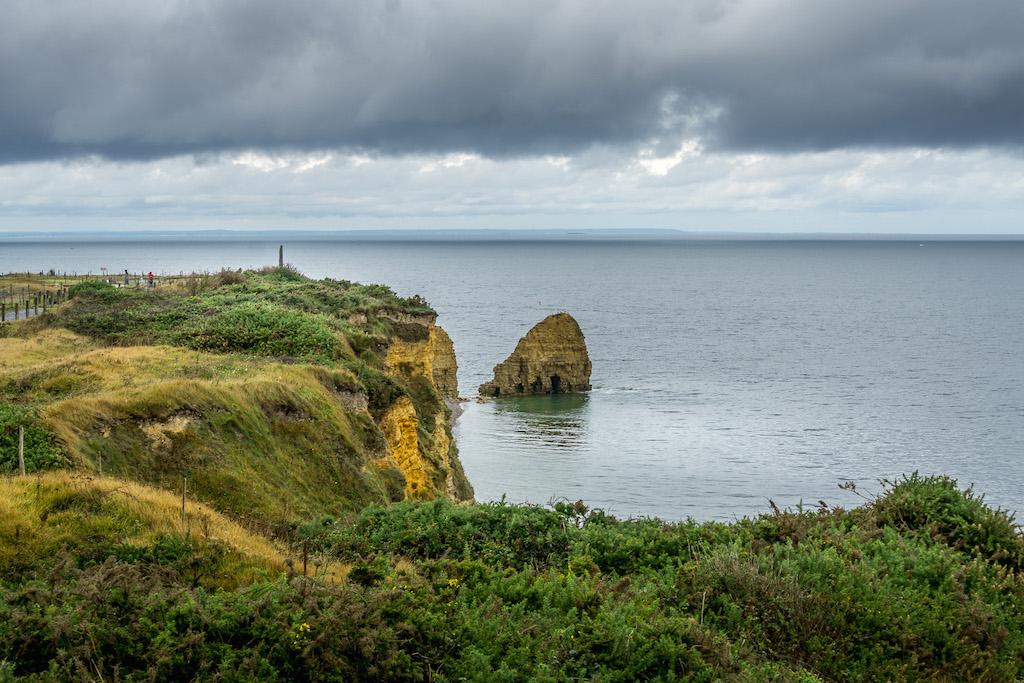
FAQ: How To Visit The D-Day Beaches In Normandy
How to visit the d-day beaches in normandy france: by car.
Although I did not visit the D-Day Beaches in Normandy by car, I know in my traveller’s heart that this is the best way to tour the Normandy beaches, especially if you have plenty of time. This allows you to choose which beaches, memorials, graveyards and monuments to visit. It allows you to go at your own pace and stay longer when you want to. It opens the avenue to visiting small towns that have photographs of the Liberation of France hanging on their doorways and along their streets. Rent a car.
Pro Travel Tip : There are more car rental agencies available in Caen than in Bayeux.
Rent your car in France for the best way to visit the D-Day Beaches.
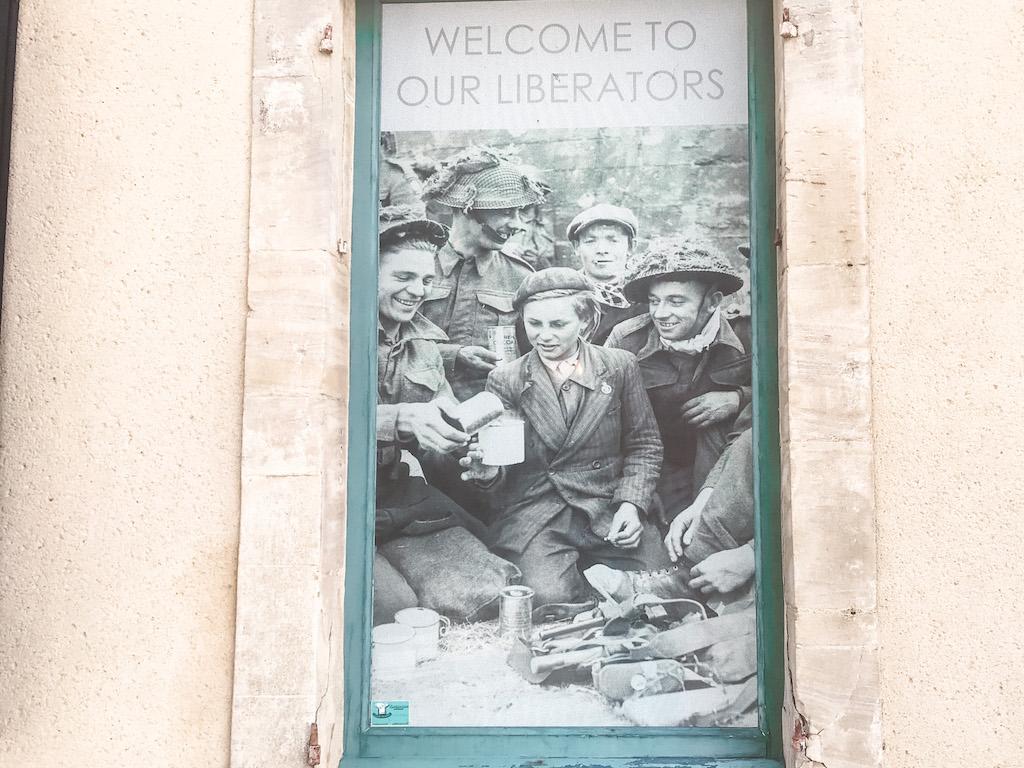
Visiting The D-Day Beaches In Normandy France: By Guided Tour
I arrived in Bayeux after having done some research on car rentals, guided tours, and buses. It was September in the year of COVID-19 and tourism was at an all-time low. I booked a small group tour with Gold Beach Company .
The advantage of taking a tour is, of course, the guide. My guide, Adeline, was a local history buff and knew how to make the tour engaging by telling stories and facts about D-Day and the D-day beaches. The D-Day sites are spread out over an extensive area, making a local guide invaluable in making the most of your time. It was worth every cent.
Pro Travel Tip : Many guided tours pick up in Bayeux.
Suggested Tours:
Normandy Beaches: From Paris – a full-day tour including lunch and From Paris – a full-day small group tou r
From Bayeux – American D-Day sites (4 to 8 hours)
From Bayeux- Canadian D-Day sites
How To Visit The D-Day Beaches In Normandy: By Local Bus
On this trip of mine through Normandy, I relied on the local buses and trains. But, the buses do not run very regularly, especially in the off-season to the D-Day sites. If you have a lot of time, I think it would be doable but you would have to pay very close attention to the schedules.
Where Is The Best Base For Visiting The D-Day Beaches In Normandy?
Both Bayeux (population of approximately 13 000) and Caen (population of approximately 106 000) make excellent bases for visiting the D-Day Beaches. Both cities are accessible by train from Paris. Getting to Bayeux involves one change in Caen. Book my train ticket
Hotels To Stay At In Caen and Bayeux:
Looking for a hotel? Check hotels in Caen here . Check hotels in Bayeux here . I stayed very close to the Bayeux cathedral in this bed and breakfast .
Read More: Here is my full article on what to see in Bayeux France.
Read More: If you are staying in Bayeux, be sure to visit the famous Bayeux Tapestry, almost 1000 years old. Here are some fascinating facts about it .
How Long Is Needed To Visit The D-Day Beaches In Normandy?
This, of course, is a personal preference. I only had one half-day and can honestly admit that it was a perfect introduction but left me wanting more. More stories. A chance to see additional sites. More photographs. A deeper understanding of this monumental event. More reflection time.
Planning Your Trip to Normandy?
Book your airline tickets with my favourite platform, Skyscanner. Normandy is serviced by three international airports: Paris Charles de Gaulle, Paris Orly, and Nantes.
Reserve train tickets to get from Paris to Caen or Bayeux.
A Few Facts About The Invasion Of Normandy
Operation Overlord was the name given to the overall plan for the Allied invasion of Normandy during World War II. It included both land and air components. Its primary objective was to establish a foothold on the continent and begin the liberation of Western Europe from German occupation.
Operation Neptune was specifically the naval component of the invasion. It involved the transportation of troops and supplies across the English Channel to the beaches of Normandy. The success of Operation Neptune was critical to the success of Operation Overlord, as it was the means by which the Allied forces were able to land on the beaches and establish a beachhead.
On June 6, 1944, the Allied Expeditionary Force, led by General Dwight D. Eisenhower, landed along the French coastline of Normandy in what was and still remains the largest seaborne invasion in history.
Critical Invasion Before The D Day Landings
The 82nd Airborne Division was a key unit in the Allied invasion of Normandy during World War II. On the night of June 5, 1944, more than 13,000 paratroopers from the division were dropped behind enemy lines in Normandy, with the objective of securing key bridges and disrupting German defences.
The mission was highly dangerous, as the paratroopers faced intense anti-aircraft fire, and many were dropped far from their intended landing zones. Despite these challenges, the 82nd Airborne Division was able to successfully complete their mission, with some units even capturing key targets such as the town of Sainte-Mère Eglise and La Fière bridge.
The Normandy Landing Beaches
The Allied troops landed at five different beaches along a 50-mile stretch on the Normandy shores. The beaches were all given a code name for the invasion and those names are still used today. The Americans landed at Utah Beach and Omaha Beach. The British landed at Gold Beach and Sword Beach and the Canadians landed at Juno Beach. The Normandy invasion beaches from west to east are Utah, Omaha, Gold, Juno, and Sword.
Read More | How The French Celebrate Armistice Day on November 11 each year.
Pointe du Hoc, Normandy France
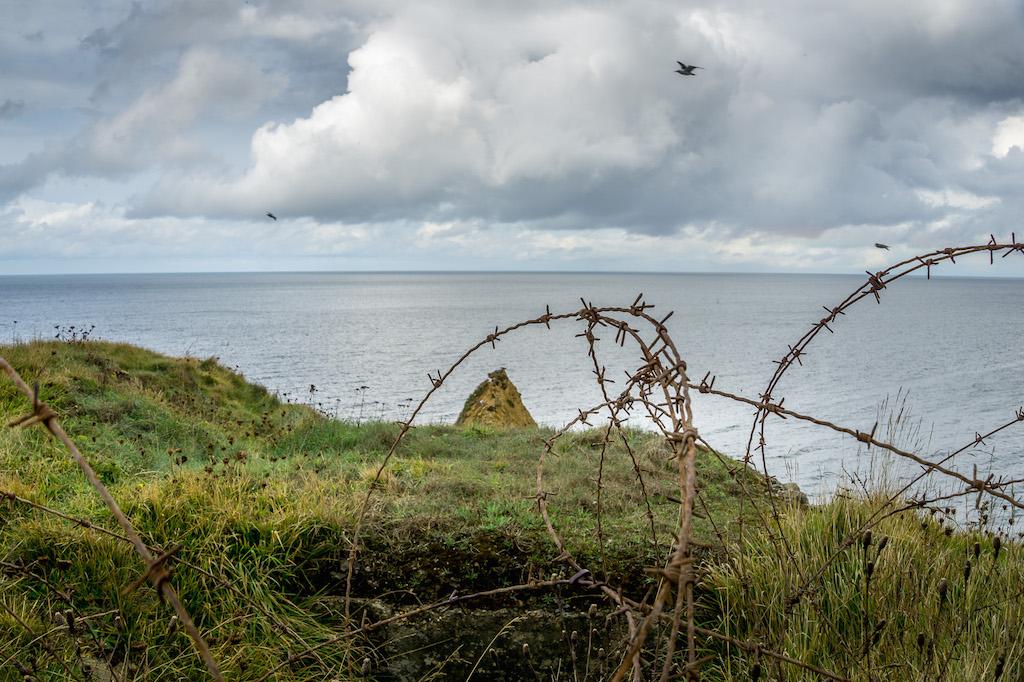
The first stop on our tour of D-Day beaches in Normandy was Pointe du Hoc. The deep craters in the landscape where bombs fell and the remaining German concrete bunkers make an immediate impression.
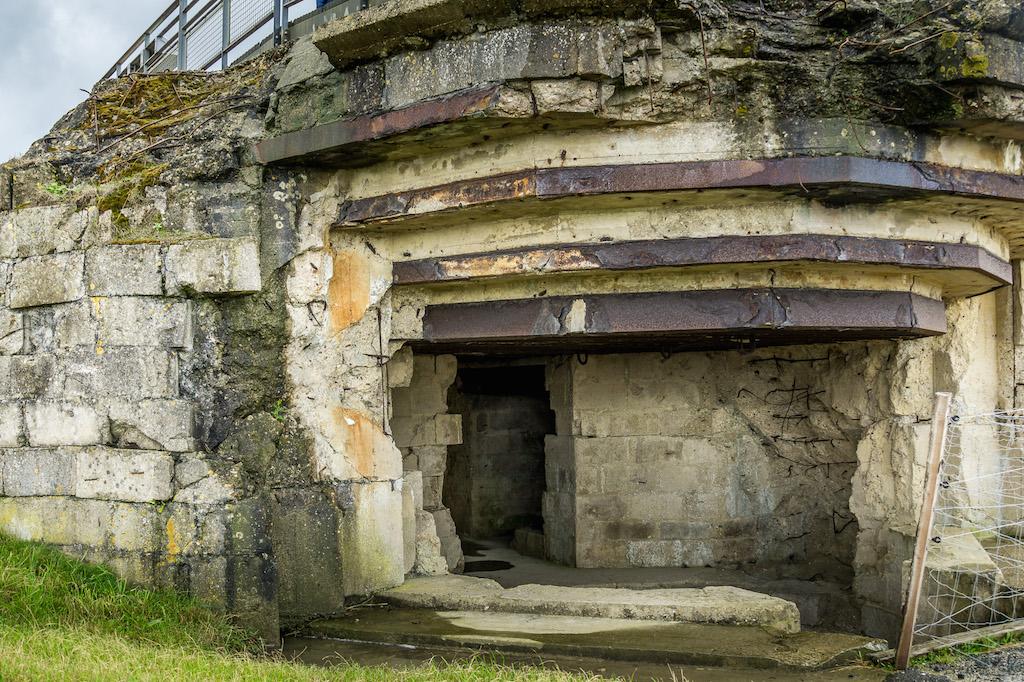
Here, on this bluff jutting into the sea between the D-Day beaches of Utah and Omaha, the 2nd Ranger Battalion soldiers carried out a plan that resulted in a terribly high cost of lives.
Over the course of three days, June 6, 7, and 8 1944, the Commandoes scaled the 100-foot cliffs with a mission to disable the German guns atop that could easily fire on Utah and Omaha Beaches. The Germans had already moved the guns further inland. The Rangers eventually found and destroyed the artillery.
The casualties were high. And after starting with 225 soldiers, only 90 remained standing.
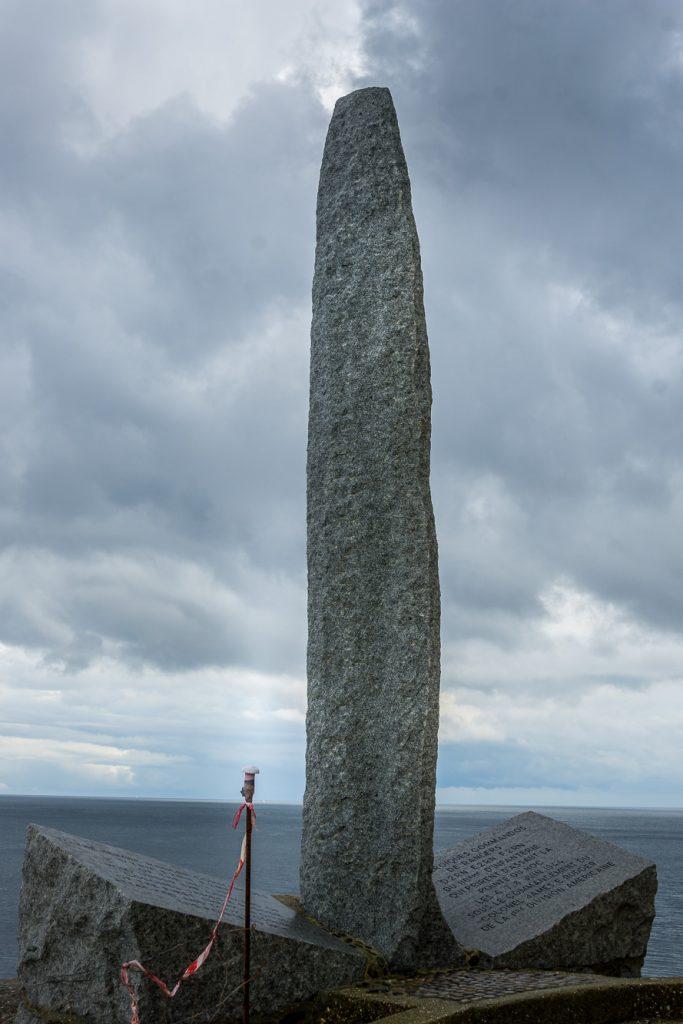
The Memorial at Pointe du Hoc: To the Heroic Rangers Commandoes D2RN E2Rn F2RN of the 46th INF who under the Command of Colonel James E. Rudder of the First American Division attacked and took possession of the Pointe du Hoc.
The United States: Utah Beach And Omaha Beach
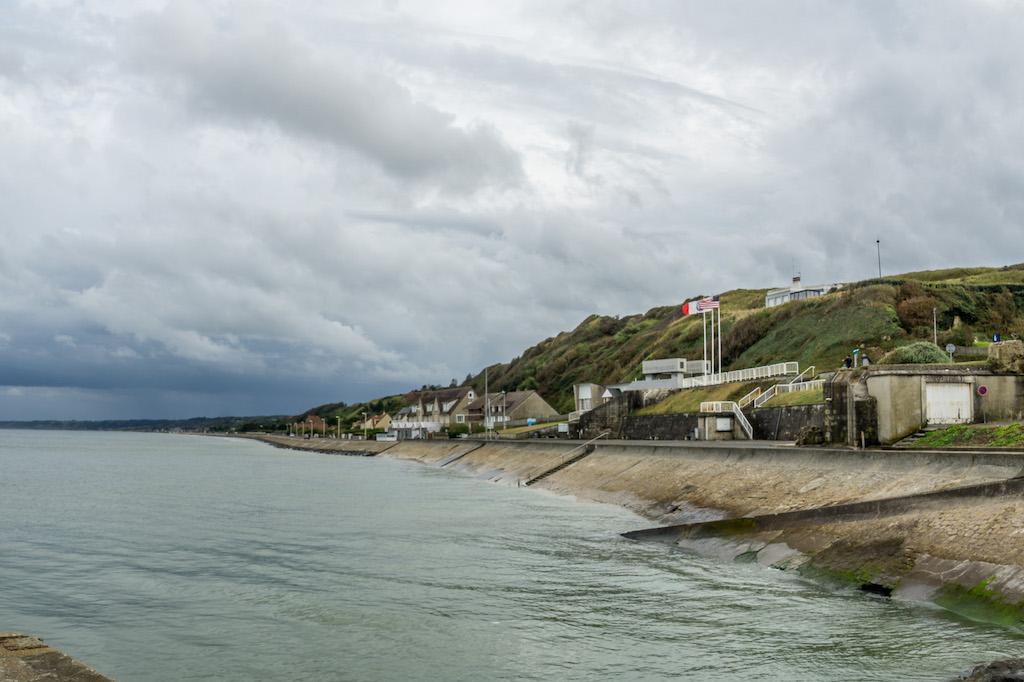
The 4th Infantry Division played a crucial role in the Allied invasion of Normandy during World War II. On June 6, 1944, the division was tasked with landing on Utah Beach. Despite facing heavy resistance from German troops, the 4th Infantry Division was able to secure the beachhead and begin their advance inland. The 4th Infantry Division’s actions at Utah Beach were a significant turning point in the war.
Of the five D-Day Beaches in Normandy, Omaha Beach was the bloodiest of all the landings. Standing on the beach under the bluffs it is hard to fully imagine what went on that Tuesday morning so many years ago.
I try to feel what it would be like to land in the water with my gun and hear German guns shooting down all around. I try to understand the sensation of my fellow soldiers dropping beside me, in the water, on the shore.
Looking up at the cliffs, I imagine a hail of German bullets, bombs and artillery raining down on the young American soldiers.
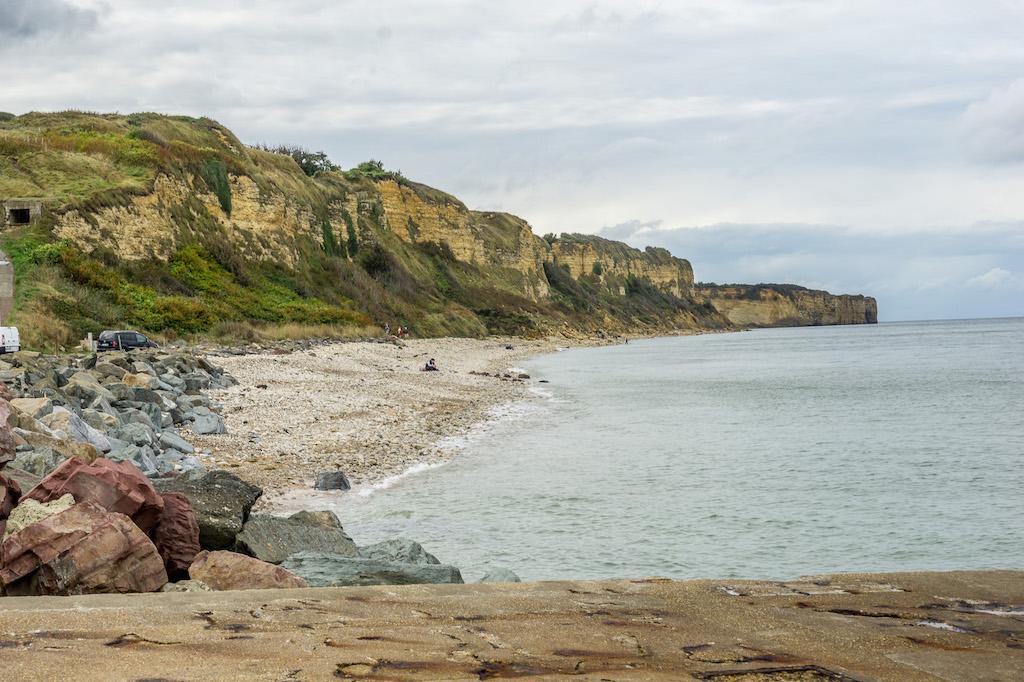
I know what I sense is a mere fraction of the reality.
But it isn’t hard to be in awe of the courage and dedication that each young soldier brought to the battlefield. It isn’t hard to imagine the fear and bravado all entangled. It isn’t hard to imagine the sea turning bright red. My heart stands still.
D-Day Beaches Itinerary: The Juno Beach Centre honours the 45 000 Canadians who lost their lives in WWII. Located in the small town of Courseulles-sur-Mer, it is a War Museum and Cultural Centre.
Visiting D-Day Beaches In Normandy: Les Braves
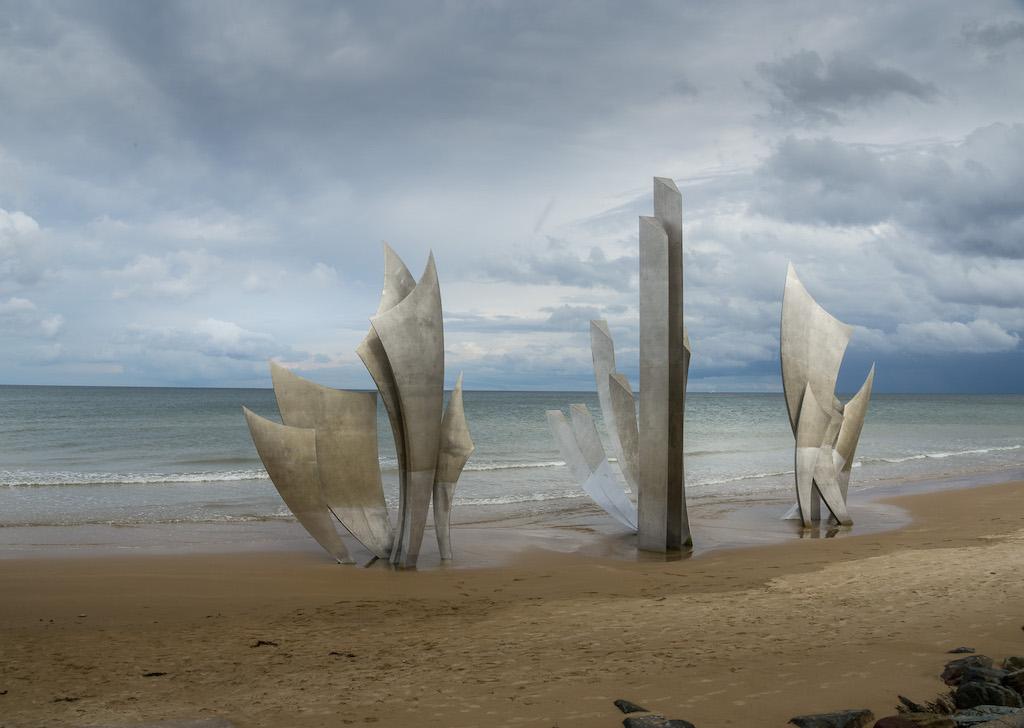
Our van was scooting past this memorial which is a little further down Omaha beach than where we had initially stopped. I had to ask the guide to stop.
As this monument, Les Braves rises from the sea, its impact is powerful. Standing on the shore where thousands of soldiers arrived to meet their death and the seas were cherry red with their blood, this monument demands something of the visitor. It is not a drive-by, nor a five-minute stop to check off the list. It requires one to stand in silence against the crashing waves and imagine what transpired here. It’s a time to let gratitude flow through you.
This Omaha Beach Memorial, created by Anilore Banon is called Les Braves. He is quoted as saying “I created this sculpture to honour the courage of these men: Sons, husbands, and fathers who endangered and often sacrificed their lives in the hope of freeing the French people.”
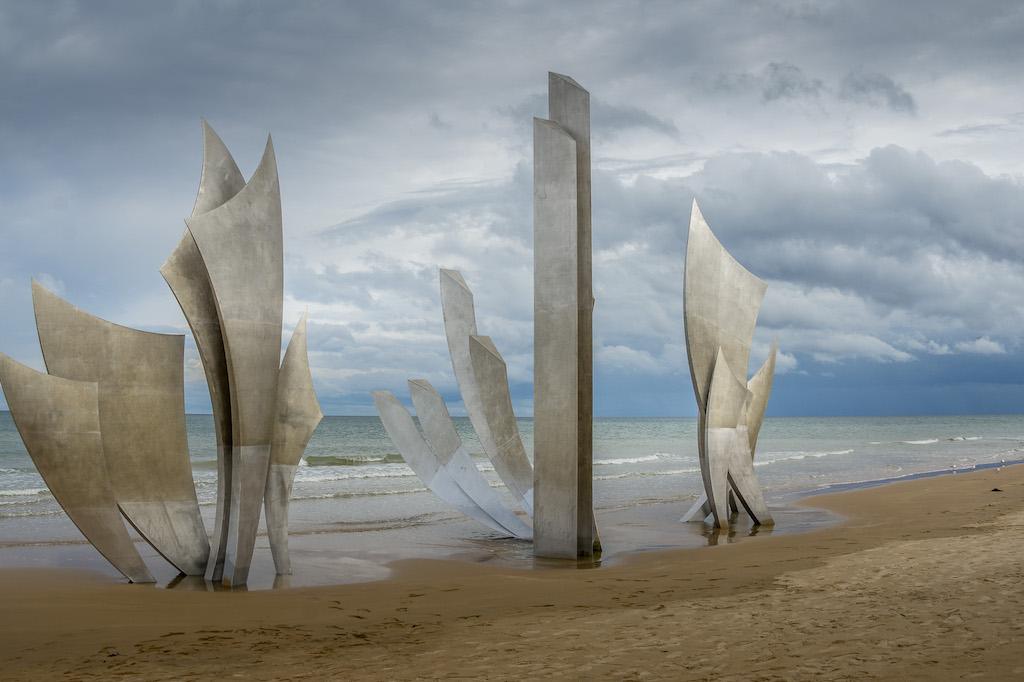
The sculpture is in three elements: The Wings of Hope to remind us that together it is always possible to change the future.
Rise, Freedom! Honouring those who rose against barbarity to help us remain standing strong against all forms of inhumanity.
The Wings of Fraternity to remember this surge of brotherhood reminding us of our responsibility towards others as well as ourselves. On June 6, 1944, these men were more than soldiers, they were our brothers.
Read More : Here are 13 other fabulous day trips from Paris .
The Normandy American Cemetery And Memorial
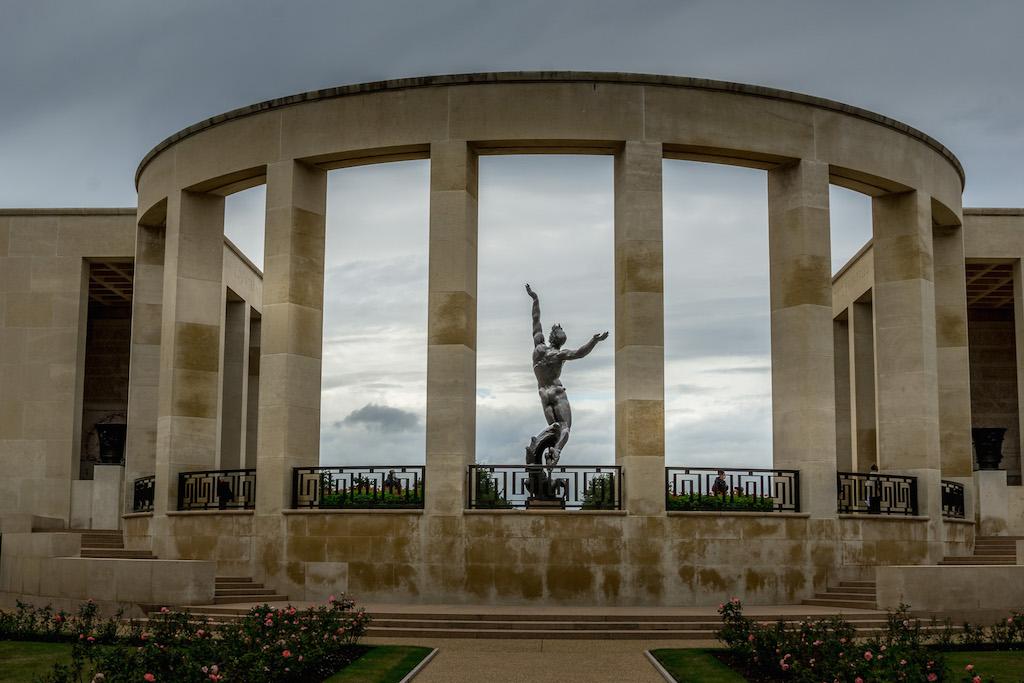
I had no idea what to expect.
The glorious statue, Spirit of American Youth, invites you to enter. And there, 1557 engraved names of soldiers missing in action encircle you. Those that have a rosette beside their name have since been found.
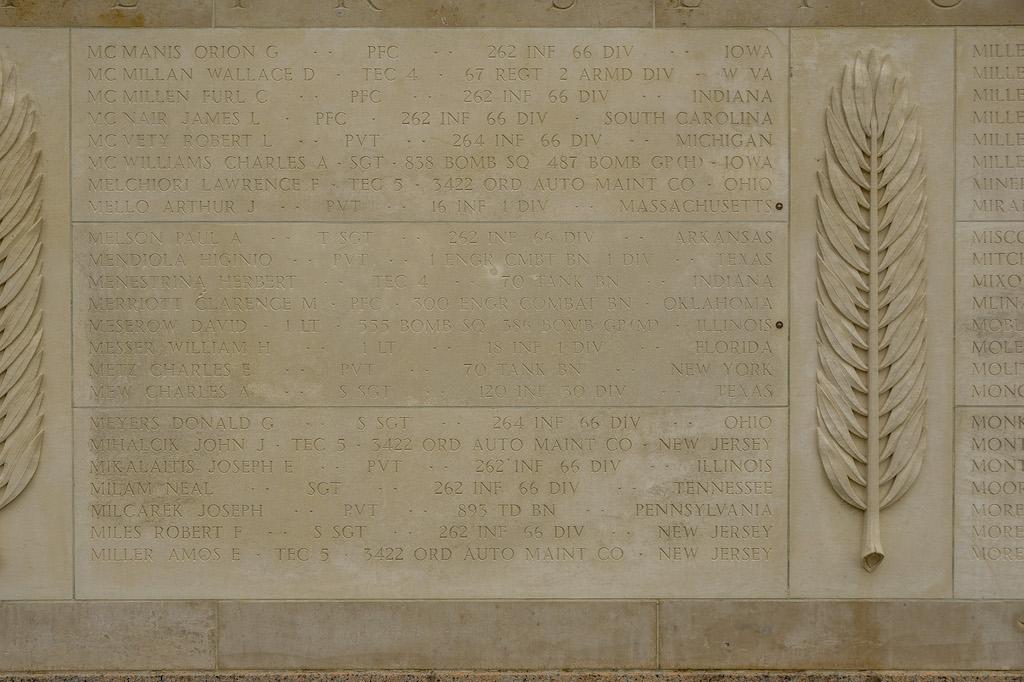
Ahead there are 9387 white headstones that stretch as far as the eye can see between the forest and the English Channel, perched over Omaha Beach.
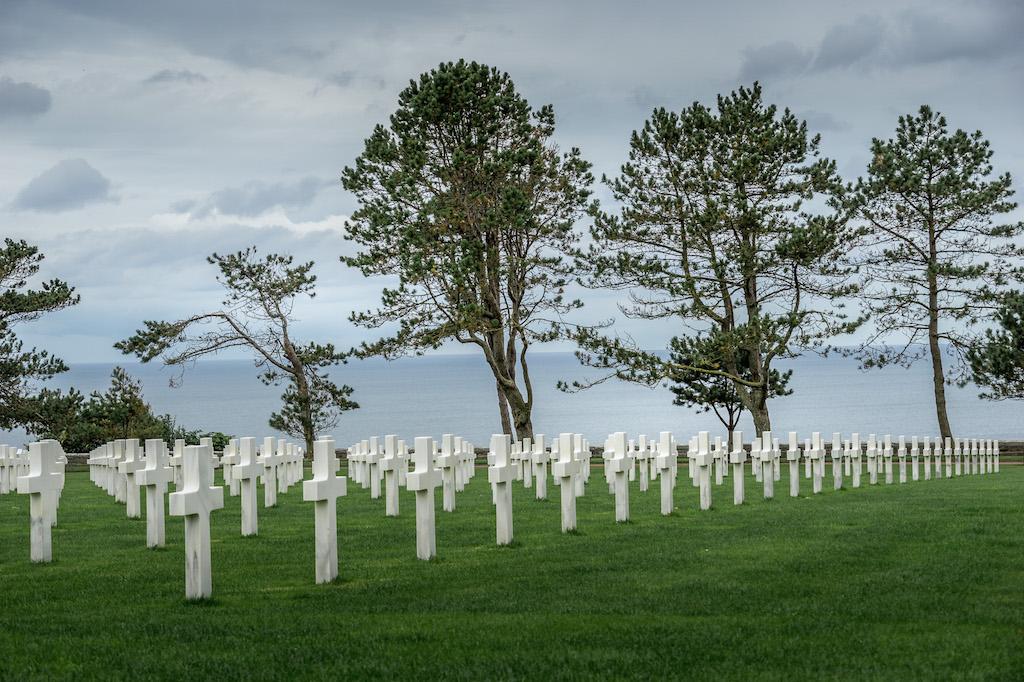
As a mother, as a sister, as a human being, it is impossible not to be impacted as standing amidst the rows of crosses.
The Artificial Harbour Near Arromanches-les-Bains
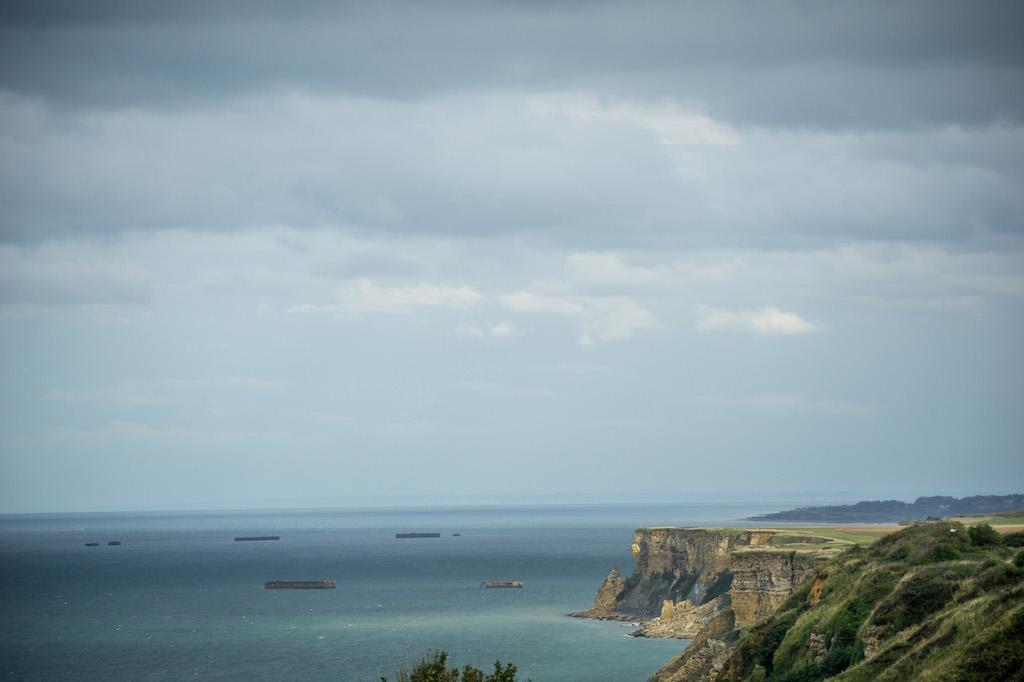
From a distance, our group viewed and listened to the ingenious plan of Sir Winston Churchill to create two fake harbours that also acted as a breakwater so that Allied troops could bring reinforcements and equipment to France.
On the morning of June 6, 1944, huge concrete chambers were towed towards the Normandy coast and then sunk into place creating Mulberry Harbour. German pilots saw the concrete chambers heading to France but could not figure out what they were seeing.
The concrete blocks still remain today and can be seen off the shores of Arromanches-les-Bains. The D-Day Museum here goes into detail about creating the Harbour, also known as Port Winston.
I went to the D-Day Beaches in Normandy to pay my respects, to stand and feel where recent history took place and to appreciate the liberties and freedom that I have today. I hope you enjoy visiting the D-Day Beaches in France as much as I did.
Until next time,

Liberté – Liberty: A Poem By Eluard
“Liberté” written in 1942 during the German occupation by French poet Paul Eluard:
an excerpt:
See the full poem here .
Lest We Forget…

More Travel Info
Planning your itinerary for normandy france.
You might also like this post, 19 Wonderful Things to do in Normandy .
There are also many individual articles on specific places to help you plan your trip to this incredible region of France.
Honfleur: An Authentic Taste of Normandy
The Magnificent Soaring Cliffs of Etretat
Deauville and Trouville-sur-Mer: A Seaside Day Trip From Paris
How To Eat Oysters Like the French
Visiting Mont-Saint-Michel: A Timeless Beauty
Movies About The D-Day Beaches in Normandy France were :
The longest day (1962).
Our guide recommended this movie as the most realistic account of the landing at Omaha Beach. I watched it recently and would say that for those of you who haven’t seen it, it is a must. Watch it before your visit, or after as I did or simply to get a glimpse into June 6, 1944.
Saving Private Ryan (1998)
Overlord (1975), like this post pin it.
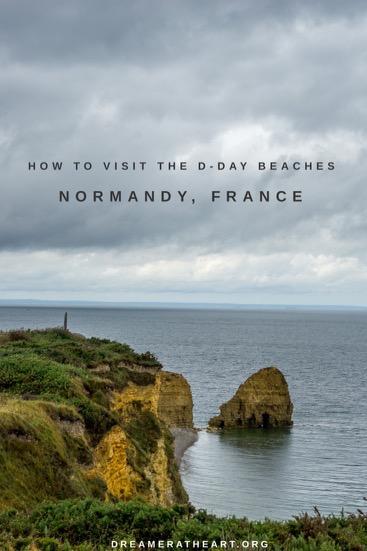
You might also like...

Alison Browne
Creator and Founder of Dreamer at Heart Alison, a Francophile from a young age, is following a long-held dream and has been living in Paris since 2020. Her passion for uncovering Paris and discovering the regions of France has resulted in an expertise about France that she loves to share in her articles. Also a solo traveller, Alison shares her experiences of solo travel to many corners of the world. Alison helps over 65000 readers a month plan their trips.
Reader Interactions
Leave a reply cancel reply.
Your email address will not be published. Required fields are marked *
Save my name, email, and website in this browser for the next time I comment.
Have Paris travel questions? France? Solo travel?
Contact me at

Dreamer at Heart is a participant in the Amazon Services LLC Associates Program, an affiliate advertising program designed to provide a means for sites to earn advertising fees by advertising and linking to Amazon.ca and affiliated sites. Amazon and the Amazon logo are trademarks of Amazon.com, Inc, or its affiliates.


IMAGES
VIDEO
COMMENTS
Beautiful landscapes, intense history, and a sobering dose of the realities of war all blend to make a worthwhile trip away from the Parisian crowds. The good news is it won't break the bank if you plan appropriately. Tips for visiting the Beaches of Normandy. Here are a few ways to save time and money on a trip to these iconic sites. 1.
Morning: Utah beach. 55km from Cherbourg or 60km from Bayeux. We start our Normandy D-Day itinerary at the most western of the landing beaches - Utah. Landed by the Americans, this was one of the more successful operations. If you're coming from the ferry or starting in Bayeaux it should be less than an hour to get here.
A 1 day tour from Paris of the Normandy D-Day landing beaches, which includes transport, museum entry and guide. A 2-day tour of Normandy, Saint Malo and Mont St Michel from Paris, which includes transport, overnight 4* accommodation, some meals, a guide, and entrance fees. This would be our recommended option from Paris if you have the time as ...
Normandy is one of the most famous destinations in France and in the world, most notably for its culture, architecture, picture-perfect coastline, historic D-Day Landing Beaches, delicious food and welcoming atmosphere. Whether you're visiting Normandy to holiday, work or study, we have all the information you need to plan the perfect trip ...
How many days to visit Normandy? Normandy is more than a day trip from Paris. We recommend 3 to 5 days: 3 days if you're just going for the Normandy beaches and 5 days if you want to see some of the cultural sites as well. I know there are some guides out there that talk about visiting Mont St. Michel, Bayeux and the Normandy Beaches all in 3 ...
The event took place on 6th June 1944, and marked a turning point in one of the most gruesome conflicts in history. D-Day marked the beginning of the Allied Invasion of Normandy, and it continued until 24th July 1944. On 6th June 1944, the beaches of Normandy witnessed a massive amphibious assault led by the British, Canadian, American, and ...
When planning to visit these historical sites, logistics is the key, especially if you plan to get there during an Anniversary of the D-Day landings, like the one we will have this year, the 80th Anniversary of D-Day. ... Experience a personalized and exclusive day trip to the historic Normandy landing beaches of World War II, departing from ...
Visit the D-Day landing beaches in Normandy : Map + tips The 5 landing beaches - map and introduction. Operation Overlord, a.k.a. the Normandy invasion, began on June 6, 1944. 5 main areas were strategically chosen by the Allies on the Normandy coast. They cover a section of more than 80km (50 miles). Code names have been given:
Bayeux Highlights. Rue Saint-Jean, Bayeux — Normandy region of France. Bayeux Tapestry — This beautiful 11th-century 70-yard long tapestry is a must-see attraction while in Bayeux. It depicts William the Conqueror's story as duke and king, through battles, victories and other dramas of the Middle Ages.
Planning ahead will help you optimize your itinerary and ensure you get the most out of this impactful experience. Context offers a Full-Day D-Day and Normandy Beaches Tour so you can explore key Normandy landmarks, including Normandy Landing Beaches, Pointe du Hoc, Omaha Beach, The Normandy American Cemetery and Memorial, and the Mulberry ...
The D-Day beaches of Normandy were the site of intense fighting. Trace the footsteps of the fallen in our guide to visiting Normandy beaches. ... Normandy is likely to be very busy at times like this, so take that into account when planning a trip to Normandy. For cooler weather and less crowds, try visiting in April/May or September/August. ...
Planning your trip to Normandy? Below are some places to stay, things to do, and more. Best Tours and Experiences in Normandy. Bayeux: American D-Day Sites in Normandy Half-Day Tour; Bayeux City Tour (2 hour tour of historic sights) Normandy Beaches Half-Day Tour; From Paris: Normandy D-Day Beaches (day trip option if short on time)
A thorough tour of the Normandy D-Day beaches and other sites encompasses about 50 miles of territory. It stretches from the city of Caen in the east to Utah Beach further west. As you travel along the usual route, you can imagine troops and tanks filling the now-quiet countryside with noise and chaos. Much of your visit to D-Day sites will be ...
4. Omaha Beach. It goes without saying that Omaha Beach can't be missed at the Normandy beaches. The Allied forces decided to call the beach landing part of the attack Operation Neptune. They designated five beaches as landing zones, and Canadian and British soldiers landed at Juno, Gold, and Sword beaches.
If you're planning a Normandy trip I'd say that a good time to take in the sites is around 3 or 4 days. This would allow you to really see all the beaches, plenty of museums and other sites around the area and for you to take in the larger towns such as Bayeaux and Caen.
What's in this article. 4 day northern France itinerary - Rouen & Normandy's classic coast. Day 1 - Rouen: Medieval city with half timbered houses. Day 2 - Picturesque harbour town Honfleur. Day 3 - Trouville by the sea. Day 4 - Étretat - the spectacular Normandy coastline. Tips for visiting Normandy with kids.
Located along the northwest coast of France, planning the perfect 3, 4 or 5-day Normandy road trip itinerary is an excellent way to experience this diverse region. Boasting picturesque countryside, charming coastal towns, and iconic landmarks, this is an excellent corner of France to explore. Whether you're interested in the history of the D ...
We are already planning our next trip! Reply. Chris says. January 28, 2018 at 9:44 pm. I agree! I still need to see St. Malo, Mont St. Michele, Honfleur and so much more. ... My wife and I are planning a trip to Bayeux and Normandy beaches. I welled up just thinking about standing on Omaha beach and then visiting the the final resting place of ...
The site of the 1944 D-Day invasion, Normandy's beaches, saw a death toll in the thousands but also a changing tide in World War II. Its military cemeteries, memorial museums and the D-Day landing ...
How to Day Trip from Paris to Normandy. 1. First take the train from Paris into Bayeux or Caen. These are the two historic cities nearest to the Normandy beaches. Both are easily accessible by train from Paris but the one way train ride takes roughly 2.5 hours. I cover how to take the train in more depth, below.
Our Normandy, France Itinerary - The Summary: Day One:We journeyed back to the 6th June 1944, D-Day during World War Two. Our itinerary started with a brief visit to the small Overlord museum, providing context on the invasion and its planning. We visited some of the key American D-Day sites including Omaha Beach, the American Cemetery, and the ...
Sweeping coastlines, half-timbered towns, and thatched roofs decorate the rolling green hills of Normandy. Despite the peacefulness you sense today, the region's history is filled with war, from Viking invasions to William the Conqueror, from Joan of Arc, and of course the 1944 battles of D-Day. The rugged, rainy Norman coast harbors wartime bunkers and enchanting fishing villages like ...
The United States: Utah Beach And Omaha Beach. Omaha Beach at high tide. It looks very similar to June 6, 1944. The 4th Infantry Division played a crucial role in the Allied invasion of Normandy during World War II. On June 6, 1944, the division was tasked with landing on Utah Beach.
It was here on June 6, 1944, that American paratroopers floated down behind German lines in the early-morning darkness. Many of them landed far from their intended target, but enough organized ...